

How To Sail a Catamaran Upwind or Downwind (Complete Guide)
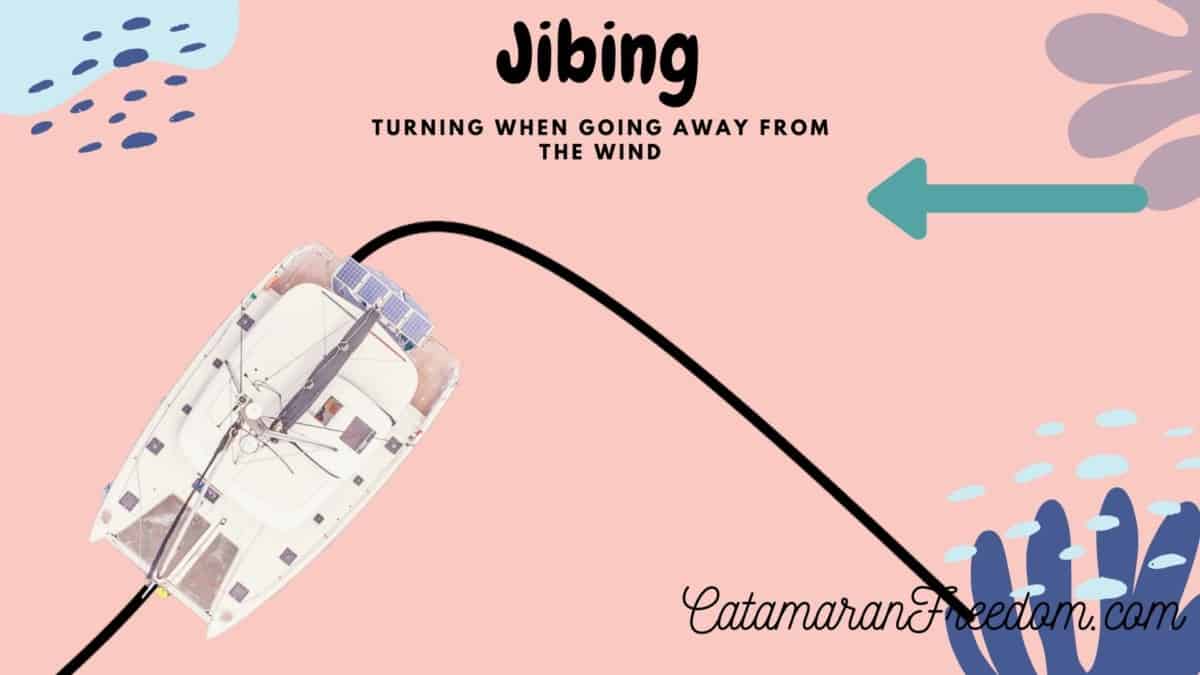
As an Amazon Associate, we earn from qualifying purchases. We may also earn commissions if you purchase products from other retailers after clicking on a link from our site.
Catamarans are the perfect backdrop to a relaxing fishing excursion, with sails in the wind as you reel in 50-pound striped bass. But when the gusts pick up and shift directions, you’ll find yourself weathering uncharted territory where reefing and speed are unlike a classic monohull. Sailing a catamaran upwind and downwind requires a skill set much different from the classic one hulled sailing.
To sail a catamaran upwind, maintain high speeds, center the mainsheet, limit angles to 45-60°, lose unnecessary weight, upgrade to Kevlar sails and daggerboards. To sail a catamaran downwind, maintain 160-170°, use asymmetrical spinnakers, reef when winds exceed 15 knots, and jibe.
Downwind gusts can help a catamaran surf down waves, something that is extremely exciting. However, facing those dreaded upwind breezes (especially without daggerboards) can signal the end of a soothing Mediterranian adventure. To learn how to sail a catamaran upwind or downwind, read on!
Table of Contents
How Sailing a Catamaran Is Different Than Monohulls
Multihull vessels like catamarans respond very differently to rough surfs, gusting winds, and shallow waters. If you’re still questioning, “What’s the difference?” here’s your answer.
Compared to classic monohull boats, catamarans are:
- More stable — at sail and when anchored — and less likely to heel or rock from side to side.
- Less responsive to waves and winds (detecting these requires keen observation skills).
- Likely to struggle when sailing into the wind.
- Harder to tack (high speeds are essential to avoid losing momentum)
Traditional yacht enthusiasts quickly learn that sailing a catamaran is smoother, though stiff headwinds and choppy surf are more challenging to overcome. Learning to master upwind and downwind catamaran sailing is essential to get the most out of your trip
If there’s one debate looming over the sailing community, it’s the age-old catamaran versus monohull discussion.
What is the difference b e tween cats and monos?
The UPWIND Catamaran Sailing Guide
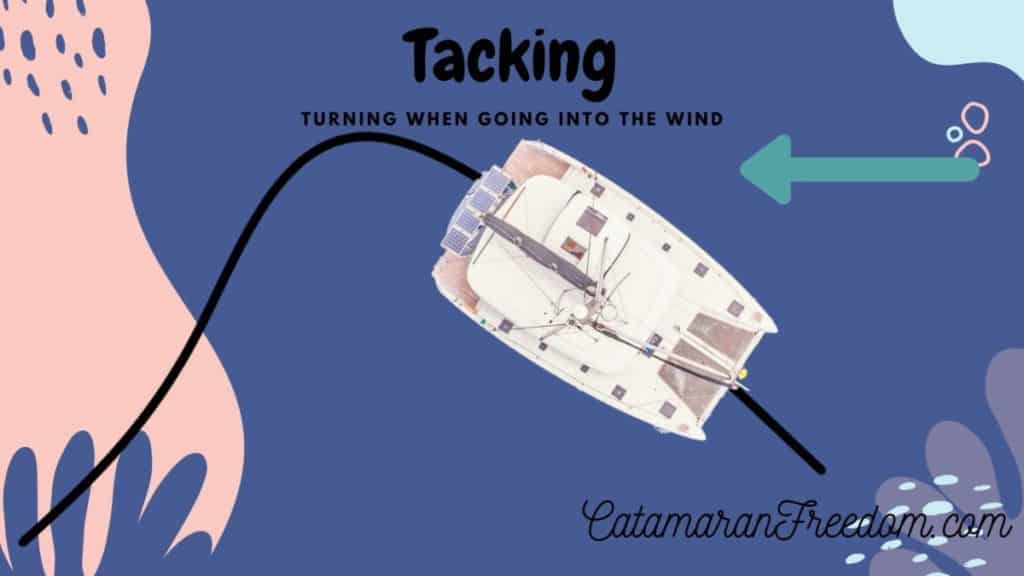
Sailing upwind means you’re cruising your catamaran toward the wind (i.e., Traveling east against westward-blowing gusts). This added wind resistance makes it more challenging to reach your destination swiftly and safely, as upwind journeys could come with:
- Relentless sail luffing (fluttering like a bedsheet on a clothesline)
- Slowed speeds and VMG (velocity made good)
- Deep-digging bows in waves
- Bridge deck slamming
Preparing for an upwind journey means taking the path of least resistance and the “long way home.” To survive your next upwind sail unscathed, follow these tips:
Maintain High Speeds
Thirty-knot gusts at-sea, high speeds, and a Leopard 44 might sound like a recipe for disaster. But a catamaran’s multihull design allows for lower capsize risks and less heeling in rougher conditions. It’s far gentler on the vessel to maintain momentum than to build throttle against heavy winds.
Sailing a catamaran upwind requires sail, chart plotter, and daggerboard monitoring. The video below discusses upwind sailing tips as your catamaran’s bow faces 20-knot gusts.
Limit Angles to 45–60°
A straight line is undoubtedly the shortest pathway to your on-shore destination, but sailing your catamaran directly into the wind will land you in the dreaded “no-go zone.” That is, sailing into 15-knot wind gusts directly, draining all forward momentum (unless motoring), and being unable to steer responsively.
The point of sail “sweet spot” for catamarans sailing upwind is between 45 and 60°. This tight range will keep the bow headed in the right direction — toward a particular cove or dock — without cutting throttle (too direct) or over-inflating the sails (too perpendicular).
An onboard flag can help you accurately detect your current point of sail (there are of course electronic aids as well). You should adjust the sails intentionally to ensure the perfect angle:
- Slowly let out your sail.
- Wait for the telltale to begin luffing (flapping in the wind).
- Gently tug it back until the telltale flapping stops.
Upgrade to Kevlar Sails
Catamarans are impressively resistant to heeling where dainty monohulls might capsize. But instead of “giving” with the wind, a catamaran’s classic polyester sails will resist 30+ knot gusts almost entirely. Even the highest-tenacity Dacron sailcloths will develop wear and tear, performance-reducing distortions, or irreversible breakage in heavy winds.
Investing in heavy-duty Kevlar sails can create stiffer and more damage-proof sails that can better handle upwind excursions. Upgraded catamaran sail cloths can help you travel a crisper pathway at a close-hauled 45° without overcompensating at the wheel.
Select a Daggerboard Catamaran
Daggerboards are retractable vertical keels attached to a catamaran’s underbelly. These large, below-deck protrusions can prevent or limit any leeway in exceptionally windy conditions.
Daggerboards vs Centerboards explained!
In other words, daggerboards will keep your catamaran from drifting with the wind or falling off course. The $30,000 higher price tag is undoubtedly off-putting, especially when proper tacking technique might render them useless. But the benefits are substantial:
- Sailing 1-2 knots faster than a standard keeled catamaran
- Traveling 5-7° closer to the no-go zone
- Reaching your upwind destination quicker and with less dramatic tacking
Catamarans with daggerboards installed are more reliable and accurate when traveling upwind. But these built-in keels require proper care to prevent grounding or lurching into a reef. Until your sea voyages bring you upwind, keep your daggerboards raised.
Clean Hulls
Aside from trimming the sails and staying in the close-hauled zone, there’s only so much you can do onboard to better tackle an upwind voyage. But what about beneath the water’s surface? A dirty underside can wreak havoc on your catamaran’s all-around performance — cutting RPM by 1,000, draining fuel efficiency, and slashing your maximum speed by several kts.
Keeping your catamaran hulls free of barnacles, grime, and fouling can make your upwind travels far less treacherous. Revive upwind sailing potential by:
- Spraying the bottom clean with an on-land hose
- Scrubbing the slimy waterline with a soft brush or sponge
- Dislodging caked-on algae with a plastic putty knife
- Applying a fresh coat of antifouling paint
Scrub your catamaran’s underbelly clean at least four times a year, though monthly is preferred for maximum performance. You’ll quickly notice a swifter, cleaner, and smoother journey the next time you take your catamaran up the coast.
Trim the Sails & Center the Mainsheet
“Trimming” the sails is a beginner’s catamaran cruising skill designed to improve speed and better catch the breeze. By changing the angle of the sails and adjusting line tension, you can evade sail luffing and add several knots to your voyage — especially upwind. It takes practice to adapt your sails to the wind speed and direction, so here are the catamaran sail trimming basics:
- Lock the mainsheet and position the boom so that it’s somewhat leeward (further away from the wind gusts).
- As you veer away from the wind, slightly ease the traveler and monitor the telltales.
- Start slowly easing the mainsheet when you’re on a beam or reaching (when the catamaran is at the right angle to the wind).
- Keep an eye on the telltales and watch for differences between leward and windward side (bluffing or flopping).
As you go through the classic trial and error process, don’t forget to keep the mainsheet centered — or as close to the center as possible. Otherwise, turning the winches in 18+ knot winds will require superhuman strength to get back on track, complicating your sail.
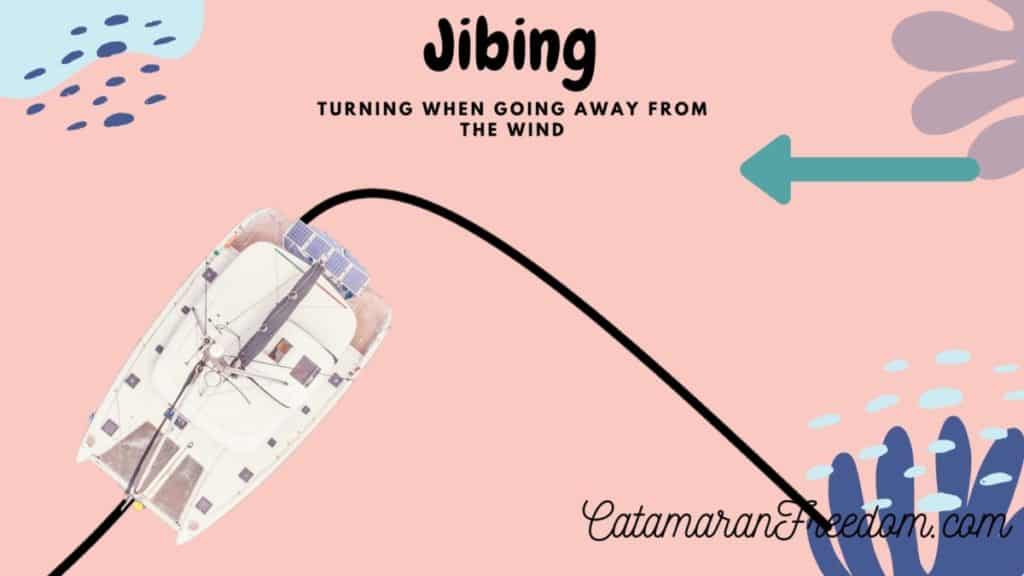
Steering clear of the no-go zone (straight into the wind) will keep your catamaran from stalling and your sails from flapping around and potentially increasing wear. But you’ll never arrive at your coordinates if you’re staying on a strict 45° path in one direction. This is where skilled catamaran sailors begin “tacking”, the art of turning your boat with the wind on your bows.
When you tack on a sailboat, you’re forcing the bows into the wind’s direction (no go zone). Tacking redirects the bow to the opposite 45° angle — from 3 o’clock to 9 o’clock — and creates a zig-zag formation or subtle 90° turns through the water. Proper tacking requires a skilled crew on larger catamarans but can be a solo pursuit. Here’s how to do this maneuver carefully:
- Start by sailing as close to the close-hauled territory as possible (within 40-45°).
- Choose a heading 90° away as your turn “destination.”
- Alert the crew to the tacking (if applicable).
- Slowly release the loaded jib sheet and begin pulling the lazy sheet inward.
- Steer the catamaran into the turn while maintaining speed (don’t speed up or slow down).
- Allow the sail to backfill to assist with the pivot.
- Release the jib sheet (watch your fingers, as the line releases quickly).
- Tighten the jib sheet on the opposite side and feel the wind start powering the boat.
Tacking is a challenging sailing concept to master. But it’s also the only way to sail upwind efficiently.
Turn On the Motor
A traditional, motor-free catamaran cruise can be soothing if there’s no destination in mind. However, the sails become inefficient against 15-knot winds when your preferred snorkeling spot is several miles directly into the wind. The best way to sail upwind is by turning to your catamaran’s twin diesel engines and hitting the throttle. Even cranking the engine to half-speed can ignite your speed by 1-2 knots and improve the course by up to 20°.
The DOWNWIND Catamaran Sailing Guide
Sailing downwind means you’re cruising in the same direction as the wind’s blowing (i.e., Journeying north alongside north-blowing winds). This extra momentum can generate higher speeds on a run, though the consequences of unpredictable downwind exist. Spinnakers becoming tangled around forestays or spinnaker collapse are looming concerns in high winds.
Downwind sailing is the catamaran sailors’ favorite direction, and thats why most people circumnavigating the globe is travelling with the tradewinds going west!
How to circumnavigate the world
Downwind trips are much more straightforward for novice sailors, but there are techniques for building speed and learning more about your boat. To better handle your next downwind sail like an expert, follow these tips
Use a Screecher or Asymmetrical Spinnakers
Spinnakers are a special type of sail ideal for downwind runs. Unlike a mainsail or jib that luffs in the wind, spinnakers inflate like a balloon and give maximum power at around 90-160° angles. These ultra-lightweight, colorful sailcloths come in two varieties: Asymmetrical and symmetrical. Most yachters attach asymmetrical spinnakers or screechers to their catamarans because they:
- Work well in close-hauls, beams, and broad reaches
- Boost speed by about 2 knots
- Resist damage in 25-knot downwind gusts
- Are quite versatile
The latest spinnaker tends to have more volume when tacked to the windward bow. These new designs allow them to catch more wind and pick up speed at nearly all deep, downwind angles (except directly at your aft).
Sailing a catamaran downwind isn’t quite as simple as easing the sails and cruising. The video below explains the catamaran difference when traversing the sea with the wind at your aft.
Choose the Right Angle
Sailing a catamaran directly downwind sounds like a decent strategy for picking up some momentum. But because catamarans travel faster with the wind at their sails, a less direct point of sail can maximize your velocity made good (VMG).
The proper point of sail for downward cruises is in the broad reach position — ideally between 160 and 170°, though up to 90° can be somewhat effective. This 10-20° off-center angle is slight but can boost your maximum speeds by a few knots.
Reef at 15 Knots
Though catamarans don’t heel or spill wind like monohull ships, the high wind pressure cues are more challenging to detect. Sailing behind 15 or even 20-knot gusts can overpower even the sturdiest sails when you jibe. Reducing your sail surface area and allowing more wind to flow through — reefing — will reduce speed(usually) and increase safety.
Always keep an eye on your anemometer while sailing downwind in windier conditions. Once it’s registering 15-20 knots, here’s what you should do:
- Reduce the mainsail’s pressure by loosening the mainsheet and repositioning the traveler leeward (away from the wind).
- Take the pressure off the boom vang.
- Lower the main halyard and hook reefing point #1 on the proper hook.
- Pull the reefing line manually (or with a winch).
- Put more tension back on the halyard and boom vang.
Time is of the essence while reefing downwind, and one reef might not be enough if you’re sailing into a squall. Be prepared for a second or third reef when winds measure 25 and 30 knots, respectively. If winds exceed 30 knots, remove the jib entirely and use the mainsail as you return to the marina.
These numbers above are general numbers and since cats don’t heel much it is very important to abide by the wind speed reefing table on your boat.
Why do catamarans capsize?
Jibe (Gybe)
Jibing (gybing) is the downwind version of tacking, meaning you’ll be heading off on another zig-zag 90° journey as you sail out of the bay. But unlike tacking, where you forced the ship’s bow toward the wind, now you’ll be guiding the boat’s stern away from the wind. Here’s how to jibe a catamaran safely and quickly:
- Make sure the traveler is in a center position (or close to center).
- Trim the sail to prevent the boom from swinging in mid-jibe.
- Angle the catamaran so you’re traveling a few degrees off from directly downwind.
- Choose a location in the distance that’s 90° from your current location.
- When the mainsheet feels lighter, bring the boom toward the ship’s center.
- Wait for the leech to rise (the sail’s rear edge).
- Release the mainsheet again.
While jibing can help you stay on course and pick up some speed, it comes with some risks. An uncontrolled boom can rapidly swing and crash into a crew member, cause unpredictable heeling, or damage the rig. Make sure all crew members are ready to jibe before beginning the process.
Reduce Speeds
The physics behind sailing is quite complicated and misconceptions about venturing downwind are common. Thanks to choppy waves (water resistance) and sails (lack of wind resistance), it’s impossible to sail downwind at faster speeds than the wind directly at your aft.
Sailing a catamaran upwind or downwind is more complicated than a calm, Caribbean sailing expedition. Prepare for your next windy escapade by:
- Checking the wind speed and direction via your local weather service
- Practicing reefing, tacking, and cruising skills in calmer conditions
- Experimenting with sail trims, headsail positions, and motor use
- Learning more about spinnakers, screechers, and gennakers
Every gust, knot, and reef will help you hone your catamaran sailing talents and better prepare for less predictable weather. Try to build your confidence and perfect your skills before exposing yourself to harsher conditions.
Owner of CatamaranFreedom.com. A minimalist that has lived in a caravan in Sweden, 35ft Monohull in the Bahamas, and right now in his self-built Van. He just started the next adventure, to circumnavigate the world on a Catamaran!
Leave a Reply Cancel reply
Your email address will not be published. Required fields are marked *
Save my name and email in this browser for the next time I comment.
Recent Posts
Must-Have Boat Gear for Catamaran Sailors!
Sailing is probably the most gear-intensive activity I've ever done; there are so many decisions to be made about what gear to buy now, for tomorrow, and what to definitely never buy. The gear on...
6 Best Trailerable Trimarans For Bluewater and Coastal Sailing
Having a boat costs a lot of money, even when you are not using it, marina fees, etc. And once it is in the water most sailors never go very far from their "home marina" and sailing will be somewhat...

Downwind Sailing on a Cruising Catamaran
Although sailing downwind in the trades in a cruising boat has its challenges, it is a relatively pleasant and fairly easy experience on a catamaran.
There is a more-or-less continuous flow of air across the Atlantic called the trade winds. Because the Earth is warmer at the equator and colder at the poles, and because of Earth’s rotation, this flow is generally westerly (from the west) near the poles and easterly nearer the equator.
Every season there is a migration of cruising boats that follow the trades when the trade winds are steady. One such migration is from the Mediterranean to the Caribbean across the Atlantic Ocean in November / December every year from east to west. It is the same downwind route that we took when we sailed our own boat back from France to the Caribbean in November 2019.
Although sailing downwind in the trades in a cruising boat has its challenges, it is a relatively pleasant and fairly easy experience on a catamaran. Assuming that your catamaran is a regular production cat like a Leopard, Bali or Lagoon, well equipped with cruising gear, you’ll perform much the same way as an equivalent monohull with either a conventional symmetrical spinnaker or asymmetric sail. Like on monohulls, you will pretty much sail to hull speed provided your catamaran is not overloaded. Performance cats are a different animal of course.

Therefor a regular cruising cat, much like a monohull, needs a lot of sail area and has to sail deep downwind if it is to achieve a decent speed made good (VMG), typically between 160° and 170°. But multihulls offer a unique wide platform for setting and sheeting downwind sails that set it apart from monohulls and make it a lot easier to sail downwind. The wide deck platform provides outboard sheeting points that makes downwind sails more efficient and the windward hull provides a tack location when sailing deeper angles is desired. Our preferred downwind sail is the assymmetrical spinnaker but a wing-on-wing configuration with dual head sails is very effective and, in many cases, safer and easier to handle for shorthanded crew.
Asymmetrical Sails for Downwind Sailing
Most modern catamarans choose to fly an asymmetric spinnaker and tack it to the weather bow. Sailmakers have managed to design these asymmetric sails so that they have more volume aloft. That means that even when you’re sailing deep angles, the luff of the sail sets well to windward and is able to catch more breeze that would have passed to windward of the boat. This configuration is pretty much as good as it gets for a cruising catamaran and is good for a range of apparent wind angles of between 90-160 degrees.
That was our sail plan onboard our Bali 5.4 when we did the Atlantic crossing…that is until we blew the asymmetrical sail halfway through our crossing and had to resort to using our Code Zero and jib in a wing-on-wing configuration for the duration of the trip. The spinnaker propelled us across the Atlantic fast. We easily did 200nm + days on the Bali 5.4 in 15 knots of wind.
The asymmetrical sail is a fantastic sail in light winds and once you understand just how easy it is to set and take down, it will be one of your favorite sails to use. These big downwind sails set forward of the mast and so, if there should be a sudden wind increase, the sheet can quickly be released, and the sail allowed to depower by streaming downwind. That means that when on passage, a cruising catamaran can always be rendered safe if things get a little out of hand. All being well, it can be snuffed, ideally while in the lee of the mainsail.
The key as always is in preparation. Make sure the sheets and halyard are all free to run and the sock is not crossed or tangled. The other mistake many of us tend to make is to over-sheet the spinnaker. One should let it fly out as far away from the boat as possible. It will make a huge difference. Keep easing the sheet until the luff curls, testing how far you can ease it out. You can always wind it back in. See the video here of how we set up our asymmetrical sail>>
We had our Asymmetrical sail made by Quantum in Annapolis, MD for our new Bali 5.4. It is a monster sail but surprisingly easy to handle. Andrew listened to our requirements for this downwind sail and built a sail that was ideally suited for our application. A word from our sailmaker at Quantum>> .
Wing-on-Wing Sail Configuration with Dual Headsails
The Code Zero is our favorite sail to use in light winds. It is the most popular cruising multihull downwind sail because they offer great versatility and cover a wide range of wind angles. Today the furling systems used with these sails are great and is as easy to use as a jib. We fly that sail most often and when the wind is just right on the beam, we really get flying. The Code Zero is best used with an AWS (apparent wind speed) of up to 18 knots, with an apparent wind angle (AWA) of less than 135 degrees.
When we blew out our asymmetrical sail halfway across the Atlantic, we were forced to use our head sails and our sailing became somewhat more conservative and a little slower. We set up a wing-on-wing configuration with the Code Zero to one side and the jib out to the other side of the boat. The two sails combine to create one giant sail, and the wind funnels from one sail to another and even though a touch slower than the asymmetrical, was totally adequate and is much more forgiving than sailing wing-on-wing with the headsail and mainsail where you have to use preventers etc. This configuration is also much more manageable and safer to handle for shorthanded crew or a couple.
Autopilot Wind Vane for Downwind Sailing on a Catamaran
When sailing with finicky sail configurations like the ones above, be sure to put your autopilot on wind vane mode and set the wind angle as a priority. That way, if the wind shifts, your autopilot will adjust the boat to have the sails properly filled. If you are running on a heading or a track when the wind shifts, you might find your sails backwinded or do an accidental gibe, which is dangerous.
Being on the wind vane setting does mean that you need to pay extra attention to your course; if the wind shifts, you may have to switch to another downwind sail tactic. Always get the boat balanced and steering comfortably before you switch on the autopilot. If the helm is overpowered and the steering is hard to control when you steer, the autopilot will have the same difficulty keeping a steady course. Set your right combination of sails and trim the sails well to set a comfortable course, then set the autopilot and watch it for a time to make sure it doesn’t labor too hard.
Chafe is Significant on Sails
Sailing downwind across the Atlantic, one will experience a lot of chafe on your running rigging. It’s a huge problem. We had our Code Zero come down while sailing from Madeira to the Canary Islands because the halyard was chafed right through in a few hours. Fortunately, we retrieved the sail without any issues, but it could have been a real problem. One should make provision for chafe and check your lines all the time. In fact, it is good practice to simply roam around the boat and check your running and standing rigging daily while on passage. We have bought several lengths of Dyneema sleeve and have sewn this chafe gear on the wear spots on the spinnaker halyard as well as all the reefing points on the main halyard.
Crash Stop or Quick Stop
Cruising yachts are mostly sailed by couples and are essentially short-handed. When a crew member goes overboard it is always at the worst possible time and completely unexpected, which means that the reaction time to start the correct maneuver is usually not good. The man overboard recovery method that we prefer being shorthanded, is called the “Crash Stop” or “Quick Stop”. It works in almost all situations and requires only one crew member and no sail trimming. Learn about the MOB Quick Stop Maneuver.
Parking Your Catamaran in Emergency
Parking the boat is an effective method for stopping anywhere and holding station, much like heaving-to in a monohull. Deep reef your main sail, drop the traveler all the way to leeward, and sheet the mainsheet hard in. Secure your helm so the rudders are pushing the boat into the wind. The cat will sit on a close-hauled course, drifting sideways at about ½ knot. This is great if you need a break from very harsh conditions or a squall. The motion will be smooth and will give you time to regroup or effect repairs if necessary.
FYI: If you own a Lagoon, Leopard or Fountain Pajot, you don’t necessarily have to have a sail built for your boat. There are pre-owned sails available to be purchased at a fraction of the cost.
Sail With Us to Learn
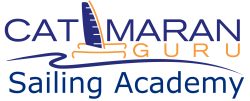
Week-Long Liveaboard Courses Rare RYA Classes & Certifications
Catamaran Guru’s real-life practical methods combined with up-to-date sailing theory in lessons aboard recent model catamarans…or your own boat!
Prepare for certifications or take the first step aboard to embark on your dream life of boat ownership or cruising
Classes in S Florida and the Bahamas.
Estelle Cockcroft
Join our community.
Get the latest on catamaran news, sailing events, buying and selling tips, community happenings, webinars & seminars, and much more!
Leave a Comment Cancel Reply
Your email address will not be published. Required fields are marked *
Save my name, email, and website in this browser for the next time I comment.
Recent Posts
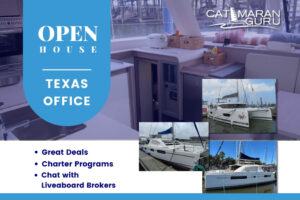
Texas Open House
Join us April 13 – 14 for our open house at our Texas office during the

First-Annual Virgin Islands Boating Exhibition (VIBE)
VIBE – It’s a Destination Boat Show! Join us May 10 – 12 at
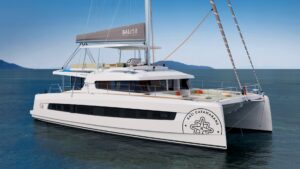
BALI Catamarans Unveils The New Bali 5.8 Flagship
CATANA GROUP launches its 14th BALI CATAMARAN model, the BALI 5.8, for the brand’s

Love Stories At Sea…because it’s valentine’s day
Because it’s Valentine’s day, we wanted to celebrate all the couples that we helped

For more than 30 years, we have been a part of the catamaran community and created Catamaran Guru™ to encourage and educate all the aspiring sailing out there. We understand the dream of traveling the world by catamaran and created a one-stop-shop to make that dream a reality for you.

- Stephen & Estelle
- Testimonials
Get Started
- Yacht Sales
- Used Yachts
- Charter Management
- Boat as Business Programs
- Seminars & Events
Downwind Sailing on a Cruising Catamaran
THIS POST MAY CONTAIN AFFILIATE LINKS. PLEASE READ OUR DISCLOSURE FOR MORE INFO.
Last Updated on September 28, 2020 by Amy
When we wrote our first sail trim for a cruising catamaran blog post, we were just about to move aboard Starry Horizons for our circumnavigation. We’d been sailing a 30-foot Maine Cat around Galveston Bay, getting some sailing experience under our belts. Starry Horizons is a pretty big leap, and we’ve learned a lot about sail handling since then. There are two advanced sailing techniques that we’ve found very helpful when sailing deep downwind.
Table of Contents - Click to Jump
Flying Headsails off the Windward Bow
Our screecher is our favorite sail to use. It’s huge and when the wind is just right (like on the beam) we really get flying. The screecher on the bowsprit is best used with an AWS of fewer than 15 knots, with an apparent wind angle (AWA) of fewer than 135 degrees.
We have sailed several times with the tack of our screecher (or spinnaker) attached to the windward bow of the boat instead of being attached to the bowsprit. This allows us to sail at a deeper downwind angle (135 – 160). Instead of approximately 12 lateral feet between the tack and the clew (half the width of the boat), we are now using the full width of the boat to open the headsail even wider.
While the sail is still furled, we use a soft shackle to attach a low friction ring to the bow cleat. Through the low friction ring, we run a new tack line. The bitter end of the tack line goes through the clutch on the toe rail. We loosen the clutch on the bowsprit to free the normal tack line. We detach it and pull the tack of the sail over to the new tack line. You can keep both tack lines attached for added control. This allows you to adjust the position of the tack: to the low friction ring at the bow, to the bowsprit, or somewhere in between.
Wing-on-Wind with Dual Headsails
We have sailed several times, especially on our Atlantic crossing, with our headsail and mainsail set to a wing-on-wing configuration. It works, but can be troublesome depending on how light the wind is or how much the swell conditions are knocking the boat around.
Instead, we’ve flown wing-on-wing with both our screecher and genoa out. The two sails combine to create one giant sail, and the wind funnels from one sail to another. This is much more forgiving than sailing wing on wing with the headsail and mainsail.
We usually set the wind vane to 150 or so, unfurl the screecher, and then set the wind vane to 174. Then we roll out the genoa. The genoa is a much more forgiving sail, and its better to accidently backwind the genoa than it is to backwind the screecher.
Downwind Sailing in Higher Winds
As the screecher is not a sail that you can reef, when the apparent wind speed is higher than 15 knots, we sail wing on wing with the genoa and mainsail. You can reef both sails as the wind picks up.
Monohull Notes
As you may know, David and I don’t have much experience on monohulls at all. From what we gather, monohulls are not as comfortable downwave as catamarans are. This is a plus for sailing catamarans on a downwind circumnavigation. However, when they do go downwind, we have several friend boats who sail wing on wing with the two headsails. Putting poles on the clew of the sail to spread them out would be required.
Other Advice
When sailing with finicky sail configurations like the ones above, be sure to put your autopilot on wind vane mode and set the wind angle as a priority. That way, if the wind shifts, your autopilot will adjust the boat to have the sails properly filled. If you are running on a heading or a track when the wind shifts, you might find your sails backwinded or do an accidental gibe (which is dangerous). Being on the wind vane setting does mean that you need to pay extra attention to your course; if the wind shifts, you may have to switch t another downwind sail tactic.
What have you found that works best for you while downwind sailing?
12 Comments
Super useful stuff here. Much appreciated.
Amy, I’m In Galveston. Never moved after school. Always Ship work between Houston and NOLA. I’m scheduled for a charter around September in St Lucia on A Helia44. Three cabin configuration. Looking forward to it.
Great! I hope you have a great time, St Lucia is lovely!
Amy & “DAVID” Of course I made a bonehead move and called David ‘Frank’ .. ? My apologies!!
Amy and Frank, Last night I was google-ing Catamaran Sail Trim for our Gemini 105MC (same as Dave Hedgepeth) when I found your blog. Then copied your ‘About’ link and sent it to work (I am West Marine Rig Shop mgr in Kemah, TX) to read about ya’ll when I had time. 2nd sentence re: Capt Amy: “Grandfather started State Boat and Father started Star Fleet in Kemah, TX” … OMG … Amy is Tom Lober’s daughter! Your Dad and I were classmate at TAMUG on Pelican Island 77-82. He would be SO Proud of both of you!! Donna Cuddy (my girlfriend and also a classmate of your Dad) bought a Gemini 105MC just like Dave Hedgepeth. Ours is in Deltaville, VA where we will explore Chesapeake Bay. Thank you for the Adventure you are Sharing!!
Hey Franklin! What a small world! I think of Dad all the time while cruising, he would have loved to join us. I’m very familiar with that West Marine! 🙂 PS don’t worry about calling David Frank!
Amy, I have shared your Adventure with fellow classmates, Karl Haupt, Ed Bishop and Jim Brown. We are all very Impressed! Please tell your MOM hello!
I did pass along your hello! Wonderful to hear from Dad’s old classmates!
Amy, I went to school with you Dad. TMA’80. Another classmate sent me the link.
I own a Gemini 105Mc so this info is great. My boss owns a Helia 44 in a charter fleet in Grenada.
Glad you are having a good time.
Hi Dave, thanks for reaching out, I’m glad you have found the post helpful. Where are you located?
We love this approach too. Much more stable than the traditional wing on wing.
Thanks Claudia! Nice to get an endorsement from an expert like you. 😉
Leave a Reply Cancel reply
Your email address will not be published. Required fields are marked *
Notify me of followup comments via e-mail. You can also subscribe without commenting.
This site uses Akismet to reduce spam. Learn how your comment data is processed .

Charter a Catamaran out of Newport RI
Book a private sail with us today!

Downwind Sailing a Cruising Catamaran
Sailing downwind in a cruising cat is not much different than any other sailboat. In this post two conditions, one of heavy wind 20 plus knots and one of light wind say 10 knots or less, are explained.
Strong Winds
When the wind is strong, 20 knots plus, it’s usually much safer to “heat up” or head up a bit to prevent an accidental jibe or wrap your spinnaker around the forestay . When you’re sailing dead downwind in stronger winds it’s wise to use a preventer hooked to the main boom should an accidental jibe occur. While using a spinnaker it’s not wise to sail dead downwind as when you catch a wave and surf down the face, you increase boat speed and decrease the apparent wind on the spinnaker… often times so much that the apparent wind may go to less than 5 knots. In this case the spinnaker may easily collapse and potentially wrap around the forestay. Some Cat sailors will argue this and prefer sailing under spinnaker alone without the mainsail. Although this is easy, low maintenance downwind sailing, maybe for days at a time, I personally do not like to do this as the mainsail will be your friend in an unexpected squall or wind increase and you need to get the spinnaker down. With the main up it’s very easy to sail dead down wind and blanket or collapse the spinnaker behind the main if you need to do a quick take down. Especially if you’re short handed on crew.
In a strong squall you may not want any sails up at all and just bare pole directly downwind. I personally prefer having the mainsail up even if it’s reefed to its minimum size in order to maintain steerage of the boat. Sailing wing and wing with a jib or genoa in a strong breeze is usually a very good option dead down wind as long as a preventer is used. Try using a spinnaker sheet attached to your jib or Genoa as the lead is usually further outboard and will help keep the wing and wing full. If you’re using a spinnaker be sure to head up a bit from dead down wind as this will keep the spinnaker with cleaner wind and less apt collapse as you surf down the waves. In large waves, be conservative and shorten sail and try not to sail faster than the speed of the waves otherwise you run the risk of surfing down the wave and burying your bow into the next wave. Generally not a good practice in cats. You slow abruptly as you hit the wave ahead and load up your rig or worse sink the bows and pitch pole. Not good!
Lighter Wind
As the wind lightens up say less than 12 knots, spinnaker or not, it’s much faster to to head up to a broad reach and increase your apparent wind. Cruising Cats can be heavy and they want to sail on a broad reach downwind. Forget about sailing dead downwind with a spinnaker up in lighter wind. You can sail wing and wing with a jib or Genoa dead down wind provided you’re in no rush.
As you head up to a broader angle or broad reach, you then have to be thinking about downwind jibe angles. If your waypoint or destination is downwind, eventually you will have to jibe to get there. Here is the easiest way to determine your jibe angle: In lighter winds less than 10 knots, it’s easy, in a cruising cat it’s usually 90-100 degrees. In other words, when your mark, waypoint or say a Harbor entrance bears 90 degrees off your current compass heading it’s time to jibe. This is true under spinnaker or any foresail. As the wind freshens it’s another story as 90 degree angles will be to much with a spinnaker and you will run the risk of over stressing the sail and destroying it. The angle should be closer to 50-60 degrees off your current heading.
Here is the easiest way to determine your jibe angle as the wind freshens. Sailing along, what is the true wind angle off your transom. What is the angle of the waves off your transom? Simply put, after you jibe, you want the wind angle (wave angle) off your transom to be the same as before you jibed. Look at the direction of the waves off your transom. What is the angle of the waves off your transom. Are they at a 45 degree angle? If so, your jibe angle is double that or 90 degrees. Is the wind strong and the angle of the waves only 10 degrees off your transom? Than your jibe angle would be only 20 degrees off your current course. To be more exacting and mathematical of your jibe angles, try standing over the top of your compass. What does the aft lubber line on the compass read? Look into the compass angle of the waves. Better yet, use a hand bearing compass. What is the difference between the two bearings? 10,20,30,45,50? Whatever it is, double it and that’s your jibe angle.
In the Northern hemisphere, if you’re jibing from Starboard tack to port or turning the boat to port in order to jibe than you would subtract your current compass course. Conversely, if jibing from port tack to Starboard or turning the boat to Starboard in order to jibe than you would add the jibe angle to your current course. In both cases, this will be your new compass course after you jibe. Most commonly sailing a Cat in moderate breeze, the waves or true wind angle will be approximately 30 degrees off the transom making the jibe angle 60 degrees. Important to remember a 90-100 degree jibe angle is for light winds only! Don’t risk damaging your beautiful spinnaker.
Does your new compass course after you jibe take you to where you want to go? If so, you did it right. If not, it’s no big deal. You will either have to jibe again or if you went to far on the previous jibe and your new course apparent wind angle is further forward than you expected, you may want to temporarily head off the wind and take down your spinnaker before you damage it.
In summary, cats will sail better downwind in lighter to moderate winds by heading up from dead down wind “heating it up.” In stronger winds, be very careful sailing dead down wind. Use a mainsail preventer and be careful surfing down the waves and collapsing the spinnaker and potentially wrapping it on the forestay. Or better yet, if you must sail dead down wind, take the spinnaker down and wing and wing the foresail.

Share this:
Leave a comment cancel reply.
- Already have a WordPress.com account? Log in now.
- Subscribe Subscribed
- Copy shortlink
- Report this content
- View post in Reader
- Manage subscriptions
- Collapse this bar
Generally, the spinnaker and gennaker are the two types of sails which are utilized for downwind or reaching conditions. Which sail to choose will depend on your intended course, wind speed and sea state. Both types can be very powerful so they should be treated with respect, especially when one is sailing short-handed. The ability to furl them at any time is imperative.
In speeds varying from 5 to 20 knots true, the gennaker (or screacher), depending on the cut, can be utilized to sail as close as 45 degrees or as deep as 170 degrees. As we will later see, it will be wiser to sail at a closer wind angle, increasing your VMG to leeward. Conversely, the stronger the wind and the more agitated the sea, the deeper you should sail. Gennakers are usually built for light-to-moderate conditions. Care should be taken that the Apparent Wind never exceeds the intended fabric limitation of the sail. I should remind myself, as I have blown out too many.
Sailing downwind in a multihull is a breeze, with reaching typically a preferred point of sail. When sailing from a close reach to a beam reach or from a beam reach to a broad reach in a multihull, trim the sails as you would for a monohull . Ease the sheets until the leeward telltales flow aft evenly. The main difference from monohull sailing is that fast catamarans bring the Apparent Wind farther forward, so that for a lot of downwind sailing the sails are set as though for a beam reach. Fast cruising multihulls are often seen flying asymmetrical spinnakers with the headsail up, which is an advantage for racing. Slower cruising multihulls differ less from monohulls when sailing downwind, although flatter sheeting angles are typically needed to maintain proper sail trim.
When the destination is dead downwind, fast cruising multihulls usually "tack" on a broad reach course and gybe 90 degrees through the wind. This technique produces the fastest speeds and the fastest passage between two points. Slower multihulls usually sail closer to dead downwind, but with little heeling; the typical rolling motion of a monohull is all but eliminated and the tendency to broach does not exist.
below Spinnaker drops can often involve the entire crew. Great care should be taken not to lose the halyard when unclipping, a mishap that has happened to all of us.

right Colorful spinnakers, such as this tri-radial kite, are often set by using a spinnaker sock to hoist and douse them. Note that the one pictured is on a furler, which makes handling a simple one-man operation.

Spinnakers are made of nylon and can be cut either with equal leaches or different length sides, hence the distinction, symmetric and asymmetric spinnakers. The higher the Apparent Wind angles, the more an asymmetric spinnaker or gennaker should be used. However, the deeper one is sailing, meaning with the Apparent Wind close to dead astern, the more power a symmetric spinnaker will provide. Since on a fast cat the wind is brought forward of the beam, these boats only have an all-around gennaker or asymmetric spinnaker.
huge sails can be set without a pole due to the wide beam of a multihull, although a bowsprit permanently mounted on the forward beam of a cat allows the tack to be tightened using only one line. When flying a spinnaker on a multihull you need to be aware of the moment when the sail should be taken down. Higher boat speed downwind means lighter Apparent Winds, and it's easy to get caught in True Winds too strong for spinnakers. On a fast multihull, heading downwind temporarily depowers the sails just as luffing up does when going to windward.
Cruising multihull sailors seem to favor asymmetrical spinnakers for downwind sailing in light winds. The tack of an asymmetrical spinnaker is supported by a line from each of the outward bows of a cat. These
When sailing downwind in light winds trim the spinnaker first by sheeting it in until the sail begins to stall, then ease the sheet until the leeward telltales flow aft evenly. If the headsail can be carried, trim that next in the same manner. Lastly, set the main traveler and trim the main.
If your boat has daggerboards, keep the boards down partially for a beam reach to minimize leeway, then raise the boards gradually as you sail farther off the wind. Experience will tell you exactly where to place the boards in various conditions. Sometimes it helps to keep a foot or so of daggerboard down when running to improve tracking.
The gennaker can be hoisted when the Apparent Wind is lower than 20 knots. It should be set with the wind between 80 and 110 degrees. This sail requires special precautions, in particular in the handling of the running backstays, if applicable. If the boat is set up with running backstays to counteract the forward pull of the gennaker, the runners should be on tight. If possible they should not be left in jammers but locked on a self-tailing winch. Many rigs that failed collapsed because of jammers pulling out of the deck, suddenly releasing the runners and snapping the mast. One should think about dousing gennakers when the Apparent Wind exceeds 20 knots. When this powerful sail is furled, it can be lashed to the trampoline and left attached to the bowsprit end, if conditions permit. Make sure it is safely tied and cannot blow over the side or fill with water. There should never be a permanent line from the bowsprit to the top of the seagull striker. Instead the bowsprit should be held up with the spinnaker - or spare halyard. This will prevent the risk of losing the forestay and rig in case the gennaker halyard fails and the sail goes overboard and fills with water.
Light-displacement catamarans occasionally surf down the backside of waves. They can sometimes surf at speeds approaching True
Wind Speed, which brings the Apparent Wind to zero and causes the headsail or spinnaker to temporarily collapse. A spinnaker in that situation may wrap itself around the headstay. If it wraps tightly, you may need to gybe the mainsail to allow it to release itself. When freed, gybe back to your original course. You can help prevent spinnaker wrap by temporarily over-sheeting until the Apparent Wind picks up again. Repeated surfing and cavitation of rudders might indicate that you have too much sail up for the wind and sea conditions.
Continue reading here: VMG vs Boat Heading
Was this article helpful?
Recommended Programs

Myboatplans 518 Boat Plans

Boat Alert Hull ID History Search

3D Boat Design Software Package
Related Posts
- Airflow and Sail Turbulence
- Sailhandling Monohull vs Multihull
- Catamaran sailing downwind
- Catamaran Design Guide - Catamarans Guide
- Rudders - Catamarans Guide
- How Are Catamaran Masts Fixed Down
Readers' Questions
What does sailing deep downwind mean?
Sailing deep downwind is when a sailboat is sailing in the opposite direction of the wind, with the sails filled by the wind and pointing downwind. This type of sailing can provide higher speeds than other points of sail and is often used to cover more distance quickly.
How to rig spinnaker catamaran?
Hoist the main: Start by hoisting the mainsail easily, a few feet above the deck. Make sure the mainsheet and traveler are secured. Attach the spinnaker pole: Place the spinnaker pole across the boat and attach at the mast. Adjust the spinnaker sheet: Pass the sheet along the boom and secure the head of the spinnaker to the spinnaker sheet. Pull the sheet tight and cleat off on the boom. Attach the spinnaker halyard: Attach the head of the spinnaker to the halyard and hoist it above the mast. Tie off the halyard to the mast. Secure the tack: Secure the tack of the spinnaker to the spinnaker pole. Attach the spinnaker sheet: Secure the sheet to the spinnaker pole and the cleat on the boom. Adjust the spinnaker sheet: Adjust the sheet to the desired tension. Increase or decrease tension as needed. Adjust the topping lift: Adjust the topping lift to the desired tension. Increase or decrease tension as needed. Trim the spinnaker: Trim the spinnaker as the wind shifts, for maximum efficiency.
How to sail downwind faster catamaran?
Change your sail trim to be on and slightly off-center of the wind wave. This will help you to use the wave as a surf wave and will reduce the drag caused by the waves. Adjust your sail trim in order to maximize the lift that the sail provides. This will give you a more efficient sail trim and will enable you to sail further downwind with less effort. Utilize a Code Zero sail. The Code Zero is an overlapping jib sail that is designed to be used when sailing downwind. This sail is much larger than a typical jib sail, so it will provide more lift and help you go faster. Move your weight to the back of the boat. Moving your weight aft will help reduce the wetted area of the boat and increase the power of the sail. Use the daggerboard to lift the bow of the boat and reduce drag on the leeward side. This will help you to make the boat run faster and will reduce the drag created by the waves.
Yachting World
- Digital Edition

How to pick the best downwind sail
- Rachael Sprot
- August 17, 2022
How to set up your boat for smooth, stress-free downwind sailing and how to pick the best downwind sail: Rachael Sprot examines the options

For the coastal sailor, upwind sailing skills are critical: there’s nothing like a lee shore to focus the mind on tacking angles and leeway. For the ocean sailor the challenges are VMG, handling swell and avoiding a crash gybe, but ongoing developments in hull, rig, sail and hardware design have generated huge variations in how we do this. There’s a confusing array of kit and tactics to choose from, so it’s important to spend time on research before spending money on equipment to ensure you get the best downwind sail and setup for your needs.
The first rule of any big decision is to know yourself, your boat and your crew. Neil Mackley, of North Sails, explains: “The thing I most enjoy is sitting down with people and finding out about them. Are they comfortable handling a pole? Are they happy working on the foredeck or would they prefer to manage things from the cockpit? How much stowage space do they have?”
When it comes to the boat, one of the most important metrics is the efficient downwind sailing angle. Broadly speaking, light, flat-bottomed, modern yachts will sail much faster on a reach than on a run. Comparing the new Swan 48 with its predecessors illustrates these changes: the current model is 14% faster on a heading of 120° TWA than 150° TWA. The previous generations only have a 7% difference.

A spinnaker is an essential part of many tradewind cruisers’ sail wardrobe. Photo: Tor Johnson
Scrutiny of the polars for the 1995 Frers Hallberg-Rassy 46 gives a similar picture. When flying a spinnaker in 14 knots it makes 7.1 knots on a TWA of 165° and 8.4 knots on a TWA of 120°. The extra 1.3 knots accumulate to a 400-500-mile gain over a transatlantic passage , but the 45° difference in angle will cost far more in extra distance.
Heavy-displacement, traditional cruisers won’t make exponential gains by reaching. “Wherever possible I run the data through a velocity prediction program to find out where the sweet spot is,” Mackley says, “and for most cruising boats it pays to sail deep.”
Another consideration is how much you’re prepared to use the engine. The east-west transatlantic route is often light airs to begin with and reliable 20-knot tradewinds building through the passage. If the tradewinds are well south, do you carry enough fuel to motor to find them? Weight is a vicious circle: the heavier the boat the slower it is in light airs… To break the cycle you need a sail which can get you moving in under 10 knots of wind, but that may be a specialised sail with a narrow window of operation.
Symmetric spinnakers
“For a transatlantic crossing from Europe to the Caribbean where there’s a high proportion of deep angles, it’s hard to beat a symmetric spinnaker,” says Peter Kay of OneSails. Symmetric spinnakers are the traditional solution to running and they’re still a truly effective option. The pole brings the sail area out from behind the mainsail enabling wind angles of 165° or more.

Weather guru Chris Tibbs flying a symmetric spinnaker on an Atlantic crossing. Photo: Paul Wyeth
There are significant drawbacks, though. The pole work is labour intensive and tiring for a small crew. A 60ft boat flying a symmetric kite will need almost 200m of line for the pairs of sheets and guys. Add in an uphaul and downhaul and there’s a lot going on in the cockpit.
Reaching performance is limited. Although you can set the pole well forwards, you’ll normally need a jockey pole to push the guy clear of the shrouds and stanchions and a running sail will be cut too deep to work well on a reach.
“Although the spinnaker is one of the best tools for a transatlantic, most people don’t go for them because once you’ve arrived on the other side they’re less versatile,” Kay continues. Andy Tarboton of Elvstrom agrees, pointing out that a spinnaker’s broad shoulders puts “more sail high in the sky, which can exacerbate rolling”.

Asymmetrics are usually flown from a bowsprit or the bow roller. Photo: Jean-Marie Liot
Asymmetric spinnakers
Removing the complexity of the pole, an asymmetric spinnaker is flown on a short sprit or the bow roller. Also known as gennakers and cruising chutes, there’s a huge array of asymmetric spinnakers on the market, with an equally confusing array of names. “Asymmetric describes a whole range of styles and performance envelopes,” explains Kay, “from something trying to be a genoa right through to something trying to be a spinnaker.” They all have one major advantage though, which is the ease of sail handling, making them the obvious choice for short-handed crews.
A running asymmetric can be designed to achieve very broad wind angles, almost comparable with those of a symmetric spinnaker. The luff of a running sail will rotate around the forestay as the sheet’s eased, giving wind angles approaching 165° TWA.
If you want to be able to furl the sail though, you’ll need something which is flatter cut and more of a reacher. “Realistically, you’re limited to angles of about 135-145° for sails on furlers, depending on sea state,” explains Mackley, “and then you’re covering a lot of extra distance.”

Oxley parasailers maintain their own shape without the need for a pole.
Parasailers
A sail which attempts to solve the compromise between reaching and running is the parasailer. It looks like a symmetric spinnaker with a pressure relief valve, but the mechanics behind it are very different. A large panel is removed from the upper part of the sail and a paraglider-style wing is suspended in its place. According to designer of Oxley sails, Ralf Grösel, this does several things: it creates lift, it gives the sail structure (similar to a soft batten), and it dampens the rolling motion that conventional spinnakers can generate deep downwind. The opening also acts as a vent, taking the bite out of gusts.
The wing lends structural support to the overall shape so you don’t need a pole. A parasailer can be flown in front of the boat like a symmetric or from the bow like an asymmetric.
There are two control lines on each clew: one running aft to stop the sail pulling forwards, and one running down to midships to counteract the lifting action of the wing. Ideally it is used without the mainsail as the wing performs better in an uninterrupted airflow. This will also help to keep the helm light.
A wing sail is quite an investment and will probably cost more than a single sail, but they should work for a wide range of wind strengths and sailing angles. “It’s like you’re getting two sails in one; a reacher and a downwind spinnaker,” says Grösel.
Handling-wise, a parasailer is a sheep in wolf’s clothing and, other than price, its main detraction is that it won’t deliver as much raw power as a standard kite. If you’re looking for something forgiving, it’s a serious contender.

A double tradewind sail is flown goosewinged but set on a furler. Photo: Shahid Hamid
Tradewind sails
Another slightly left-field option is the loose-luffed, double headsail, such as North Sails’ TradeWind sail, or Elvstrom’s Bluewater runner. Made from stretchy nylon like a spinnaker, but cut more like a large genoa, the pair of free-flying headsails are set on a furler making them easy to douse. They’re designed to be flown in a goose-wing configuration, with the windward sail set on a pole and the leeward one flying off the end of the boom.
It’s ideal for trundling down the rhumbline – known as the 180 freeway, says Mackley. “The rig is much more balanced. When you’ve got a mainsail and headsail up the forces are acting on the boat in different places. With the TradeWind sail you’re being towed from the stemhead.”
Article continues below…
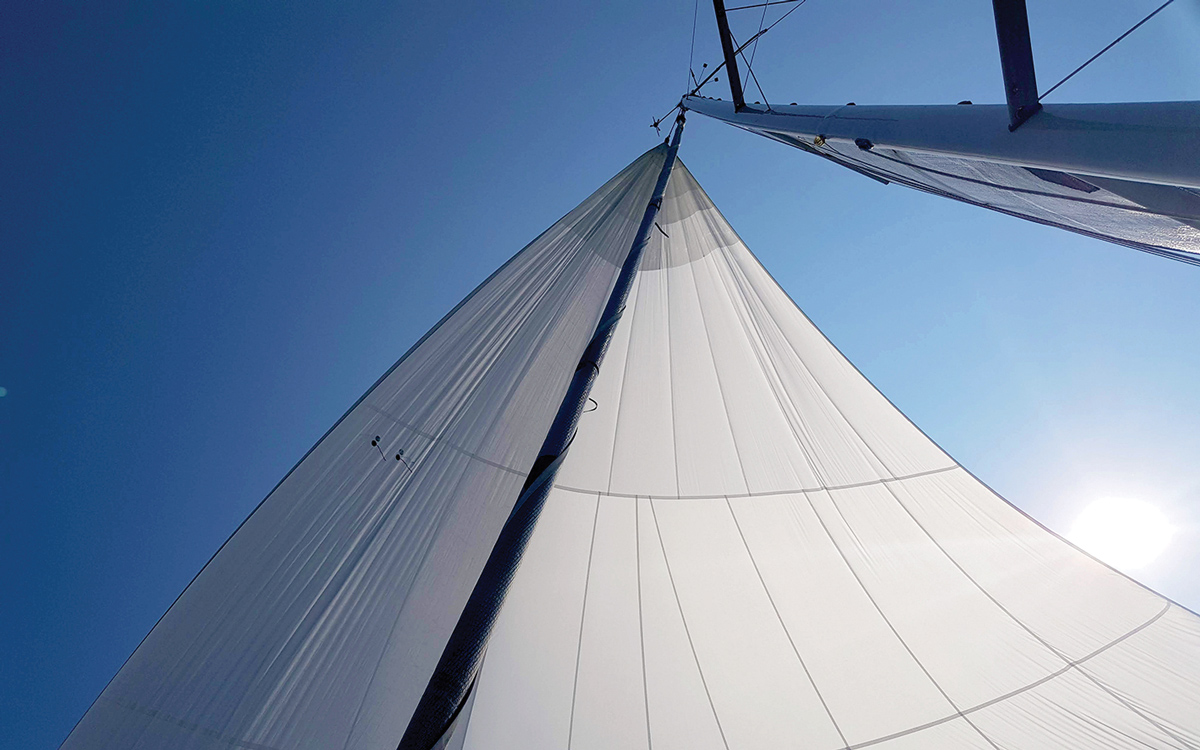
Downwind developments: The latest offwind sails for faster tradewind crossings
These can transform cruising yachts, giving them sufficient power to sail in light airs when previously crews would have been…
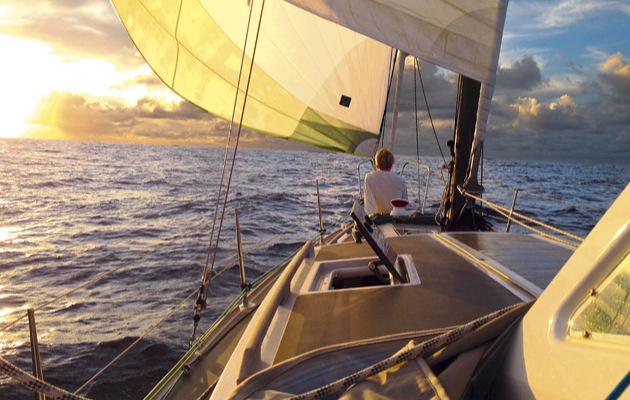
How to sail the ARC: Chris Tibbs on how to cross the Atlantic downwind
Meteorologist Chris Tibbs offers some pointers on downwind sailing...
After arriving, you can link the tacks together to create a single sail for light airs’ reaching up to about 100° TWA. The drawback is they’re not suitable for confined waters and are more costly because of the necessary furling equipment, and the fact there are two sails instead of one. The furler could be shared with a Code sail, however. Being made from lightweight polyester they are also no more squall-proof than a spinnaker.
A poled-out headsail is consistently rated the most stable and stress-free downwind rig by ARC crews. It has a wide angle of effectiveness, from a dead run up to about 140°. From a safety perspective it’s a forgiving configuration: if you round up the headsail simply backs, which can be remedied by bearing away again. Dacron can cope with most weather that the Atlantic can throw at you so you won’t feel quite as vulnerable to squalls.
Most headsails can be poled out, though you want to keep the sail flat to reduce flogging in swell so a large genoa might have to remain partially furled. The key is to keep the pole and the sail independent of one another by giving the pole a guy which is separate to the headsail sheet.

Poled out headsails, whether in combination with the mainsail on the other side or another headsail, are rated as the most stable of downwind rigs. Photo: TimBisMedia
The headsail sheet needs leading to the end of the pole and routing aft. A snatch block attached with a strop or soft shackle to the beak works well. The sheet lead will be longer than normal so you might need to use a spinnaker sheet instead of your standard headsail sheets. Depending on the height of the clew, this can be hard to reach once the sail is up or furled, so needs planning.
Once the pole is braced into position, it’s a case of unfurling the sail to leeward, heading on a deep run and gybing the headsail across to the pole, being careful to quickly take up tension on the new sheet to prevent the sail from wrapping around the forestay. Position the pole at clew height and flatten the sail as much as possible.
To furl the sail, ease the sheet and furl it or, to reduce the load on the furler, gybe it across to leeward and furl it behind the main. Because it’s independently set, the pole can be left in position while the sail is furled if you need to manoeuvre or ride out a squall. Once the wind exceeds 18-20 knots most cruising boats will make good speed under this configuration.

Sailing wing on wing on the Oyster 575 Angels’ Share. Photo: TimBisMedia
Another variation for vessels with twin grooves in the forestay foil is to set two headsails and no mainsail. One can be set on the pole and a second sheeted to the end of the boom, which needs to be braced out using the preventer. It’s a bit of a performance to rig and de-rig, but once up it’s a stable rig which works from broad reach to broad reach. Since there’s no work involved in gybing, it could be a great short-handed solution.
Although not technically downwind sails, Code sails are free flying headsails for close reaching in light airs. They do a similar job to a big genoa so are useful on yachts with fractional rigs and small foretriangles, and are popular on multihulls. There is a place for them when cruising, especially if you’re keen not to resort to the engine when the wind is light. For example, OneSails’ Flat Furling Reacher or FFR is a cross between a Code 0 and a genoa, with a range of 50-130°. It fills in the gap between a headsail and a deep running asymmetric so is a useful addition to the sail wardrobe but is unlikely to play a big role in a tradewind crossing.

A big light airs sail for a big boat: a Jeanneau Yacht 60 reaching under code sail. Photo: Gilles Martin-Raget
Headsail handling: Furlers
Spinnaker handling has been revolutionised by furlers, allowing the sail to be doused from the cockpit. Continuous line furling technology has developed across from Code 0s but with one key difference, spinnakers are better furled from the top and not the bottom. On a Code 0-style furler the tack is fixed to the furling drum, on a top-down furler the tack is free to swivel.
The furling motion on a top-down furler is transferred to the head of the sail via a heavy duty anti-torsion cable. Furling a spinnaker this way is much more effective as the sail cloth locks down on itself making it less prone to spilling open.

The OneSails Integrated Furling Structure sail uses continuous fibre technology to replace the anti-torsion cable. Photo: OneSails
There are also reaching spinnakers with luff cables built into the sail, and more recently, ‘cableless’ furling sails which have a structured luff using laminate technology, micro-cables woven into the sail or soft luff cords. Removing the anti-torsion cable saves weight and makes the sail easier to handle, but it might not furl so well in sub-optimal conditions. The systems with a torsion cable will probably cope better when you’re caught off guard.
The advantages of a furling spinnaker for short-handed crews are obvious. Not only do they make a single-handed spinnaker douse from the cockpit possible but they also reduce the volume of the sail, making it easier to stow.
However, there are drawbacks. Most furling sails will be too flat to perform well on deep angles. Sails with an external luff cable will do better than those with inbuilt cables because they’ll be able to project around the forestay more, but you still can’t have a proper, broad-shouldered runner on a furler.
It’s tempting to leave a furled spinnaker up to sit out a squall, but that’s not recommended: even ‘locking’ furlers are not totally reliable. If you do decide to leave one up, Neil Mackley suggests using a soft shackle or carabiner to secure the drum. Be aware that most spinnakers also won’t have UV protection.

Spinnakers are easiest to douse top down with a snuffer. Photo: Richard Langdon
Headsail handling: Snuffers
Getting a spinnaker down is always the hardest part of the process. Snuffers have been around since the 1980s when French designer Etienne Giroire refined the DIY socks which solo sailors such as Eric Taberly were using.
Giroire realised that the lines for raising and lowering the sock needed to be contained within a separate sleeve to prevent them from tangling with the sail. He also noted that the two control lines had very different jobs: the line for pulling the sock up can be light weight because once the sail starts to fill, the snuffer practically raises itself. The line for pulling the sock down needs to be strong and of twist-free construction. He went on to found ATN, which has sold over 30,000 snuffers. The oval plastic mouth has been replaced by a canvas hoop for larger yachts, while some manufacturers now offer inflatable rings to make stowage easier. Other than that, the design has changed little over the years.
The one drawback is that they require someone on the foredeck to heave down on the sleeve, which can be hard work in high winds. A ratchet block on the deck gives a bit more control over the down line. Bearing away and sheeting in will blanket the sail, and – if that still isn’t enough – you can blow the tack and the sail will flag behind the main.
Snuffers can be retrofitted to most sails including big symmetrics. They are a bit less elegant than furlers, but much more economical and a bit less tricksy.
No system is foolproof, and both snuffers and furlers can fail. If they do, you need to be able to drop the spinnaker conventionally. Make sure that you’re all clear on how you would do it on your boat.

Regular rig inspections are essential on downwind passages. Photo: Tor Johnson
When it comes to downwind sailing, the only thing most people can agree on is that a poled-out headsail is the bread and butter. What you choose to add on top of that is up to you and will depend on variables such as budget, crew, boat, and other cruising plans. Even with a perfect sail set-up, sea state can make it impossible to hold an optimum course – as last year’s ARC participants found when a nasty cross swell developed.
Very few sails can deliver both reaching and running functions, apart from the parasailer and ‘tradewind’ sail, neither of which are high-performance options.
Elvstrom’s Andy Tarboton notes that the most common choice for people taking a single sail is somewhere in the middle ground, such as a mediumweight asymmetric. Peter Kay at OneSails would choose a deep running asymmetric spinnaker, if he could only have one, and a FFR (Flat Furling Reacher) if he could have two. North Sails’ Neil Mackley was drawn to the symmetric spinnaker: “It’s a very efficient sail downwind, but because of the pole it’s a hard one to have in the inventory.” The tradewind and a Code sail would be a versatile combination for more conservative cruising.
Understanding the sail’s capabilities and your own limitations will make for efficient sailing. Work out where your priorities lie on a scale of fun to comfort and ask an experienced sailmaker to narrow down the options.
If you enjoyed this….
Yachting World is the world’s leading magazine for bluewater cruisers and offshore sailors. Every month we have inspirational adventures and practical features to help you realise your sailing dreams. Build your knowledge with a subscription delivered to your door. See our latest offers and save at least 30% off the cover price.
Call Us (561) 445-5664
How to Sail a Catamaran: 10 Catamaran Sailing Tips
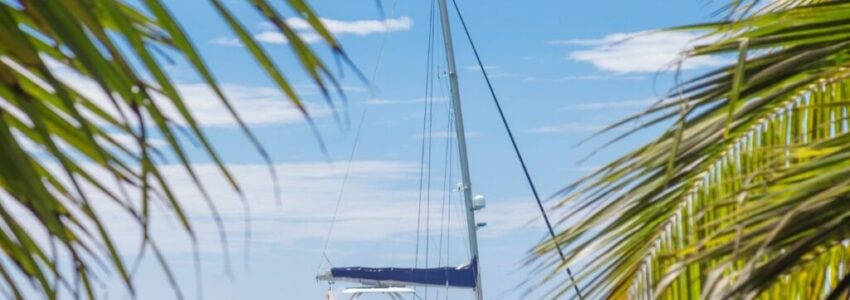
Published Sept 6, 2021
Have you been wondering about how to sail a catamaran? Well then, you’re in the right place as we will provide you the basic information about catamaran boats as well as their advantages and disadvantages. The information we’re about to tell will help you sail your catamaran as easily as possible. Lucky for you, this article includes 10 tips for sailing catamaran boats that you should know.
What Is A Catamaran?
A catamaran is a multi-hull, meaning it has two connected hulls with two engines, two sails, and two rudders. Catamarans are known for their stability and spaciousness. Additionally, they offer larger areas for the deck, saloon, and galley, so this boat is the best option for people who prioritize their comfort over the cost.
Advantages Of Catamarans
- Spacious – Catamaran is a multi-hull, so the space it offers is double the space on usual monohulls . Massive space means more space for bigger rooms, cockpits, and decks. In addition, this multi-hull can accompany more guests all at once.
- Stability – Since a catamaran is built of two hulls, they are more stable, unlike other boats. As a result, multihulls are less prone to rocking and heeling, suitable for guests or crew members with seasickness. In addition, the stability of catamaran boats makes it more comfortable for people to sleep, read, and wander.
- Easy to maneuver – Catamarans consist of two engines and rudders. They are helpful when it comes to maneuvering and docking the boat. In addition, having two engines makes catamarans reliable when emergencies occur.
- Speed – As mentioned earlier, catamarans don’t have kneels, making them lighter than other boats. This makes them faster when it comes to sailing downwind or broad reaches.
- Design – Catamarans’ designs look attractive to the eyes. These multihulls bring prestigious vibes that most guests look for. They are treated like luxurious vessels because of their fascinating looks.
Disadvantages Of Catamarans
- Expensive – Catamarans tend to be more costly than most monohulls or cabin sailing yachts. This kind of boat is more expensive because it provides many features that require more high-quality building materials.
- Availability – Despite being more expensive than other boats, catamarans seem to be very popular these days. Unfortunately, this multi-hull sells out fast, so they are not always available. If you wish to use catamarans, you should book a reservation for your boat early.
Requiring bigger space to berth – Since they provide more space for guests, it takes up as much space. Therefore, this multi-hull usually takes up double the space to berth than monohulls. . (Related: Trimaran vs. Catamaran: Which is Better? )

10 Catamaran Sailing Tips
Here are some tips on how to sail your catamaran:
1. Always keep the boat sailing downwind
Sailing downwind prevents pounding and slapping sounds that slow down the boat. When the low bridge deck slaps on the undercarriage of the boat, it causes annoying sounds. Making sure that you are sailing downwind as much as possible makes your sailing hassle- and noise-free.
2. Speed up before tacking
You must have enough boat speed to tack smoothly. Tacking refers to a changed direction of a boat to achieve the desired destination. If you don’t speed up, you will most likely not be able to tack.
3. Bring the mainsail close to tack efficiently
You can tack efficiently by keeping the mainsail tight and sailing as close to the wind as possible. You must be able to do that without losing boat speed. Otherwise, you won’t be able to tack.
4. Use the jib to help the bows turn better through the wind
Jibing is the opposite of tacking. It’s a sailing maneuver wherein the boat turns its stern through the wind to turn the bows. You should let the jib get backwinded for a while to fix the position of your bow.
5. Bring as many snubbers as you can
Snubber is short cordage attached to the anchor chain and a strong area on a boat together with a bridle. These are used to stop chains from rattling on the bow roller. Snubbers are helpful to prevent and relieve tension on lines and deck fittings. Since the ocean waves can bring pressure to many lines in your boat, you should set up as many snubbers as possible.
6. Use throttle control for maneuvering in normal conditions
The throttle control manages the speed of a boat which makes it ideal to use for maneuvering. You must do this while keeping the steering wheel center.
7. Use engines only when maneuvering in narrow spaces
For maneuvering in tighter spaces, you should consider using the engines only. Using your engines alone is better than maneuvering with steering wheels.
- Use both engines for backing
When your catboat needs to anchor, your two engines will be helpful to you. You can use both engines for faster backing to anchor.
9. Make sure that your boat has completely stopped when you’re going to anchor
Catboats have a shorter keel than most boats, so they are less resistant to water. Catamarans require more time to slow down than monohulls, so you need to be extra mindful when anchoring your boat.
10. Plan advance for weather conditions
Checking the weather when you’re planning to go boat sailing is a must. Even though the weather reports tell you that it would be a sunny day, you should still prepare for other weather conditions. You should be ready and have every piece of equipment needed if ever the rain decides to fall unexpectedly.
Cruising Catamarans
These are the types of cruising catamarans that can be used for your next sailing trip:
Charter/cruising catamarans
This type of catamaran is built explicitly for the charter market. This has small rudders, heavier displacements and can easily struggle even in ideal water conditions. Charter cats usually sail at 55-60 degrees true wind angles (TWA).
High-performance cruising catamarans
High-performance cruising catamarans offer advanced centerboards, deeper rudders, and less displacement, which is better than a typical catboat. If no problems occur, you can sail this type of cat windward at a 45-50 degree TWA.
Sailing with catamarans has its own advantages and disadvantages. However, we can’t deny the fact that it’s one of the beginner-friendly boats to maneuver. Sailing catamarans should be easier for you now that you’ve learned some tips on how to sail a catamaran.
Experience Yacht Charters With Seafari In Boca Raton Florida
Looking for a great time on the water in Boca Raton Florida? Seafari Yacht Charters is number choice for yacht rentals in Boca Raton . Book our yachts for parties , exciting day trips to the Bahamas, romantic yacht dinner cruises , and much more. Come experience all South Florida has to offer with us.

Fact Checked By Experts
Our team of internal experts has conducted rigorous fact-checking on this content. Explore the editorial standard for our website to dive deeper into our commitment to excellence.

About The Author
Krizzia Paolyn has a bachelors degree in Psychology and a passion for yachting in South Florida. She has a desire to be heard and to encourage others to make their voices heard as well.
Related Posts
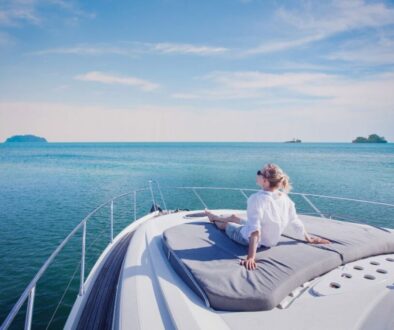
Yachting Benefits You Might Not Know
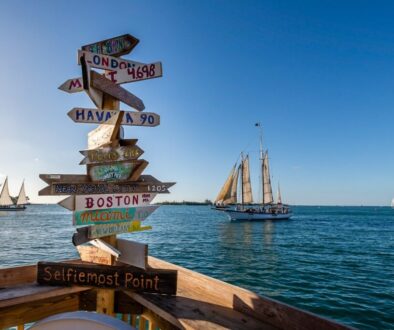
Most Popular , Yachting
How To Charter A Boat From Miami To Key West
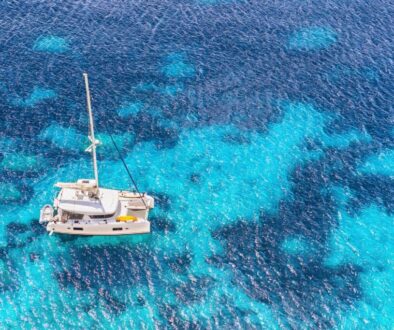
What To Know Before Renting A Catamaran Charter
Find us on social media.

© SeafariYachtCharters.com 2024
View Our Privacy Policy
Website design by Correct Digital
- BOAT OF THE YEAR
- Newsletters
- Sailboat Reviews
- Boating Safety
- Sailing Totem
- Charter Resources
- Destinations
- Galley Recipes
- Living Aboard
- Sails and Rigging
- Maintenance
- Best Marine Electronics & Technology
Controlling Your Sails On A Catamaran
- By Don Margraf
- Updated: June 18, 2018
In monohull sailing, when you leave too much sail up in a building breeze the signs are clear: The rail is underwater, the dishes are on the floor, Grandma is terrified. The boat is dealing with excess energy by trying to lever a 5-ton lead weight out of the water; in other words, it’s heeling, spilling breeze, slowing down and rounding up.
Multihulls don’t behave that way. When you overpower a cat, it can only accelerate, dig a hole in the water or bust gear. No-heel sailing has a lot of advantages, but one drawback is the temptation to sail badly. You might easily go sailing with breakfast dishes on the table and postpone reefing until you’ve cleaned things up. In the meantime, the breeze is on, the boat’s impossible to steer and you shred a sail. One key to safe catamaran sailing is to learn when — and how — to reduce sail.
The best place to learn how to tuck in a reef is at the dock. Pick a morning with zero wind, and hoist. Practice reefing and un-reefing till you can do it in less than three minutes, blindfolded. If something jams or snags, stop. Find the source, figure out the cause and fix it. Look for inherent weak spots, chafe areas and jammed lines or sail slides. Study the whole system in slow motion and imagine how it will behave in howling wind, thrashing seas or on pitch-dark nights.
With the main down and flaked on the boom, go to the mast and haul up the main halyard, hoisting the sail as far as you can with two hands and no winch. Let it drop. Repeat and get a feel for the amount of friction built in to this most simple system. Then, if your lines lead to the cockpit, go back and repeat the procedure from where you would normally hoist the sail. Note how every bend and turn adds friction.
It’s important to have a solid understanding of your boat’s base-line resistance. When something jams in the dark, at sea, and you’re alone in the cockpit, you have to know nature’s little warning signs. Your evil inner voice will say, “You’re just tired. Put that thing on the electric winch!” You have to be able to argue back, “No, this is not the normal amount of friction. Something’s wrong.” Remember: There are no snag problems an electric winch can’t make worse.
While you’re at the mast, study the gooseneck. With the first reef in, look at the way the reef line is led to the deck and back to the cockpit. Look for friction and chafe. Push the boom out and back, making sure the reef line doesn’t change tension. Look back at the tail end of the boom, where the reef line passes through the leech. The reef line should pull both reef points in two directions: down and forward at the luff, and down and back at the leech. It should run through all its turns, from boom to cockpit, with minimal resistance. It might appear to be all clean and peaceful at the dock, but on big seas, everything is in motion. The slightest chafe whittles line down to bird-nest fodder in no time.
Next, work out your own checklist for reefing. It should be a simple list of the basic steps, in an order that goes something like this: 1) Ease mainsheet. 2) Set topping lift. 3) Ease halyard. 4) Tighten and secure reef line. 5) Re-tension halyard. 6) Trim sheet.
Reach for It
Once you’ve got it down pat at the dock and you’re ready for a test run, pack a lunch and look for a steady 15-knot breeze with plenty of sea room. Set a heading on a close reach, check sea room again and punch in the autopilot. Watch the autopilot drive for five minutes while you review your checklist.
When you’re ready, ease the mainsheet and let the traveler down until the main is completely de-powered. Adjust jib trim and autopilot heading until the boat stays on course, powered only by the jib; don’t fall off and let the luffing main fill again. The speed will go down sailing only on the jib, but the boat should balance, still on a close reach. Now go through your checklist and practice it step by step for both the first and second reef, hauling the sail up and down until you have it down cold or run out of sea room.
Reefing on a close reach has its own tricks and hassles, but I find it far easier than starting engines, pushing the bow into the wind, leaping off wave crests, pounding in troughs, watching for stray lines in the props and minding the flogging boom.
In the distant past, when mainsails had short (or no) battens, the sail flogged when luffing. This was considered hard on the sailcloth. The full-length battens on modern catamaran mainsails take the flog out of the sail but put it in the boom. This is considered hard on skulls, should they be in the way. An out-of-control boom also flails slack lines, which snag, bend, remove hardware and tie themselves in weird knots. It’s a deadly menace to life and property. I try to avoid it at every opportunity. Still, it’s good to practice reefing nose-to-wind, and also heaving to. It’s difficult, it tests boathandling skills and it helps prepare you for the toughest challenge: reefing while sailing on a run.
Before we head off downwind, let’s heave to for a minute and review. We like to practice at the dock, in dead calm, because, well, it’s calm. Everything’s easy.
So how to know when to reef? The first obvious answer is the wind-speed indicator. If your boat has an owner’s manual, it probably recommends reefing at 18, 28 and 35 knots or so. Every boat is different, and no rule fits every situation, but take it on faith that these are ballpark figures. Pick your own numbers, but be conservative, watch the wind speedo (hopefully it’s been calibrated) and stick to your rules till you know your boat well.
Do you put in the first reef at 18 knots true or apparent? Great question. Most cats pick up a lot of speed when they head downwind. This exaggerates the difference between true-and apparent-wind speed. You’ll especially notice this if you have set a gennaker or spinnaker and the wind is building. If you head up even a few degrees on these sails, the apparent-wind speed builds so fast you might have a shredded sail quicker than you can say “snap fill.”
Write your reefing-guide checklist with true-wind speed in mind, and make a note to clearly understand how your boat’s speed and heading affect apparent-wind speed and angle. Then make a note on the dashboard for downwind drivers: “Steer down in a puff.” The deeper downwind angle you sail, the less the apparent wind. And vice versa.
Most catamarans have shrouds placed far aft, and no backstay. That means the boom cannot swing out as far as on typical monohulls, and therefore the jibe angle is smaller. The boat has a narrower range of downwind sailing angles. For this reason, and a few other architectural ones, cat sailors don’t often sail dead downwind, at least not with the main up. It’s a big sail, with lots of roach in the leech; long, heavy battens; and, on many boats, a traveler that’s 10 or more feet long. When you jibe one of these accidentally in 25 knots, it’s like lifting a cat by the tail: You discover new things that can’t be learned any other way.
A lot of good sailors will say you can’t reef that big sail when it’s loaded on a run. But something about turning into a huge following sea is a motivator to try. When you turn into the wind to reef, and start taking big waves on the beam, even though you know that in theory your boat was designed not to capsize, all your senses will scream, “We’re going over!”
So before you get caught out in 20-foot seas with too much canvas up, it’s best to learn how to reef the big main while sailing hard, downwind.
Downwind Basics
You can work out the basic moves and hardware at the dock. But to feel the pressure, the friction you’re up against when sailing on a run, it’s good to have a long stretch of wide, flat water and at least 15 knots of steady breeze.
If you have the luxury of crew, this is the time to put your best downwind driver at the wheel. If you are cruising alone, or with a mate, your autopilot is your best friend and the most important piece of gear on the boat. Most autopilots have a wind function; instead of a magnetic heading, they will steer to an apparent-wind direction. This is where you learn to use it, adjust it and trust it. The boat has to maintain a rock-solid wind angle, and you need to be able to tweak it a few degrees, up or down, and trust it won’t lurch into a round-down wild jibe.
Before you punch the autopilot into duty, set your heading and sail trim on a deep downwind angle that’s balanced and easy to steer. If you’re struggling, zigging off and zagging back, fighting a heavy wheel, the pilot will struggle too. Eventually something will break. If your heading swings too far, the autopilot may give up trying to hold course and eventually switch itself off. (There’s a Catch-22 to all this: If you’re overpowered and out of balance, it’s hard to safely reef because it’s hard to hold course. But this is when you need that reef the most. Practice in lighter breeze and work up to the big stuff. And learn to reef sooner rather than later.)
Even in lighter wind, with the main sheeted out and traveler down, there’s plenty of friction on the mainsail’s luff cars. The sail likely won’t come down on its own, and even the reef line on a winch won’t feel effective. The simplest solution is for someone to stand at the mast and pull down on the luff of the sail. If you can safely get there in the dark and reach the sail, this method, being the simplest, has beauty.
But regardless, you already thought about this back at the dock, and you have rigged some kind of downhaul that lets you pull down on the sail from a position where you feel safe. It can be as simple as a separate line, tied to the top luff car, that is led to the base of the mast, or better yet to a manual winch either on the mast, cabin top or at the helm (to be used as a last resort!).
There are times when even an athlete at the mast, using a well-rigged downhaul, won’t budge the sail. Try bringing the mainsheet in 2 feet and try again. No? Alter heading slightly and try again. Bring in a couple more feet of sheet. Double-check the main halyard. No snags? Keep tinkering with sheet angle and heading, downhaul and reef-line pressure in tiny increments — but don’t jibe! Try even moving the traveler up a foot or two. Remember, the reef line has to pull the boom up a bit to meet the lowering leech cringle, so changing the sheet geometry can help.
If all else fails, you might have to put your downhaul on the (manual!) winch. Here, again, all your dock practice pays off because you need a good feel for how much friction is too much. You need to know if something is about to break.
If you keep tweaking the sheet and heading in small bites, and you don’t break something, the sail will finally move down an inch or two, and that’s all you need, a start. From there you can keep inching it down.
When you have the reef point locked down, give the autopilot a break. Steer the boat to see if it’s easier and better balanced with less sail. If you still have sea room in your practice space, take a break, open the lunch bag, review your checklist and then practice reefing the jib. You’ll find challenges there too in big wind, even though it rolls up.
Practice Makes Perfect
Every boat and every sea condition is a little different. Experimenting in all kinds of settings is the only way to learn the personality of your boat. There are devilish details: lazy jacks that snag battens, sail covers and Biminis that block the view. Besides their sails, catamarans have lots of sail area in fiberglass and gelcoat. When you’re sailing downwind, all that vertical surface you see from behind equates to sail area, and most of it is aft of the mast. I’ve sailed cats at more than 17 knots with no sails at all! So the dynamic balance of a cat is different from a monohull.
When you start tinkering, you’ll find most cats sail well, even tacking upwind, on jib alone. But they hardly sail at all on just the main. As big as the main is, that seems counterintuitive. But when I’m alone on the boat and both engines die at the worst moment, the first thing I reach for is the jib sheet and furling line. Before the anchor, before the radio, before the life jacket, I roll out the jib. Try it.
Learn your boat! When you understand how it reacts in various conditions, you’ll pick up other little clues that tell you if it’s overpowered. I can tell a lot just from the sound of the water tumbling off the transom. There are lots of cat sailors out there now. Go to school on the stuff they broke. Like electrics, every mechanical system should have a fuse. If you break something, before you beef it up, ask yourself if that was the best place for an overload failure. A raceboat owner summed that up best for me years ago, and I never forgot: “Guys, we sailed hard enough to break some stuff, but it wasn’t expensive. Great job!”
Don Margraf is a West Coast multihull sailor, rigger and yacht broker who mastered the finer points of boathandling at Trial & Error U.
- More: catamaran , How To , monohull , safety at sea , sails & rigging
- More How To
How to Protect Your Spars from Corrosion
Sailing totem refit series: the forward head makeover, fatty goodlander: dealing with chafe while cruising, how to rig everything in your favor, route planning in the face of climate change.
- Digital Edition
- Customer Service
- Privacy Policy
- Email Newsletters
- Cruising World
- Sailing World
- Salt Water Sportsman
- Sport Fishing
- Wakeboarding
- Board Accessories
- SUP Fishing

Catamaran Sailing Guide – Boats, Rigging, Tips
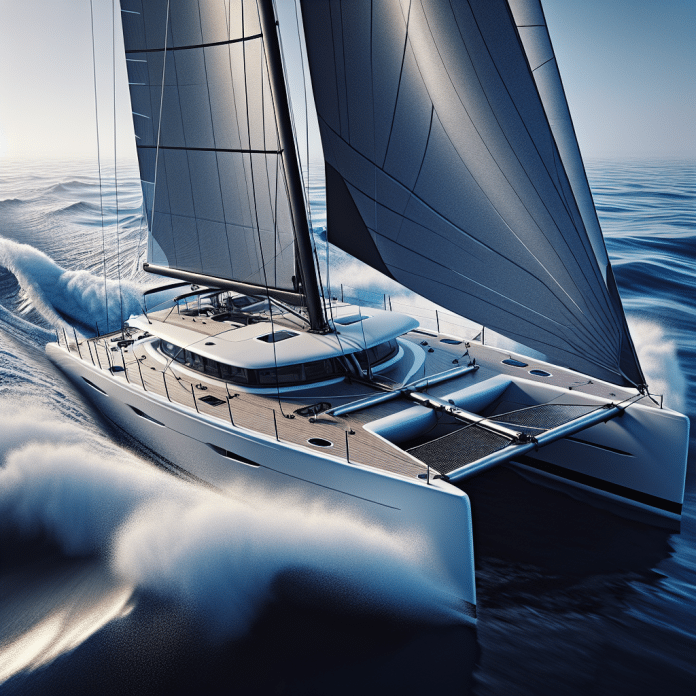
Looking to embark on an unforgettable adventure on the open waters? Look no further than our comprehensive Catamaran Sailing Guide. In this article, we will delve into the fascinating world of catamarans, exploring everything from the different types of boats and rigging, to indispensable tips for an enjoyable and safe sailing experience. Whether you’re a seasoned sailor or a complete novice, this guide aims to equip you with the knowledge necessary to navigate the thrilling world of catamaran sailing. Get ready to set sail and discover the wonders that await you on the horizon.
Review contents
Choosing the Right Catamaran
When it comes to choosing the right catamaran for your sailing adventures, there are a few key factors to consider. The hull type, size, capacity, and performance versus cruising capabilities all play a crucial role in finding the perfect catamaran for your needs.
Catamarans come in various hull types, each with its own set of advantages and disadvantages. The most common hull types are solid, balsa core, foam core, and carbon. Solid hulls offer durability and strength but may be heavier and less fuel-efficient. Balsa core hulls provide good insulation and strength-to-weight ratio, while foam core hulls offer excellent buoyancy and lightness. Carbon hulls are the most lightweight and rigid but come with a higher price tag.
When choosing the right hull type, consider factors such as your sailing style, budget, and desired performance. It’s essential to understand the pros and cons of each hull type to make an informed decision.
Size and Capacity
The size and capacity of a catamaran are crucial considerations, depending on your sailing goals. Smaller catamarans, typically between 30 to 40 feet, are easier to handle and navigate, making them ideal for solo sailors or those new to catamaran sailing. On the other hand, larger catamarans, ranging from 40 to 60 feet or more, offer ample space for accommodation, amenities, and extended trips.
Consider the number of people you plan to sail with and the amount of storage and living space you require. It’s important to strike a balance between comfort and maneuverability when choosing the size and capacity of your catamaran.
Performance vs. Cruising
Another essential factor to consider when choosing a catamaran is whether you prioritize performance or cruising capabilities. Performance catamarans are designed for speed and agility, featuring lightweight construction, tall rigs, and high-tech materials. They provide exhilarating sailing experiences but might sacrifice some comfort and amenities.
Cruising catamarans, on the other hand, offer spacious living areas, numerous amenities, and stability. They prioritize comfort and leisure, making them perfect for extended trips and living aboard. However, they may not have the same speed and maneuverability as performance-oriented catamarans.
Consider your sailing goals and preferences to determine whether you prioritize performance or cruising capabilities. Consulting with experienced catamaran sailors or attending boat shows can also provide valuable insights into finding the right balance between the two.
Understanding Catamaran Rigging
To fully grasp the ins and outs of catamaran sailing, it’s important to understand the various components of catamaran rigging. From the mast and boom to the sails, standing rigging, and running rigging, each element plays a crucial role in the performance and handling of the catamaran.
Mast and Boom
The mast and boom act as the backbone of the catamaran rigging system. The mast supports the sails and facilitates their proper functioning, while the boom controls the shape and tension of the main sail. It’s essential to choose a mast and boom that are suitable for your catamaran’s size, sailing style, and intended use.
Consider factors such as material construction, height, and compatibility with the sails when selecting the right mast and boom. Consulting with rigging professionals or experienced catamaran sailors can provide valuable guidance in making an informed decision.
Sails are one of the most crucial components of catamaran rigging, as they harness the power of the wind and propel the catamaran forward. The main sail, genoa or jib, and spinnakers are the primary types of sails used in catamaran sailing.
The main sail is the largest and most important sail, responsible for driving the catamaran forward. The genoa or jib is a smaller headsail that complements the main sail, providing additional power and maneuverability. Spinnakers are specialized downwind sails that excel in light wind conditions.
Choosing the right sails involves considering factors such as sail material, size, and shape to suit your catamaran’s rigging and sailing goals. Working closely with sailmakers or experienced catamaran sailors can help ensure you select the most suitable sails for your catamaran.
Standing Rigging
Standing rigging refers to the fixed components of the catamaran’s rigging system that support the mast and provide stability. This includes elements such as stays, shrouds, and rigging wires.
It’s crucial to regularly inspect and maintain the standing rigging to ensure its structural integrity and minimize the risk of failure. Look for signs of wear and tear, corrosion, or any loose fittings that need immediate attention. Consulting with rigging professionals or experienced catamaran sailors can help you develop a comprehensive maintenance routine for your standing rigging.
Running Rigging
Running rigging refers to the adjustable components of the catamaran’s rigging system that control sail shape and trim. This includes elements such as halyards, sheets, and control lines.
Understanding how to properly trim and adjust the running rigging is essential for optimal sail performance and handling. Familiarize yourself with the purpose and function of each line, learning how to adjust them for different sailing conditions and maneuvers. Practice and experimentation will help you develop the necessary skills to make the most of your catamaran’s running rigging.
Essential Equipment for Catamaran Sailing
When setting sail on a catamaran, having the right equipment on board is crucial for a safe and enjoyable experience. From navigation instruments to safety equipment, anchoring gear, and communication devices, each item serves a specific purpose in enhancing your sailing journey.
Navigation Instruments
Accurate navigation is essential for catamaran sailors, ensuring they can safely navigate their intended course and avoid potential hazards. Some essential navigation instruments for catamaran sailing include a chartplotter or GPS, compass, depth sounder, and VHF radio.
A chartplotter or GPS provides real-time position and navigation information, allowing you to plot your course and stay on track. A compass serves as a reliable backup for navigation, especially in case of electronic failures. A depth sounder helps you monitor the water depth to avoid running aground, while a VHF radio enables communication with other vessels and emergency services.
Ensure you have these navigation instruments on board and understand how to use them effectively for a safe and confident sailing experience.
Safety Equipment
Ensuring the safety of you and your crew is of utmost importance when venturing out on a catamaran. Essential safety equipment to have on board includes life jackets, a first aid kit, fire extinguishers, flares, and a man overboard (MOB) retrieval system.
Life jackets should be readily accessible and properly fitted for every crew member. A well-equipped first aid kit is essential for treating minor injuries and providing basic medical care until professional help can be reached. Fire extinguishers help extinguish potential onboard fires, while flares serve as distress signals in emergency situations. A MOB retrieval system, such as a throwable buoy or sling, aids in quickly recovering a crew member who has fallen overboard.
Regularly inspect and maintain your safety equipment to ensure its effectiveness and readiness in case of emergencies.
Anchoring Gear
Anchoring is a common practice for catamaran sailors to secure their vessel in a particular location. Having the right anchoring gear is essential for a secure and stable anchorage. Anchoring gear typically includes an anchor, chain, and rode.
Choose an anchor that suits your catamaran’s size and the type of seabed you plan to anchor on. A general rule of thumb is to select an anchor that weighs approximately one pound per foot of your catamaran’s length. The chain provides additional weight and helps keep the anchor in place, while the rode (rope or combination of rope and chain) connects the anchor to your catamaran.
Understanding anchoring techniques and practicing anchoring in different conditions will enhance your confidence and proficiency in this important aspect of catamaran sailing.
Communication Devices
Maintaining communication with other vessels and shore-based services is crucial for catamaran sailors. Communication devices such as a VHF radio and a mobile phone or satellite phone provide means of communication in different situations.
A VHF radio allows you to communicate with nearby vessels, seek assistance in case of emergencies, and stay updated with weather information. A mobile phone or satellite phone provides an additional communication channel, especially when sailing in remote areas where VHF coverage may be limited.
Ensure your communication devices are fully charged, in good working condition, and stored in a waterproof case to protect them from water damage .
Preparing for a Catamaran Sailing Trip
Preparing adequately for a catamaran sailing trip is essential to ensure a smooth and enjoyable experience. From provisioning to checking weather forecasts, boat systems, and conducting a safety briefing, each step contributes to a successful voyage.
Provisioning
Provisioning involves stocking your catamaran with the necessary food, beverages, and supplies for the duration of your trip. Consider the number of people onboard, the duration of the trip, and any specific dietary requirements or preferences.
Plan your meals and create a comprehensive shopping list to ensure you have an adequate supply of fresh produce, non-perishable goods, water, and other essentials. Allocate storage space and organize the provisions on the catamaran to ensure easy access and minimize spoilage.
Regularly check your provisions throughout the trip, making adjustments as necessary to ensure you have enough supplies for the intended duration.
Checking Weather Forecasts
Checking weather forecasts is a crucial step before setting sail on a catamaran. Understanding the current and predicted wind conditions, tides, and potential weather patterns helps you plan your route, adjust your sailing schedule, and ensure the safety of your crew and vessel.
Consult reputable weather forecasting services, such as local meteorological offices or dedicated marine weather websites or apps. Look for updates on wind speed and direction, wave heights, and any significant weather events or warnings that may affect your sailing plans.
Keep in mind that weather conditions can change rapidly, especially at sea, so regularly monitor the forecasts throughout your trip and adjust your plans accordingly.
Checking Boat Systems
Before embarking on a catamaran sailing trip, it’s important to thoroughly check and test all the boat systems to ensure they are in proper working order. This includes the engine, electrical systems, plumbing, navigation instruments, and safety equipment.
Inspect the engine for any signs of leaks, ensure all fluid levels are adequate, and test its starting and running capabilities. Check the electrical systems, including battery levels, lights, and charging capabilities. Test the plumbing system, including freshwater and wastewater systems, to ensure there are no leaks or blockages. Verify the functionality of the navigation instruments, such as the chartplotter, compass, and VHF radio. Finally, inspect and test all safety equipment, including life jackets , fire extinguishers, and emergency signaling devices.
Address any issues or malfunctions promptly, seeking professional help if necessary, to ensure the reliability and safety of your catamaran systems.
Safety Briefing
Conducting a safety briefing before setting sail is essential to ensure that all crew members are familiar with the catamaran’s safety procedures and emergency protocols.
Discuss emergency procedures, including man overboard (MOB) response, fire safety, and abandon ship protocols. Familiarize the crew with the location and usage of safety equipment, such as life jackets, flares, and fire extinguishers. Clarify roles and responsibilities during different sailing maneuvers and emergency situations.
Encourage open communication among the crew and address any questions or concerns they may have. A comprehensive safety briefing sets the foundation for a safe and confident sailing experience.
Basic Catamaran Sailing Techniques
Developing a solid foundation of basic catamaran sailing techniques is essential for smooth maneuvering and control over your vessel. From steering and sail trim to tacking and gybing, mooring and docking, and maneuvering in different conditions, each technique contributes to your overall skill as a catamaran sailor.
Steering and Sail Trim
Steering and sail trim are foundational skills for catamaran sailing. Understand how to use the catamaran’s steering mechanism, such as a helm or tiller, to control the direction of the vessel. Practice various steering techniques, such as using the wind to assist with turning, to maximize maneuverability.
Sail trim involves adjusting the sails to achieve the desired shape and tension, optimizing their performance. Learn how to adjust the main sail’s halyard, sheet, and traveler to control the sail’s shape and power. Similarly, understand how to trim the genoa or jib to balance the sails and achieve optimal speed.
Experiment with different sail trim settings in different wind conditions to develop a sense of how each adjustment affects the catamaran’s performance.
Tacking and Gybing
Tacking and gybing are maneuvers used to change the direction of the catamaran in relation to the wind. Tacking involves turning the bow of the catamaran through the wind, while gybing involves turning the stern through the wind.
Practice tacking and gybing in a wide, open area with ample room to maneuver. Understand how changes in the wind and sail trim affect the maneuver. Start with slow, controlled maneuvers and gradually increase speed as you gain confidence.
Maintain clear communication with your crew during tacking and gybing to ensure a smooth and coordinated maneuver.
Mooring and Docking
Mooring and docking are essential skills for safely approaching and securing your catamaran in various locations. Practice approaching a mooring buoy or a dock from different angles and in various wind and current conditions.
Learn how to use fenders and lines effectively to protect your catamaran and prevent damage during mooring or docking. Familiarize yourself with different mooring and docking techniques, such as using spring lines or utilizing thrusters if your catamaran is equipped with them.
Engage in regular practice sessions in controlled environments to build confidence and enhance your mooring and docking skills.
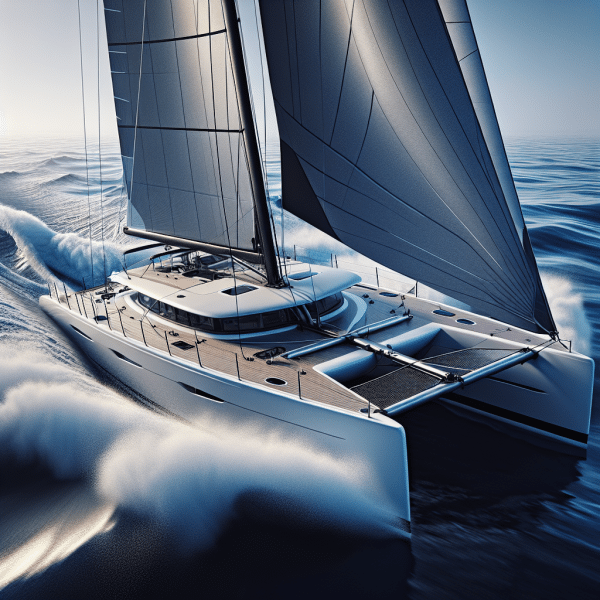
Maneuvering in Different Conditions
Catamarans handle differently in various wind and sea conditions. Understanding how to maneuver your catamaran effectively in different situations is crucial for maintaining control and safety.
Practice sailing in different wind strengths and directions, experiencing the effects of waves and currents on the catamaran’s maneuverability. Learn how to adjust sail trim, steering techniques, and weight distribution to optimize performance in light winds, strong winds, upwind sailing, and downwind sailing.
By practicing maneuvering techniques in various conditions, you’ll develop the experience and skills necessary to safely navigate your catamaran in any scenario.
Advanced Sailing Techniques for Catamarans
Once you have mastered the basic catamaran sailing techniques , you can explore more advanced maneuvers and techniques. These advanced sailing techniques allow you to maximize the speed, efficiency, and overall performance of your catamaran.
Powering Upwind
Sailing upwind in a catamaran can be challenging due to their wide beam and reliance on sails for propulsion. Powering upwind requires proper sail trim, weight distribution, and understanding how to use the catamaran’s hulls to generate lift and reduce drag.
Experiment with different sail trim settings, such as adjusting the mainsail traveler position and genoa or jib sheet tension. Shift crew weight to windward to balance the catamaran and increase its ability to sail close to the wind. Learn to anticipate wind shifts and adjust course and sail trim accordingly to maintain the best angle of attack.
With practice and experience, you’ll be able to efficiently sail upwind in your catamaran, maintaining good speed and pointing ability.
Downwind Sail Techniques
Sailing downwind in a catamaran presents a different set of challenges compared to upwind sailing. Mastering downwind sail techniques allows you to harness the wind efficiently, maintain control, and achieve the desired speed.
One popular downwind sail technique for catamarans is using a spinnaker. Asymmetrical spinnakers are particularly suited for catamarans, as they offer ease of handling and optimal power in light wind conditions. Learn how to rig, set, and trim a spinnaker to minimize drag, maintain stability, and increase speed.
Practice gybing with a spinnaker to ensure smooth and controlled transitions. It’s essential to communicate with your crew to coordinate maneuvers and ensure the safety of the spinnaker during gybes.
Using Asymmetrical Spinnakers
Asymmetrical spinnakers are versatile downwind sails that offer excellent performance in light wind conditions. Unlike traditional symmetrical spinnakers, asymmetrical spinnakers are designed to be flown from a fixed point on the bow of the catamaran.
Learn how to rig and set an asymmetrical spinnaker, ensuring it is properly hoisted, trimmed, and controlled. Experiment with different angles and positions to find the optimal sailing angle for your catamaran and the specific wind conditions.
Asymmetrical spinnakers require precise coordination and communication among the crew during maneuvers such as setting, gybing, and dousing. Regular practice sessions in controlled environments will help you master the use of asymmetrical spinnakers in a catamaran.
Sailing in Strong Winds
Sailing in strong winds can be exhilarating but also challenging, requiring advanced sailing techniques to maintain control and manage the inherent forces at play. It’s crucial to have a proper understanding of how to handle the catamaran in strong winds to ensure the safety of the crew and vessel.
Reduce sail area and adjust sail trim to depower the catamaran and prevent excessive heeling or overpowering. Maintain an upright position to avoid capsizing or tripping a hull. Consider reefing the sails or changing to a smaller headsail to reduce sail area and increase control.
Anticipate gusts and shifts in wind direction, adjusting course and sail trim to maintain balance and prevent broaching or weather-cocking.
By developing advanced techniques and gaining experience in sailing in strong winds, you’ll be able to confidently navigate your catamaran in challenging conditions.
Maintenance and Upkeep of Catamarans
Maintaining and regularly inspecting your catamaran is essential for its longevity and continued performance. From hull care to rigging inspections, sail maintenance, and engine maintenance, each aspect of maintenance and upkeep plays a crucial role in ensuring your catamaran is in top condition.
Caring for the hull of your catamaran is vital to protect it from damage and maintain its structural integrity. Regularly clean the hull, removing any marine growth or dirt buildup that can cause drag and reduce speed. Inspect the hull for any signs of cracks, blisters, or damage, addressing them promptly to prevent further deterioration.
Apply antifouling paint to the hull to inhibit the growth of marine organisms. This helps maintain the efficiency and performance of the catamaran, reducing fuel consumption and minimizing the risk of damage from fouling.
Additionally, regularly check and maintain the seaworthiness of the hull’s structure, including bulkheads, keels, and rudders, as any damage or weakness can compromise the safety and stability of the catamaran.
Rigging Inspections
The rigging of your catamaran requires regular inspections to ensure its integrity and proper functioning. This includes the mast, boom, standing rigging, running rigging, and associated hardware.
Inspect the mast and boom for any signs of corrosion, cracks, or deformation. Check the standing rigging, such as shrouds and stays, for any wire breaks or signs of wear. Inspect the running rigging, including halyards and sheets, for fraying, chafing, or damage.
Address any issues immediately, replacing any damaged or worn components to maintain the safety and performance of your catamaran.
Sail Maintenance
Sails are a significant investment and require proper care and maintenance to extend their lifespan and preserve their performance. Regularly inspect your sails for any signs of wear, tears, or UV damage. Address minor repairs promptly to prevent further damage.
Clean your sails regularly to remove dirt, salt, and other contaminants that can degrade the fabric. Use appropriate sail cleaning products and follow the manufacturer’s recommendations. Properly flake or fold your sails when not in use to minimize creases and prevent damage from prolonged storage.
Consider having your sails professionally inspected and serviced to ensure optimal performance and longevity.
Engine Maintenance
The engine is a crucial component of a catamaran, providing auxiliary power for maneuvering and motoring when necessary. Regular engine maintenance is essential to maintain reliability and prevent breakdowns.
Follow the manufacturer’s guidelines for regular maintenance, including oil and filter changes, checking fluid levels, and inspecting belts and hoses. Clean the engine’s cooling system and heat exchanger regularly to prevent overheating.
Regularly inspect the engine’s fuel system, including filters and lines, for any signs of contamination or blockages. Clean the fuel tank periodically to remove any sediment or water buildup.
Have your engine professionally serviced at recommended intervals to ensure it remains in top working condition.
Dealing with Common Challenges
Catamaran sailing, like any other maritime activity, comes with its own set of challenges and potential obstacles. Understanding and addressing these challenges is essential for a safe and enjoyable sailing experience.
Nautical Terms and Language
The maritime world has its own unique set of nautical terms and language, which can be overwhelming for beginners. Take the time to familiarize yourself with common nautical terms, such as starboard, port, bow, stern, and understand their meanings and usage.
Reading books or online resources on sailing terminology can help you grasp the basics. Spending time on the water and engaging with experienced sailors also provides valuable opportunities to learn and practice using nautical terms in context.
Seasickness Prevention and Remedies
Seasickness is a common challenge for many sailors, especially when venturing into rough seas or unfamiliar waters. To prevent or alleviate seasickness, there are several strategies and remedies you can try.
Maintain a well-rested and hydrated state before setting sail. Avoid consuming heavy or greasy meals and alcohol, as they can exacerbate seasickness symptoms. Focus on keeping your eyes on the horizon or a fixed point on land to help with spatial orientation.
Consider using seasickness remedies such as over-the-counter medications, wristbands, or natural remedies like ginger-based products. Experiment with different remedies to find what works best for you and consult with a healthcare professional if needed.
Handling Emergencies at Sea
Emergencies can arise unexpectedly when sailing, and being prepared to handle them is crucial for the safety of the crew and the catamaran. Develop an emergency action plan that includes procedures for medical emergencies, man overboard situations, fire onboard, or severe weather events.
Regularly conduct drills and practice emergency procedures with your crew, ensuring everyone understands their roles and responsibilities. Familiarize yourself with the operation of safety equipment, including life rafts, EPIRBs (Emergency Position Indicating Radio Beacons), and flares.
Carry out regular safety equipment checks, ensuring they are easily accessible and in good working condition. Regularly review and update your emergency action plan based on lessons learned and changes in crew composition or sailing areas.
Dealing with Inclement Weather
Inclement weather can pose significant challenges and potential hazards when sailing a catamaran. Regularly monitoring weather forecasts and being prepared to make informed decisions is essential.
Avoid sailing in severe weather conditions, and always err on the side of caution when it comes to the safety of your crew and vessel. Develop a safe strategy for seeking shelter or a safe haven in case of rapidly deteriorating weather conditions.
Learn how to handle sudden wind shifts, squalls, and thunderstorms by reducing sail area and maintaining control over the catamaran. Practice reefing techniques and develop a plan for quickly and effectively reducing sail when needed.
By staying vigilant and prepared, you can safely navigate inclement weather and minimize potential risks.
Tips for Catamaran Sailing in Specific Locations
Catamaran sailing in different locations presents unique challenges and opportunities. Consider these tips when sailing in specific regions to enhance your experience and make the most of the local conditions.
Sailing in the Caribbean
The Caribbean offers a vast playground for catamaran sailors, with its turquoise waters, consistent trade winds, and breathtaking landscapes. When sailing in the Caribbean, consider the following tips:
- Research the various islands and cruising areas to plan your itinerary based on your preferences and interests.
- Take advantage of the easterly trade winds for relaxed downwind sailing and explore remote anchorages.
- Be mindful of hurricane seasons and ensure your catamaran is properly prepared or relocated outside of hurricane zones.
Sailing in the Mediterranean
The Mediterranean Sea is a popular destination for catamaran sailors, offering a rich blend of cultures, history, and stunning coastlines. Consider these tips when sailing in the Mediterranean:
- Research the local regulations and customs of each country you plan to visit, as rules and procedures can vary.
- Be prepared for the meltemi winds in the Aegean Sea, which can be strong and gusty, especially in the summer months.
- Take advantage of the Mediterranean cuisine and explore the local gastronomy and regional specialties.
Sailing in the Pacific
The Pacific Ocean presents diverse and captivating catamaran sailing opportunities, from the stunning islands of French Polynesia to the vast ruggedness of the Pacific Northwest. Consider these tips when sailing in the Pacific:
- Pay attention to the local weather patterns and seasonality, as conditions can vary significantly across the vast Pacific.
- Familiarize yourself with the customs and regulations of each country or island you plan to visit.
- Embrace the unique marine life and coral reefs found in Pacific destinations, ensuring responsible and sustainable practices while snorkeling or diving.
Sailing in Coastal Areas
Coastal sailing offers a mix of close-to-shore navigation, diverse scenery, and the opportunity to explore various anchorages and towns. Consider these tips when sailing in coastal areas:
- Familiarize yourself with local charts, tide tables, and navigation aids to ensure safe passage in shallow or unfamiliar waters.
- Plan your itinerary, taking into account the availability of marinas, anchorages, and places of interest along the coast.
- Be aware of potential coastal weather patterns such as sea breezes, fog, or strong currents, adapting your sailing strategy accordingly.
Catamaran Sailing for Beginners
If you’re new to catamaran sailing, there are several steps you can take to start your journey and build your confidence as a sailor.
Taking Sailing Lessons
Enroll in a structured sailing course, specifically tailored for catamarans, to learn the fundamentals of catamaran sailing. These courses typically cover topics such as basic maneuvers, sail trim, navigation, and safety procedures.
Attending sailing lessons provides a structured and comprehensive approach to learning catamaran sailing and ensures you receive proper instruction and guidance from qualified instructors.
Joining Sailing Clubs and Communities
Joining sailing clubs and communities offers an excellent opportunity to connect with experienced catamaran sailors, share knowledge, and gain practical insights. Many sailing clubs organize regular events, races, or group outings where you can participate and learn from experienced sailors.
Participating in club activities not only enhances your skills but also allows you to build a network of like-minded sailors who can offer advice, support, and camaraderie.
Gaining Experience through Crewing
Crewing on other catamarans is a valuable way to gain experience and expand your skills as a catamaran sailor. Reach out to catamaran owners or charter companies to inquire about crewing opportunities, especially during regattas or extended trips.
Crewing exposes you to different catamaran models, sailing styles, and conditions, allowing you to learn from experienced skippers and crew members. It also provides an opportunity to practice various sailing techniques, refine your knowledge, and build your confidence.
Building Confidence as a Sailor
Building confidence as a sailor takes time and practice. Engage in regular sailing trips, varying your routes and conditions, to challenge yourself and further refine your skills. Set achievable goals and gradually push your limits to gain experience and expand your comfort zone.
Take advantage of opportunities to skipper your catamaran, even if it’s just for short day sails or weekend excursions. This enables you to apply and consolidate what you have learned, building self-assurance and proficiency in handling your own catamaran.
Reviewing and reflecting on your sailing experiences, learning from mistakes, and seeking advice and feedback from experienced sailors contributes to your growth as a confident catamaran sailor.
In conclusion, catamaran sailing offers a world of adventure and discovery for those seeking a unique and exhilarating experience on the water. By understanding the different aspects of catamaran selection, rigging, equipment, sailing techniques, and maintenance, you can embark on a safe and enjoyable catamaran sailing journey. Whether you’re a beginner or an experienced sailor, there are always new skills to learn and destinations to explore. So, hoist your sails, feel the wind on your face, and set off on your catamaran sailing adventure!
RELATED ARTICLES MORE FROM AUTHOR
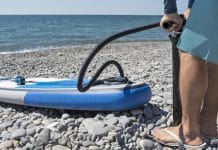
How long can I leave my iSUP inflated?

Inflatable vs Hard Paddle Board: Which Is Best To Buy?

Inflatable Stand Up Paddle Boards: Everything You Need To Know
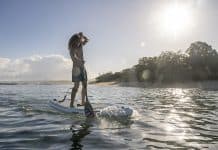
SUP for beginners and introducing the Stand Up Paddle Board

The Best Blow Up Paddle Boards For Every Budget

A Beginner’s Guide To Body Glove Paddle Board

POPULAR POSTS on SUP Noob

Paddle Boards: Inflatable & Solid SUP Boards

Paddle Board vs Kayak Reddit

Ultimate Guide to SUP Fishing: Tips from...

How to SUP paddle board: Guide to...

How To Perfectly Set Up Your Bote...

Dama SUP paddle board: The Board You...

Five Reasons To Try A Feath R...

High Society Freeride Sup Paddle Board Reviews

10 Things To Know About The Multi-Person...

SUP Fitness and Weight Loss Benefits

Lightweight Paddle Board SUP For The Perfect...

SUP Board & Paddle Board Paddle Buying...

Fly Fishing from a Stand Up Paddle...

Basic Things To Know About The Lifetime...

Paddleboard Yoga Positions

How to Be Better at SUP Fishing

Get Your Outdoors On With These Paddle...

What Is SUP – Stand Up Paddling?

A Quick History Of Stand Up Paddle...

5 Life Jacket Tips That Will Save...
- Privacy Policy
- Privacy Notice For California Residents
- Shipping Policy
- GDPR Cookie Policy
- Refund policy
- Terms and conditions
- Basic Things To Know About The Lifetime Horizon 100 Stand Up Paddle Board SUP
- MaxKare SUP: The Inflatable Stand-up Paddle Board You Can Carry Around Easily

Home » Blog » Gear » Downwind sails demystified: how to choose a downwind sail for cruising
Downwind sails demystified: how to choose a downwind sail for cruising
By Author Fiona McGlynn
Posted on Last updated: February 15, 2023
Downwind sail terminology can be baffling! If you’re looking to build out your downwind sail inventory for cruising you may find yourself awash with spinnaker codes, headsail overlap percentages, and trying to understand the difference between an asymmetric spinnaker, gennaker, and cruising chute.
But don’t despair, the good news is: it’s not that complicated . All the marketing jargon aside, there are really just three types of downwind sails commonly used by cruisers and I’m going to cover them in this post.
- Asymmetric spinnakers
Symmetric spinnakers
We’ll also briefly touch on Code sails.
Sure there are more exotic downwind sail options like Parasailers and Blue Water Runners, but the three sails above tend to be the staples in most cruising sail wardrobes.
Also, if you’re looking to buy a downwind sail, be sure to check out our post on buying used sails . Buying second-hand sails is a good way to build out your sail inventory without breaking the bank.
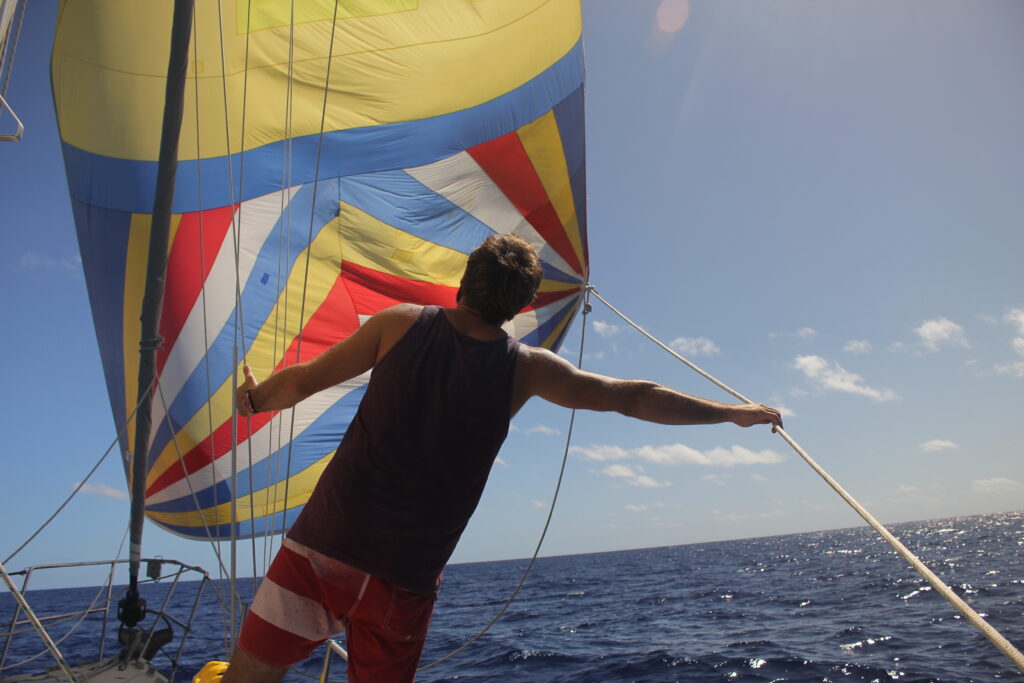
What is the best sail for downwind sailing?
No single sail is going to do everything well. Downwind sails achieve peak efficiency at different apparent wind angles and conditions, which is why performance-oriented boats carry a large inventory of sails. For example, Vendee Globe skippers carry 9 sails (their allowable limit).
As cruisers, we don’t have this luxury. Instead, we make do with fewer, less specialized, sails that can be used over a wide range of wind angles and conditions.
The best sail for downwind sailing is going to depend on your boat, your crew, and what you’re trying to achieve.
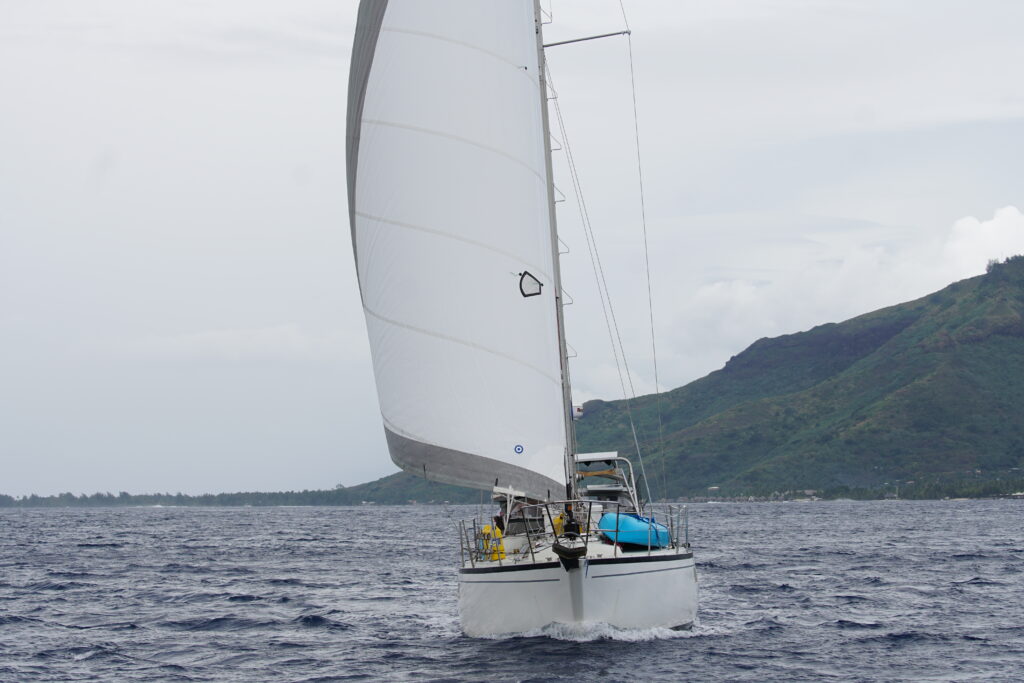
Considerations for choosing a downwind sail
Boat and rig.
How heavy is your boat and what type of rig does it have? How much space do you have for storing sails?
It’s important to know your boat’s most efficient downwind sailing angle and then choose a sail that performs well at that angle.
Modern, light, flat-bottomed boats often sail faster on a reach, whereas older, heavy-displacement cruisers don’t achieve the same gains from reaching.
You’ll also want to consider your rig and existing sail plans. As we’ll see later in this post, fractional and masthead rig boats will have slightly different downwind sail requirements.
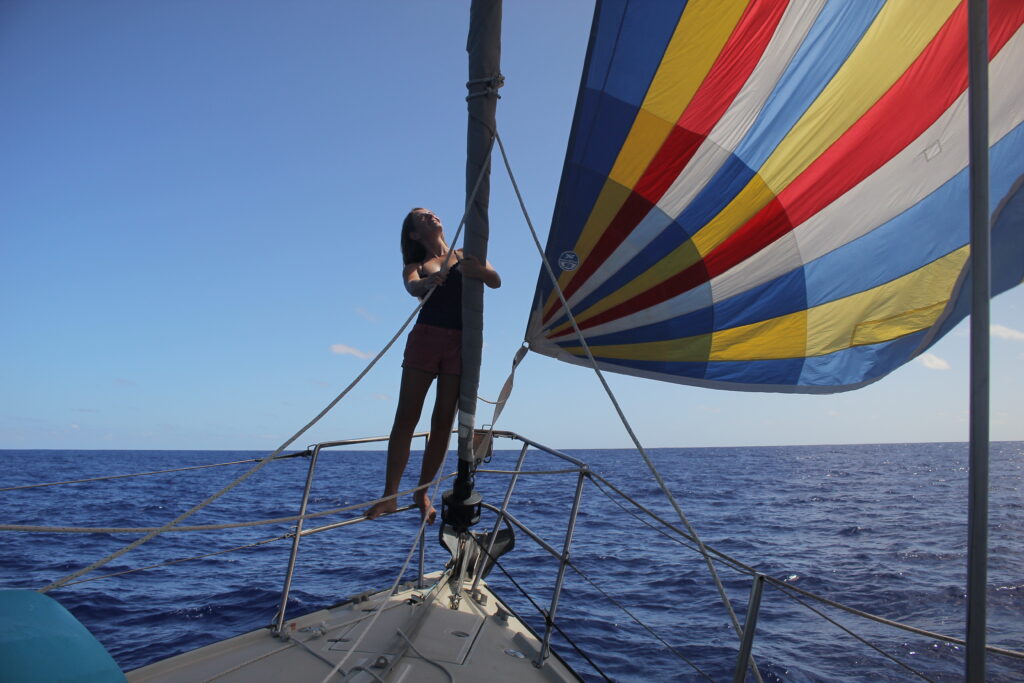
Crew and experience level
Will you have six people onboard or be sailing single-handed? Are your crew newbies or ocean veterans? Are you comfortable handling a pole and working on the foredeck?
Certain downwind sails are more challenging to fly than others. For instance, a symmetrical spinnaker is a lot more effort to launch, fly, and douse, than a genoa on a roller furler.
Often short-handed crews (couples, single-handers, and families with small kids) find that spinnakers are too much work and choose to fly white sails alone. Even the most energetic sailors may find that sleep deprivation on a long passage can sap the fun out of elaborate sail changes.
We, like many cruisers, are very conservative. On our Pacific crossing, I can count the number of times we flew a spinnaker on two hands.
However, now that we have more bluewater miles under our keel, I’m a lot more eager to break out the kite. On our next ocean passage, I can see it playing a bigger role in our downwind repertoire.
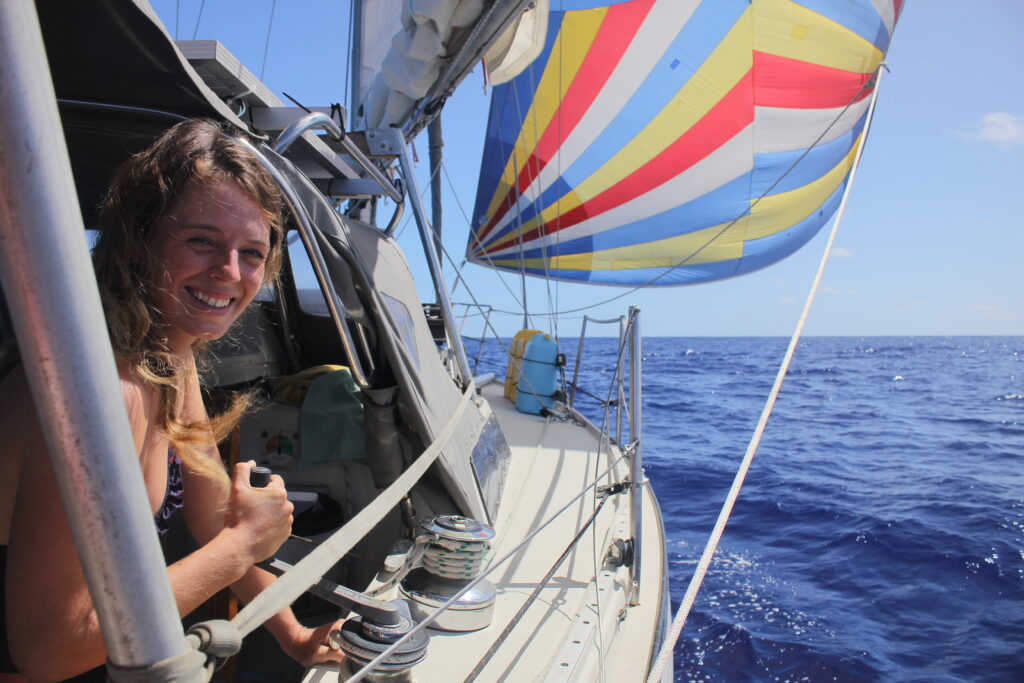
What are your sailing goals?
Do you aspire to complete an Atlantic or Pacific crossing? Do you enjoy racing your cruiser? Are you content to motor sail?
The type of sailing will influence what downwind sails you carry.
For instance, if you’re planning on bluewater cruising, your focus might be on durable, heavyweight sails that can handle a squall and stand up to the rigors of an ocean crossing.
Consider how much you want to use your engine. If you’re planning long passages where you don’t have enough fuel to motor, you may want to invest in a light air sail.
Reach out to other sailors with similar boats who are doing the type of sailing you’re interested in and find out what they’re using.
Types of downwind sails
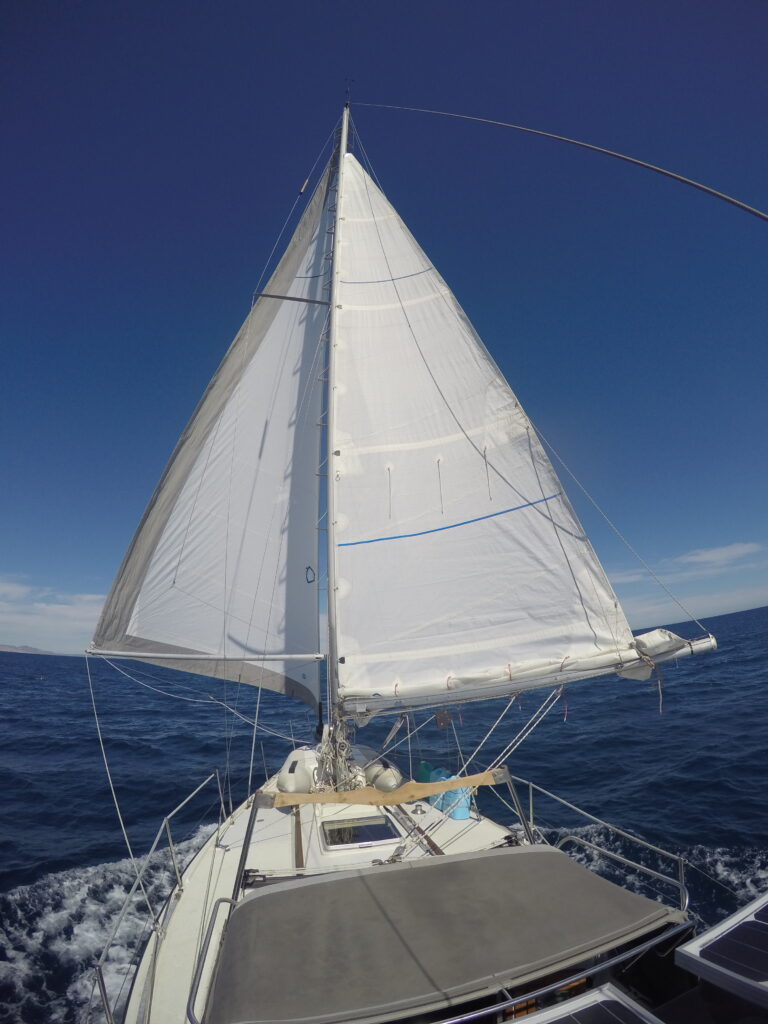
Genoas on roller furlers are hard to beat for downwind sailing. They’re robust, easy for a single person to manage on a roller furler, and make for a stable, stress-free downwind sail.
They can become problematic in light air and ocean swell when they tend to flog. The best way to avoid this is to pole out the genoa.
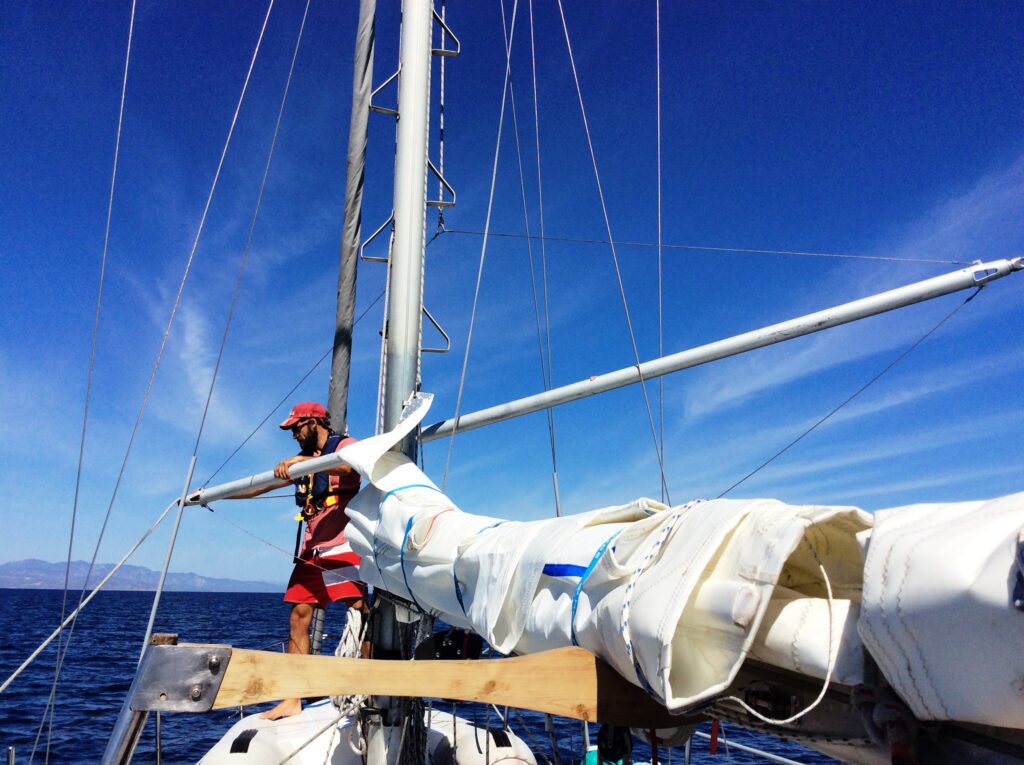
Poled out genoa
Sailing downwind with a poled-out genoa was our go-to setup for much of our 2017 Pacific crossing.
It seems to be a favorite with Atlantic skippers too. Yachting World surveyed 276 ARC skippers to learn about their sail and sail handling systems. “Despite most yachts carrying a spinnaker or offwind sail, over 60 skippers commented that using a poled-out foresail was the most effective downwind option, with twin headsails proving the next most popular.“
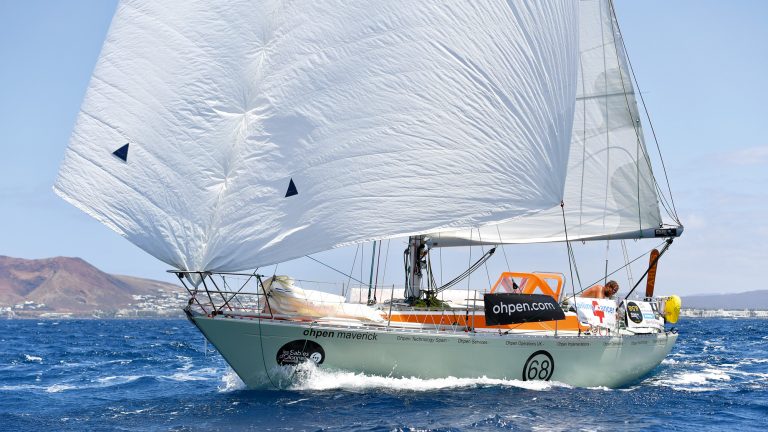
Twin headsails
Twin headsails are another great option, and one I would consider for our next ocean passage.
Many roller furlers have a second luff groove so you can fly two headsails at the same time, one to each side. This gives you a large sail area, while still making it easy to reef from the cockpit.
Again, you may need to pole out one sail and sheet the other to the end of a boom that’s been locked off with a boom preventer in order to prevent flogging.
Speaking of which, if you’re planning on doing a lot of downwind sailing I highly recommend using a boom brake or preventer for limiting the risks associated with an accidental gybe.
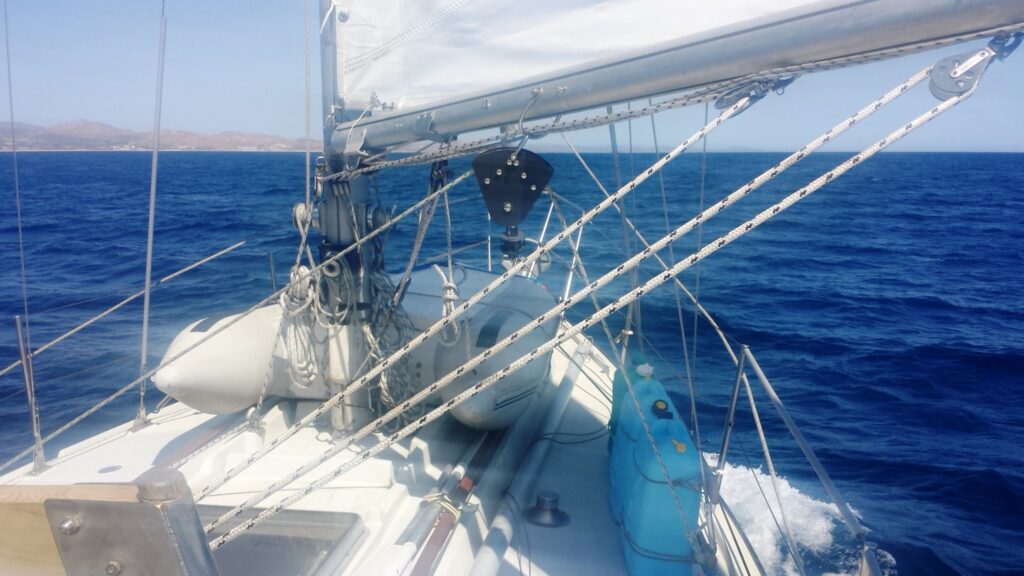
Headsail types
Headsails are categorized by their Luff Perpendicular percentage (LP%), which describes a headsail’s size/overlap relative to the boat’s J dimension (from where the forestay connects to the bow to the base of the mast). Larger sails, with more overlap, have higher percentages.
Generally speaking, 130-135% headsails are pretty common sizes on cruising boats. We had a 130% genoa on our 1979 Dufour 35.
If you have a fractional rig with a non-overlapping headsail, you could use a Code Zero (more on that below) either poled out or flown as twin headsails.
- Stable and comfortable
- Easy to deploy and reef on a roller furler
- Covers a wide range of wind angles and wind speeds
- Dacron is durable and not prone to damage
- Requires a spinnaker pole or whisker pole in lighter wind conditions and swell
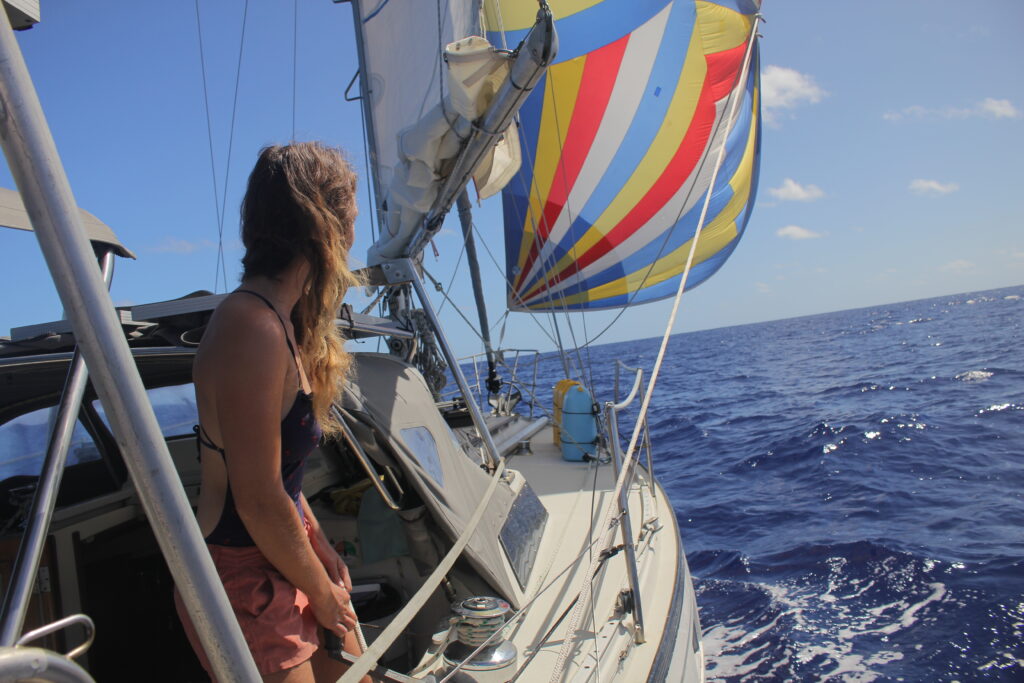
Asymmetric spinnaker
Asymmetric spinnakers (also known as gennakers and cruising chutes) can be thought of as a blend between a spinnaker and a genoa.
They’re ideal for sailing in light conditions. We usually doused ours when windspeeds increased to 15 knots.
Most of the time, they’re flown like a genoa, with the tack attached to the foresprit or bow, and the clew trimmed with a sheet. However, it’s also possible to sail an asymmetrical spinnaker in more of a symmetrical configuration .
Many short-handed crews (including ourselves) prefer asymmetric spinnakers to symmetric spinnakers because they’re a lot easier to sail and often don’t require a pole.
It’s possible to put asymmetric spinnakers on a roller furler, but this generally requires a flatter sail and limits the wind angles you can sail at to 135-145 degrees.
For fuller shapes, there are other options for taming your sail. A snuffer sock (a.k.a. spinnaker sleeve) consists of a tapered fabric sleeve that can be raised and lowered over a sail. According to Yachting World’s 2019 ARC Survey , 57% of skippers used a snuffer sock on their boats.
Asymmetric spinnaker types
You may have heard cruisers referring to their A-sails. The “A” stands for asymmetric and is preceded by a number that designates whether the sail design is for light air or heavy air—the higher the number the heavier the air.
The number also tells you whether it’s a reaching or running sail, with odd numbers for reaching and even numbers for running.
- 1A Light Air Reaching Asymmetric
- 2A Light Air Running Asymmetric
- 3A Heavy Air Reaching Asymmetric
- 4A Heavy Air Running Asymmetric
- 5A Extreme Wind Asymmetric
- Can point higher than a symmetrical spinnaker
- Easier to fly than a symmetrical spinnaker
- Not always necessary to use a pole
- Great in light winds
- More work than a headsail on a roller furler
- Only appropriate for light air
- Lightweight nylon fabrics more prone to damage
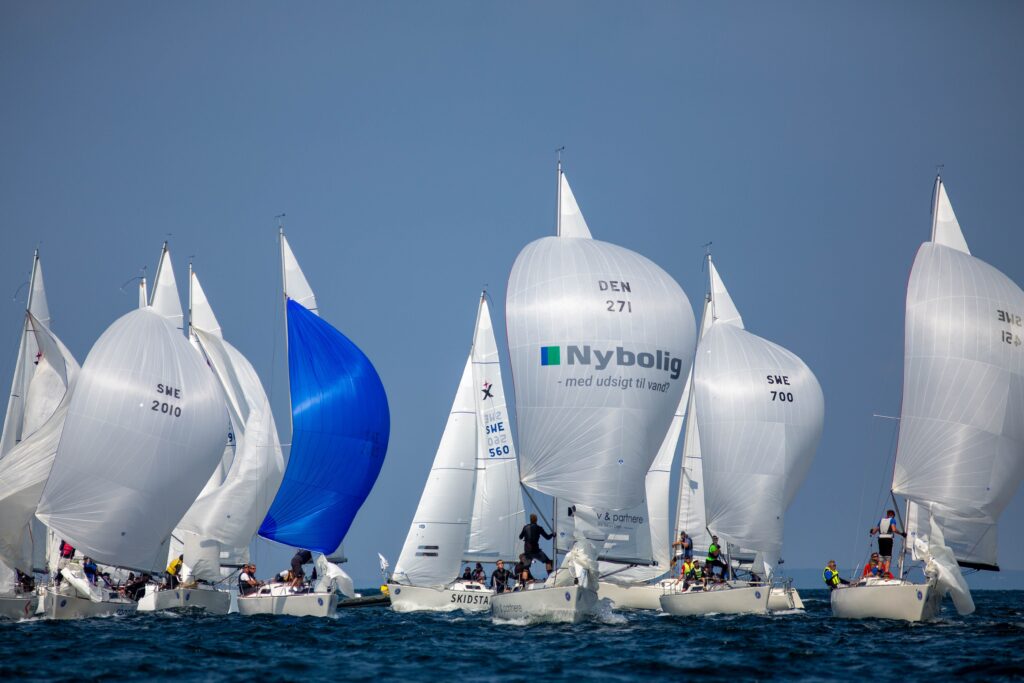
Symmetrical spinnakers have been around for a long time and continue to be a valid choice for cruising sailors.
The symmetrical shape of the sail lends them to wind angles of 165 degrees or more. If you’re going to spend a lot of time running, it’s a great option.
They’ve become less popular with short-handed crews, namely because of the work involved to fly them. They require a pole, sheet and guy lines, an uphaul, and a downhaul—all of which can be a lot to manage! They also can’t point as high as an asymmetrical spinnaker.
Symmetric spinnaker types
Similar to asymmetric spinnakers, symmetrical spinnakers have S codes. The “S” stands for symmetric and the number designates whether the sail is for light air or heavy air (the higher the number the heavier the air) and for reaching (odd numbers) or running (even numbers).
- 1S Light Air Reaching Symmetric
- 2S Light Air Running Symmetric
- 3S Heavy Air Reaching Symmetric
- 4S Heavy Air Running Symmetric
- 5S Extreme Air Symmetric
- Great for running
- Great in light air
- More work than an asymmetric spinnaker
- Limited reaching performance
Code sails are not technically downwind sails, and are best used for reaching in light airs. They’re similar to asymmetric spinnakers but have a solid luff that allows them to point higher.
They’re necessary on fractional-rig boats with non-overlapping headsails as they fill the gap between upwind headsails and downwind spinnakers. However, they can also be flown on a run as a twinned or poled-out headsail.
Finding the right sail and having a good downwind sailing setup can make your cruising experience more efficient, comfortable, and enjoyable.
I highly recommend talking to other sailors who own similar boats and who’ve sailed the passages and cruising grounds you’re interested in. Most experienced bluewater cruisers have spent a lot of time thinking about and refining their systems and will be more than happy to share what they’ve learned.
Fiona McGlynn is an award-winning boating writer who created Waterborne as a place to learn about living aboard and traveling the world by sailboat. She has written for boating magazines including BoatUS, SAIL, Cruising World, and Good Old Boat. She’s also a contributing editor at Good Old Boat and BoatUS Magazine. In 2017, Fiona and her husband completed a 3-year, 13,000-mile voyage from Vancouver to Mexico to Australia on their 35-foot sailboat.
Terms and Conditions - Privacy Policy

Learn the Basics of Small Catamaran Sailing: A Step-by-Step Guide
Alex Morgan
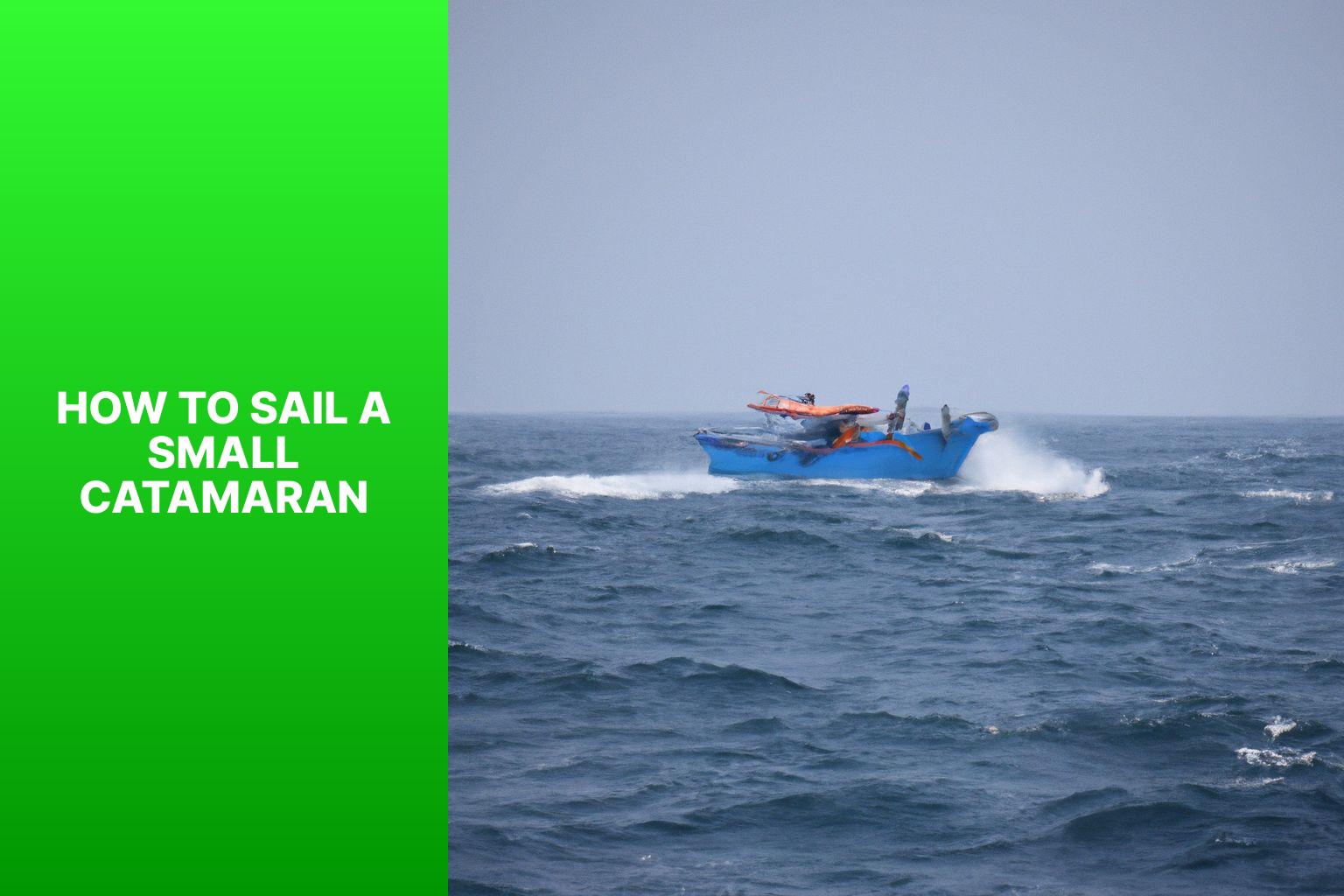
Sailing a small catamaran can be an exhilarating experience, allowing you to harness the power of the wind and glide across the water. Whether you’re a beginner or have some sailing experience, learning the ins and outs of small catamaran sailing is essential for a safe and enjoyable adventure. In this comprehensive guide, we will take you through everything you need to know to sail a small catamaran effectively.
Introduction to Small Catamarans
Small catamarans are multi-hull sailboats that consist of two parallel hulls connected by a frame. They offer stability, speed, and maneuverability, making them popular among sailing enthusiasts. Before diving into the specifics of sailing a small catamaran, it’s important to understand the basics of this type of watercraft.
Getting Started with Small Catamaran Sailing
To begin your small catamaran sailing journey, there are a few key considerations to keep in mind. Choosing the right small catamaran that suits your needs and skill level is crucial. Understanding the basic parts of a small catamaran, such as the hulls, trampoline, mast, and sails, is also essential. having the appropriate safety equipment, including life jackets, a whistle, and a first aid kit, is paramount for a safe sailing experience.
Learning the Fundamentals of Small Catamaran Sailing
Learning the fundamentals of small catamaran sailing will lay the foundation for a successful and enjoyable sailing experience. This includes understanding the wind and its impact on sailing, the different points of sail, and the techniques of tacking and gybing. Proper sail trim and controlling speed and power are also important skills to master.
Basic Maneuvers in Small Catamaran Sailing
Once you have grasped the fundamentals, it’s time to learn some basic maneuvers in small catamaran sailing. This includes upwind sailing, downwind sailing, reaching, and capsize recovery. Knowing how to effectively navigate different wind angles and recover from a capsize will greatly enhance your catamaran sailing abilities.
Advanced Techniques for Small Catamaran Sailing
For those looking to take their small catamaran sailing skills to the next level, there are advanced techniques to explore. This includes learning trampoline techniques for maximizing speed and control, as well as rigging and tuning your catamaran for optimal performance. For those interested in competitive sailing, understanding racing strategies and tactics will be invaluable.
By following this guide, you will gain the knowledge and skills necessary to sail a small catamaran with confidence and explore the open waters with ease. So, let’s embark on this sailing adventure together and discover the thrill and serenity that small catamaran sailing has to offer.
– Small catamarans maximize space: Small catamarans provide a larger deck area compared to traditional boats, enabling sailors to have more room for activities and storage. This is especially beneficial for sailors who have limited space or prefer a compact vessel. – Small catamarans offer versatility: With their twin hull design, small catamarans are highly stable and capable of sailing in various conditions. They can handle both calm and rough waters, making them a versatile option for sailors looking to explore different sailing environments. – Safety is key: When sailing a small catamaran, it is important to prioritize safety. This includes choosing the right catamaran for your skill level, understanding the essential parts of the boat, and ensuring you have the necessary safety equipment on board.
Embarking on the thrilling adventure of small catamaran sailing? This section is your compass to getting started! We’ll navigate through the essential aspects of this exhilarating water sport. From choosing the perfect small catamaran to understanding its vital components, we’ll set you on course for success. Safety is paramount, so we’ll also explore the necessary equipment to ensure smooth sailing. Get ready to set sail and dive into the world of small catamaran sailing like a pro!
Choosing the Right Small Catamaran
To choose the right small catamaran, consider key factors. Here is a table summarizing important aspects to take into account:
Choosing the right small catamaran is crucial for an enjoyable and safe sailing experience. Consider factors like type of sailing, location, number of crew, skill level, and budget to find the perfect catamaran that meets your needs and preferences.
Fact: The fastest recorded speed on a small catamaran was 51.36 knots (about 59 mph), achieved by Paul Larsen of Australia in 2012.
Understanding the Basic Parts of a Small Catamaran
To gain a comprehensive understanding of the basic parts of a small catamaran, it is important to familiarize yourself with the key components that make up this type of watercraft. These components include the following:
1. Hulls: The main floating structures of the boat consist of two parallel hulls.
2. Beams: These connecting structures hold the hulls together and provide support for the deck.
3. Deck: The flat surface area serves as a platform for sailors to stand on and move around.
4. Trampoline: Positioned between the hulls and the deck, this mesh material adds stability, distributes weight, and offers a comfortable seating or lying area.
5. Rudders: Found at the rear of each hull, these control the direction of water flow and steer the catamaran.
6. Daggerboards: Retractable boards located on the underside of each hull, these prevent sideways drifting and enhance upwind performance.
7. Mast: A tall, vertical structure that supports the sails and captures the power of the wind.
8. Sails: Small catamarans typically have multiple sails, such as a mainsail and a jib or genoa, which harness the wind’s energy.
9. Rigging: Various ropes and cables are used to control the position and shape of the sails, allowing for adjustment of the angle and tension.
10. Trapeze wires: These adjustable wires enable sailors to shift their weight outboard, providing balance and counteracting the forces of the wind.
Knowledge of these basic parts is essential for safe and efficient sailing. Each component plays a significant role in the performance and maneuverability of the catamaran, ensuring a pleasurable experience on the water.
Essential Safety Equipment
The essential safety equipment for small catamaran sailing includes:
Life jackets: Each person on board should have a properly fitted life jacket approved by relevant authorities. Ensure accessibility and good condition.
Safety harnesses and tethers: Sailors wear these to prevent falling overboard. Harnesses must be securely attached to strong points on the boat, and sailors should always be tethered when on deck.
Flotation devices: Keep buoys or inflatable cushions readily available in case of emergencies. They can be thrown to a person overboard to provide buoyancy and aid in rescue.
Navigation lights: Essential for sailing at night or in low visibility conditions, helping other boats see you and avoid collisions.
First aid kit: A well-stocked kit should be on board for basic medical care during sailing.
Fire extinguisher: Crucial in case of fires or emergencies. Regularly check and maintain the extinguisher.
True story:
One sunny day, while sailing on a small catamaran, our crew encountered unexpected strong winds and choppy waters. Suddenly, a crew member lost their balance and fell overboard. Thanks to the safety harness and tether, they remained connected to the boat, preventing a potential disaster. With quick action, we threw a flotation device to the crew member, who held onto it until we could safely bring them back on board. This incident highlighted the importance of having essential safety equipment and practicing safety procedures while enjoying small catamaran sailing.
Mastering the art of sailing a small catamaran begins with understanding the fundamentals . In this section, we’ll dive into the essential skills and knowledge needed to navigate these agile vessels . Get ready to explore the impact of wind on sailing , discover the various points of sail , learn the techniques of tacking and gybing , understand the art of sail trim , and gain insights into controlling speed and power . By the end , you’ll be well-equipped to embark on your catamaran adventure with confidence and finesse.
Understanding Wind and Its Impact on Sailing
Understanding Wind and Its Impact on Sailing is crucial for small catamaran sailors. Consider the following key points:
– Wind powers sailing by propelling the boat forward and determining the direction of travel.
– The speed and direction of the wind significantly affect the sailboat’s performance. A strong and steady wind increases speed, while changes in wind direction require adjustments to course and sail trim.
– Sailors must understand different points of sail. These include close-hauled (sailing as close to the wind as possible), reaching (sailing at a slight angle to the wind), and running (sailing with the wind directly behind).
– Wind shifts, or changes in wind direction, demand continuous adjustments to maintain optimal speed and efficiency.
– Be aware of gusts , sudden increases in wind speed. Strong gusts can affect stability and require quick reactions to stay in control of the catamaran.
– Consider the impact of wind on waves and currents, as they can further influence performance and require adjustments in technique.
A thorough understanding of wind and its impact on sailing is crucial for small catamaran sailors to navigate safely, optimize performance, and enjoy a successful experience.
Points of Sail
The sub-topic “ Points of Sail ” can be presented in a table to provide a clear understanding of each point of sail and the corresponding wind direction.
Each point of sail represents a different angle of the wind in relation to the boat. Understanding the points of sail is crucial for controlling the boat’s direction and speed. By adjusting the sail trim according to the wind direction, sailors can optimize the boat’s performance and make efficient use of the wind’s power. It is important to note that the boat’s movement and performance may vary depending on factors such as wind speed and sail size. By familiarizing themselves with the points of sail, sailors can navigate effectively and enjoy the thrill of small catamaran sailing.
Tacking and Gybing
To tack , steer the boat towards the wind to change direction. Release the mainsail sheet and jib sheet to allow the sails to luff. Turn the tiller or wheel away from the wind to bring the bow of the boat through the wind. Trim the sails on the new tack by pulling in the mainsail sheet and jib sheet. Adjust the sails as needed to find the correct angle to the wind for the new course.
To gybe , steer the boat away from the wind to change direction. Release the mainsail sheet and jib sheet to allow the sails to luff. Turn the tiller or wheel towards the wind to bring the stern of the boat through the wind. Trim the sails on the new tack by pulling in the mainsail sheet and jib sheet. Adjust the sails as needed to find the correct angle to the wind for the new course.
Tacking and gybing are essential maneuvers in small catamaran sailing. Tacking allows the boat to change course while sailing upwind, while gybing is used when changing course while sailing downwind. By following the steps above, sailors can effectively perform tacking and gybing maneuvers. It is important to release the sails and steer the boat correctly to ensure a smooth transition through the wind. Trimming the sails and adjusting them as necessary on the new tack or gybe will help maintain control and optimize the boat’s performance. Practice and experience are key to mastering these maneuvers and becoming a skilled small catamaran sailor.
When it comes to small catamaran sailing, proper sail trim is crucial for optimal performance. Here are some key considerations for achieving the correct sail trim:
– Adjust the main sail: Trim the main sail by tightening or loosening the main sheet. A well-trimmed main sail will have a smooth shape and minimal wrinkles.
– Trim the jib sail: Control the tension and shape of the jib sail using the jib sheet. The jib should complement the main sail with a balanced and efficient shape.
– Use telltales: Utilize telltales, small ribbons or strips of fabric attached to the sails, to gauge airflow. Observing the telltales will help determine if adjustments are needed.
– Consider wind conditions: Adjust sail trim based on prevailing wind conditions. In lighter winds, looser sails are needed to catch lighter breezes. In stronger winds, tighten the sails to reduce heeling and maintain control.
– Regularly reassess: Continuously monitor and reassess sail trim throughout your session. Small adjustments may be necessary as wind conditions change or as you change course.
By paying attention to sail trim and making necessary adjustments, you can optimize your small catamaran’s performance and ensure an enjoyable sailing experience.
Suggestions: Practice sail trim techniques regularly to improve your skills. Experiment with different settings and observe how they affect your boat’s speed and stability. Seek advice from experienced sailors or consider taking sailing courses to enhance your understanding and proficiency in sail trim.
Controlling Speed and Power
Controlling speed and power in small catamaran sailing is crucial and involves several important steps. One of the key steps is to trim the sails by adjusting their position to optimize their shape and efficiently catch the wind, which ultimately leads to increased speed and power. Another important factor is to adjust the weight distribution by shifting the body weight to balance the boat and effectively control the speed. Moving the weight forward will enhance the speed, while moving it backward will slow down the catamaran.
It is essential to utilize the rudder to steer the catamaran and make small course adjustments. By using the rudder effectively, one can maintain speed and control. Another aspect to consider is harnessing the wind . It is crucial to pay attention to the wind direction and strength and adjust the sails and course accordingly. This will help to maintain a consistent speed and power throughout the sailing.
Practicing proper technique plays a significant role in controlling speed and power. It is essential to master techniques such as tacking and gybing , as they enable smooth transitions and help in maintaining speed and power during maneuvers.
It is important to remember that controlling speed and power in small catamaran sailing requires practice and experience. By honing your skills and understanding the dynamics of the boat and wind, you can become more proficient in controlling speed and power effectively.
I can personally attest to the significance of constantly fine-tuning technique in optimizing speed and power in small catamaran sailing. In a sailing race, I found myself trailing behind other boats. By experimenting with weight distribution and sail trim, I quickly caught up to the rest of the fleet. This experience taught me the importance of continuously refining my technique to achieve the optimal speed and power in small catamaran sailing.
Basic Manuevers in Small Catamaran Sailing
Mastering the art of sailing a small catamaran starts with understanding the basic maneuvers. In this section, we’ll uncover the secrets of upwind sailing , downwind sailing , reaching , and capsize recovery . Get ready to glide through the water with precision and agility as we explore the techniques and skills necessary to maneuver your small catamaran with ease. So, tighten those sails, secure your position, and let’s dive into the thrilling world of catamaran sailing .
Upwind Sailing
Position yourself in the boat for upwind sailing: Sit on the trampoline with your feet facing forward, one foot in front of the other, for balance and stability.
Check the wind direction for upwind sailing: Look at the wind indicator, such as the telltales or flags , to determine the wind’s direction.
Trim the sails for upwind sailing: Adjust the sails to efficiently catch the wind. Increase the curvature of the sails for better lift.
Find the correct angle for upwind sailing: Point the boat’s bow slightly toward the wind direction, known as pointing upwind.
Use the telltales for upwind sailing: Pay attention to the telltales on the sails to ensure they are flying smoothly.
Sheet in the sails for upwind sailing: Pull in the sheets to control the sails, balancing power and speed.
Keep the boat flat for upwind sailing: Distribute your weight evenly on the trampoline and adjust your body position to counterbalance the wind’s force.
Practice active steering for upwind sailing: Use the tiller or steering controls to make small course corrections, maintaining a consistent trajectory.
Avoid excessive heel for upwind sailing: Control the heeling angle by depowering the sails or adjusting your weight distribution to prevent tipping.
Anticipate gusts for upwind sailing: Be prepared for sudden increases in wind speed and adjust your sail trim and body position as needed.
Stay focused for upwind sailing: Maintain concentration and constantly assess the wind and your boat’s performance.
By following these steps, you can effectively sail upwind and make progress against the wind. Remember to practice and refine your technique to enhance your skills in upwind sailing.
Downwind Sailing
Downwind sailing is an exciting technique in small catamaran sailing. Follow these steps to successfully navigate downwind:
- Position your catamaran with the wind behind you.
- Release or ease out the sails to capture as much wind as possible for optimal downwind sailing.
- Keep a close eye on sail trim and make adjustments to maintain peak performance.
- Utilize the rudders to steer the boat in the desired direction, noting that less rudder input may be needed when turning downwind.
- Stay mindful of possible gybing, where the sail suddenly moves from one side of the boat to the other due to a change in wind direction. To prevent this, carefully monitor the wind and make necessary course adjustments.
- Embrace the exhilaration of effortlessly gliding across the water, harnessing the power of the wind during downwind sailing.
Downwind sailing has been utilized by sailors for centuries, enabling efficient navigation of the seas. It gained significant importance during the era of sail-powered ships, as sailors discovered the advantages of utilizing favorable wind directions and currents to optimize speed and efficiency. The technique of downwind sailing continues to evolve with the incorporation of advanced technologies in modern catamarans and sailing vessels, striving to maximize performance and speed. Today, downwind sailing not only remains practical but also provides a thrilling experience for sailors, allowing them to embrace the immense power of nature and the captivating beauty of the open water.
Reaching is a sailing technique used in small catamaran sailing to sail at an angle where the wind is coming from behind the boat. It allows the boat to sail faster and more efficiently.
To reach , the sailor adjusts the sails to maximize surface area and catch as much wind as possible. This propels the catamaran forward.
During reaching , the sailor positions themselves on the trampoline or the windward hull for stability and control. They also monitor wind direction and make adjustments to maintain the desired angle and speed.
Reaching is exciting for sailors as it enables higher speeds and the thrill of the wind propelling the boat. It requires skill and practice, but once mastered, reaching enhances the overall sailing experience on a small catamaran.
Capsize Recovery
Capsize Recovery is vital for small catamaran sailing. Here is a guide to effectively recover from a capsize:
- Stay calm and assess the situation.
- Hold onto the boat and ensure everyone is accounted for.
- Signal for help if necessary, especially in a busy waterway.
- Try to right the boat by pushing down on the centerboard or daggerboard.
- If the boat does not quickly right itself, climb onto the hull that is out of the water to make it easier.
- Once the boat is upright, climb back onboard and assess any damage.
- Bail out any remaining water using buckets or bailers.
- Check all rigging and equipment for damage.
- Restart the engine or raise the sails to continue sailing.
Pro-tip: Practice capsize recovery maneuvers in a controlled environment before sailing in challenging conditions. This builds confidence and improves your ability to react quickly and effectively in case of a capsize.
Mastering the art of small catamaran sailing goes beyond the basics. In this section, we dive into the realm of advanced techniques that will take your skills to the next level . Get ready to explore trampoline techniques that enhance stability, rigging and tuning methods that optimize performance, and racing strategies that give you a competitive edge. Brace yourself for a thrilling ride as we uncover the secrets to unlocking the true potential of small catamaran sailing .
Trampoline Techniques
- Using the trampoline: The trampoline on a small catamaran is crucial for various techniques.
- Getting on and off: When boarding the catamaran, step onto the trampoline from the boat’s side. To disembark, step off the trampoline onto a stable surface.
- Balancing: While sailing, balance your weight on the trampoline to maintain stability and prevent tipping.
- Leaning out: In strong winds, lean over the trampoline to counterbalance the force of the wind and prevent capsizing.
- Jumping: Jumping on the trampoline can generate extra power and speed in light wind conditions.
- Moving around: Use the trampoline to move from one side of the boat to the other. Step carefully and hold onto the boat for stability.
- Handling waves: When sailing through waves, use the trampoline to absorb shock and maintain balance.
- Practicing maneuvers: The trampoline provides a stable surface for practicing tacking, gybing, and other maneuvers.
- Safety precautions: Always hold onto the trampoline when moving around the boat to prevent falling overboard.
Rigging and Tuning
Rigging and tuning are crucial for small catamaran sailing. Here are some essential aspects to consider:
– Rigging: It’s vital to set up and secure the mast, boom, and other rigging components correctly. Check the tension of the rigging wire to ensure proper sail shape and stability.
– Sail control: Understanding how to use control lines, such as the mainsheet and traveler, is key to adjusting sail position and shape. These controls optimize performance and balance the catamaran.
– Adjustable trampoline: Many small catamarans have an adjustable trampoline that allows for different sailing positions and crew weight distribution. This feature affects stability and handling.
– Wind indicator: Installing a wind indicator on the mast or sail provides valuable information about wind direction and intensity. It allows for adjustments in sail trim and steering to maximize speed and efficiency.
– Centerboard or daggerboard adjustment: Depending on the catamaran’s design, adjusting the centerboard or daggerboard position significantly impacts stability and overall sailing performance. Knowing when and how to adjust them is crucial.
– Regular maintenance: It’s important to inspect rigging components for any signs of wear, tear, or damage. Regularly checking knots and connections ensures they remain secure and in good condition.
– Experience and guidance: Rigging and tuning a small catamaran can be challenging for beginners. Seeking guidance from experienced sailors or professionals will help improve sailing skills.
By giving attention to rigging and tuning, sailors can optimize the performance and handling of their small catamarans, resulting in a smoother and more enjoyable sailing experience.
Racing Strategies
- To maximize performance on the water, it is important to start with a good racing strategy. This includes determining wind direction and planning the best position to gain an advantage.
- One crucial aspect of racing strategies is mastering boat handling. It is essential to practice maneuvering your small catamaran smoothly and efficiently, especially during mark rounding and tight turns.
- Another key racing strategy is learning to read wind shifts. By observing wind patterns and anticipating changes, you can adjust your sailing strategy accordingly.
- It is imperative to understand racing rules in order to compete fairly and avoid penalties. Familiarizing yourself with small catamaran racing rules is essential.
- Staying aware of the competition is a vital part of racing strategies. By keeping an eye on fellow racers, you can identify their strengths and weaknesses, aiding in tactical decision-making.
- Developing a strong downwind strategy is crucial. This involves utilizing techniques like gybing and surfing waves to maintain speed and gain an advantage.
- Being adaptable is key in racing. Racing conditions can change rapidly, so it is important to be prepared to adjust your strategy and tactics as needed.
Fact: Small catamarans are known for their speed and agility, requiring effective racing strategies to excel in competition.
Some Facts About How To Sail A Small Catamaran:
- ✅ Learning how to sail a small catamaran can be an exciting and freeing experience. (Source: catamaranfreedom.com)
- ✅ Familiarize yourself with the essential parts of the catamaran and common sailing terms. (Source: catamaranfreedom.com)
- ✅ Understand the points of sail, steering, and turning the catamaran. (Source: catamaranfreedom.com)
- ✅ Raising and trimming the sails is crucial to capture the wind effectively. (Source: catamaranfreedom.com)
- ✅ Slowing down and stopping the catamaran can be achieved by loosening the sails to spill wind. (Source: catamaranfreedom.com)
Frequently Asked Questions
1. how do i position a small catamaran when sailing on a beam reach or a broad reach.
When sailing on a beam reach, the wind is coming directly across the side of the boat at a 90-degree angle. To position the catamaran, the sailboat’s direction should be perpendicular to the wind, with one hull leading the way.
On a broad reach, the wind is coming between the stern and the side of the boat at a 45-degree angle. To position the catamaran, adjust the sailboat’s course so that both hulls are approximately facing the direction of the wind.
2. What are the essential parts of a small catamaran?
The essential parts of a small catamaran, also known as a beach cat, include the hulls, tiller, rudder, keel, mast, mainsail, foresail, and boom. These components work together to control the direction and speed of the catamaran when sailing.
3. How should I handle the tiller when sailing a small catamaran?
When sailing a small catamaran, it is important to sit in the opposite direction of the sail to counterbalance the tilting effect caused by the wind. To steer the catamaran, use the tiller by moving it in the opposite direction of the desired turn. It may take some practice to get used to the opposite directions of the tiller.
4. What sailing gear do I need when sailing a small catamaran?
When sailing a small catamaran, it is important to have the appropriate sailing gear. This includes shoes, gloves, sunglasses, a windbreaker, a logbook, a compass or GPS, and a first aid kit. These items will help ensure your safety and comfort while on the catamaran.
5. How do I turn the catamaran into the wind when sailing close-hauled?
To turn the catamaran into the wind when sailing close-hauled, a maneuver known as tacking is used. Move the tiller toward the sail to pass the bows through the wind. Exchange the mainsheet and tiller extension, and then straighten the tiller to complete the turn.
6. How do I slow down and stop the catamaran when sailing?
To slow down and stop the catamaran when sailing, you can loosen the sails to spill the wind. Let out and loosen the sails until they luff or flap. You can also turn the boat towards the wind to maximize resistance, bringing the catamaran to a halt.
About the author
Leave a Reply Cancel reply
Your email address will not be published. Required fields are marked *
Save my name, email, and website in this browser for the next time I comment.
Latest posts


The history of sailing – from ancient times to modern adventures
History of Sailing Sailing is a time-honored tradition that has evolved over millennia, from its humble beginnings as a means of transportation to a beloved modern-day recreational activity. The history of sailing is a fascinating journey that spans cultures and centuries, rich in innovation and adventure. In this article, we’ll explore the remarkable evolution of…

Sailing Solo: Adventures and Challenges of Single-Handed Sailing
Solo Sailing Sailing has always been a pursuit of freedom, adventure, and self-discovery. While sailing with a crew is a fantastic experience, there’s a unique allure to sailing solo – just you, the wind, and the open sea. Single-handed sailing, as it’s often called, is a journey of self-reliance, resilience, and the ultimate test of…

Sustainable Sailing: Eco-Friendly Practices on the boat
Eco Friendly Sailing Sailing is an exhilarating and timeless way to explore the beauty of the open water, but it’s important to remember that our oceans and environment need our protection. Sustainable sailing, which involves eco-friendly practices and mindful decision-making, allows sailors to enjoy their adventures while minimizing their impact on the environment. In this…

The Ultimate Guide to Choosing Between a Sailboat or Catamaran for Your Sailing Adventures
C hoosing between a sailboat and a catamaran for your sailing adventures is a significant decision that depends on various factors, including your sailing preferences, experience level, budget, and intended use. Here's an ultimate guide to help you make an informed decision:
1. Sailing Experience:
- Sailboats: Typically require more skill and experience to handle, especially in adverse weather conditions. Ideal for sailors who enjoy the traditional feel of sailing and are willing to invest time in learning and mastering the art.
- Catamarans: Easier to handle, making them suitable for beginners. The dual-hull design provides stability, reducing the learning curve for those new to sailing.
2. Space and Comfort:
- Sailboats: Generally have a narrower beam and less living space. However, some sailboats may offer comfortable cabins and amenities.
- Catamarans: Wider beam creates more living space. Catamarans often have multiple cabins, spacious saloons, and expansive deck areas, providing a more comfortable living experience.
3. Stability:
- Sailboats: Monohulls can heel (lean) while sailing, which some sailors enjoy for the thrill but can be discomforting for others.
- Catamarans: Greater stability due to the dual hulls, providing a more level sailing experience. Reduced heeling makes catamarans suitable for those prone to seasickness.
4. Performance:
- Sailboats: Known for their upwind performance and ability to sail close to the wind. Some sailors appreciate the challenge of optimizing sail trim for efficiency.
- Catamarans: Faster on a reach and downwind due to their wide beam. However, they may not point as high into the wind as monohulls.
- Sailboats: Typically have a deeper draft, limiting access to shallow anchorages and requiring deeper marina berths.
- Catamarans: Shallow draft allows access to shallower waters and secluded anchorages, providing more flexibility in cruising destinations.
- Sailboats: Generally more affordable upfront, with a wide range of options available to fit different budgets.
- Catamarans: Often more expensive upfront due to their size and design. However, maintenance costs may be comparable or even lower in some cases.
7. Mooring and Docking:
- Sailboats: Easier to find slips and moorings in marinas designed for monohulls.
- Catamarans: Require wider slips and may have limited availability in certain marinas, especially in crowded anchorages.
8. Intended Use:
- Sailboats: Ideal for traditional sailors who enjoy the art of sailing, racing enthusiasts, or those on a tighter budget.
- Catamarans: Suited for those prioritizing comfort, stability, and spacious living areas, especially for long-term cruising and chartering.
9. Resale Value:
- Sailboats: Generally have a more established resale market, with a wider range of buyers.
- Catamarans: Growing in popularity, and well-maintained catamarans often retain their value.
10. Personal Preference:
- Consider your personal preferences, the type of sailing you plan to do, and the kind of lifestyle you want aboard your vessel.
In conclusion, both sailboats and catamarans have their advantages and disadvantages. Your decision should be based on your individual preferences, experience level, budget, and intended use. If possible, charter both types of vessels to experience firsthand how they handle and to help make a more informed decision based on your own preferences and needs.
The post The Ultimate Guide to Choosing Between a Sailboat or Catamaran for Your Sailing Adventures appeared first on Things That Make People Go Aww .

Aft : The rear of a boat, close to the stern Backstay : A mast support that runs from the top of the mast to the stern of the boat. It may be adjustable in order to bend the mast backward or to increase tension on the forestay tool Ballast : Weight in the keel of a boat that adds stability Beam : A boat's greatest width Beating : Sailing (or pointing) at an angle into the wind or upwind. Since sailboats cannot sail directly into the wind, "beating" is the closest course to the wind they can sail. Bilge : The lowest part of a boat's hull
Blanketing : A tactical maneuver in which one boat slows a competitor by positioning itself to obstruct the competitor's wind Block : An assemblage of one or more sheaves (pulleys) housed in a plastic or metal case that changes the direction of travel of a line (rope) and may be attached to a boat's deck, spar or other stationary object Boom : Spar to which a sail's lower edge or foot is attached. The boom is attached to the mast at the gooseneck. Boom vang : Lines that control the boom. These lines run from the boom to the base of the mast and are used when reaching and running. Bow : The front of the boat Broach : When in a downwind situation, the boat turns uncontrollably and is pushed by the wind onto its side, lying with the mast parallel to the water. As a rule, the boat will right itself. Buoy : A floating marker Cam cleat : A mechanical cleat used to hold a line automatically. It uses two spring-loaded cams that come together to clamp their teeth on the line, which is placed between them. Also known as jam cleat . Centerboard : Like a keel, it is a weighted appendage projecting below the boat that keeps it from capsizing and also supplies the hydrodynamic lateral force that enables the boat to sail upwind. Unlike a keel, it is retractable. Cleat : A fitting, typically with projecting ends, that holds a line against the tension from the sails, rigging or mooring Clew : The lower corner of a mainsail or jib and either lower corner of a spinnaker Coming about : Turning the boat so the bow crosses through the eye of the wind, thereby changing the side of the yacht on which the sails are carried. Also known as tacking. Covering : A tactical maneuver in which a boat stays between a competitor and the wind or the next mark Daggerboard : An adjustable fin primarily used to stop the boat moving sideways through the water. Also known as centerboard. Dinghy : The Laser, Laser Radial, 470, and Finn are all dinghies that have been used in Olympic sailing - they all have one hull and a centreboard or daggerboard Downwind : The point of sail when the wind blows from aft of the boat's beam Drag : The negative or retarding force acting on a body, such as a boat moving through a fluid parallel and opposite to the direction of motion Fall off : A maneuver in which a boat turns away from the wind Fleet racing: Competition format were entries race against each other around a course Foot : The bottom edge of a sail Genoa/Headsail/Jib : The smaller sail set in front of the mast Gooseneck : A fitting that attaches the boom to the mast Gybe : Turning the boat so the stern crosses through the eye of the wind, (thereby changing the side of the boat on which the sails are carried (opposite of tacking). Also spelled jibe. Halyard : A line used to hoist and hold up a sail Header : Wind shift that causes the boat to head away from the mark Helmsman : The crew member who steers the boat; also the skipper, or the "driver" Hiking out : Leaning out of the craft in order to change the center of gravity in the boat and go faster Hiking straps : Straps attached to the feet that help a sailor hike out more, minimizing the chance of falling out of the boat Hull: The main body or shell of a ship or other vessel, including the bottom, sides, and deck ISAF : International Sailing Federation, the world governing body of sailboat racing Jam cleat : A device used to grip a line (rope). It has two rows of V-shaped molded teeth that grip the line when it is jammed in the groove. Also known as cam cleat. Jib : A foresail that overlaps the shroud base and is used for sailing upwind Jibe : Same as the gybe -- turning the boat so the stern crosses through the eye of the wind, thereby changing the side of the yacht on which the sails are carried (opposite of tacking) Kee l: A weighted, non-moveable appendage projecting below the boat that keeps it from capsizing and also supplies the hydrodynamic lateral force that enables the boat to sail upwind Kite : Large, light ballooning sails that are only attached to the mast at the corners. They are used when sailing downwind. Also known as spinnaker . Knot : One nautical mile per hour Lay : To sail a course that clears an object or racecourse marker buoy such as the windward and leeward marks. When a boat is doing so, it is said to be "laying the mark." Layline : An imaginary line projecting at an angle and corresponding to the wind direction from either side of a racecourse marker buoy that defines the optimum sailing angle for a boat to fetch the mark or the finish line. When a boat reaches this point, it is said to be "on the layline." Going beyond the layline means the boat is sailing a greater distance to reach the mark or finish line. Leech : The trailing edge of a sail or the curve of a sail Leeward : The side furthest away from the wind Lines : A nautical term for ropes Luff, to : Bubbling or flapping of a sail when it is not trimmed enough or is being back winded by another sailor when the course sailed is too close to the wind Mainsail : The sail behind the mast Mark : A buoy used in a racecourse Mast : The vertical spar that holds up the sails Match racing : A racing format in which only two boats compete at a time, as opposed to fleet racing, wherein three or more boats sail at once Medal race : The final race in the series. Only the top-10 boats after the opening series compete and scores are doubled. Multihull : Nacra 17 (boat used in its inaugural event at the 2016 Rio Olympic Games) - A boat with more than one hull. A boat with two hulls is also known as a catamaran and a boat with three hulls is knows as a trimaran. Nautical mile : The unit of geographical distance used on saltwater charts; one nautical mile equals 6,076 feet or 1.15 statute miles. Therefore, one statute mile equals 0.87 of a nautical mile. Off the wind : Sailing away from the wind; also downwind, reaching or running Plane : A boat planes when it sails over her own bow wave so only a small section of the hull is in the water. This allows the boat to go faster than the theoretical maximum hull speed. Pointing : Sailing at an angle into the wind or upwind. Depending on a boat's design, some will "point higher" or sail more directly into the wind and thus sail a shorter course to a given mark on the racecourse. Port : Nautical term for the left side of a boat when facing forward Port tack : Sailing with the wind blowing onto the port side and the mainsail on the starboard side Race officials : The officials responsible for running the race and enforcing the rules. This group includes the measurers who ensure that each sailor's equipment is equal and within the rules, the race officers who run the races and the judges and umpires who are rules experts and make decisions about whether rules have been broken. Reef : To decrease a sail's size Rigging : The wires, lines, halyards and other items used to attach the sails and the spars to the boat. The lines that do not have to be adjusted often are known as standing rigging. The lines that are adjusted to raise, lower and trim the sails are known as running rigging. Rudder : A moveable fin located underneath the back of the boat that steers the craft Running rigging : All moving rods and lines that support and control the mast and sails Shackle : A metal connector that attaches to other fittings with the use of a pin that is inserted through the arms of a U Sheet : A line that controls sails Skiff : 49er - A light open dinghy with a self-draining hull Slalom finish : A technical section of the windsurfing (RS:X) course involving multiple changes of direction in quick succession Spar : A basic term for a mast, boom or yard Spinnaker : Large, light ballooning sails that are only attached to the spars at the corners. They are used when running or reaching, sailing downwind. Starboard : Nautical term for the right half of the boat when facing forward Starboard tack : Sailing with the wind blowing onto the starboard side and the mainsail on the port side Stern : The rear of the boat Tacking : Turning the boat so the bow crosses through the eye of the wind, thereby changing the side of the boat on which the sails are carried (opposite of gybing) Tiller : A lever used to turn the rudder of a boat from side to side Trapeze : To stand on the side of the boat to maximize the effect of the body weight Trim : To adjust the sail to the right shape and angle to the wind. The process of "hiking out," or changing the center of gravity of the boat in order to go faster. Upwind : Toward the direction from which the wind blows; windward. Way : Forward motion of a boat. A term typically used in the context of saying that a boat is making way, is underway, or has way on. Windward : The side closest to the wind
Note: Some components of NBCOlympics.com may not be optimized for users browsing with Internet Explorer 11, 10 or older browsers or systems.
catamaran boat double decker
- 0 No item in your cart
- SUBSCRIPTION
- Classified Ads
- Technical Specifications
- Destinations
- Address book

- All the magazines

SUNREEF 88 DOUBLE DECK: A catamaran designed for ultimate comfort!
680 m² of canvas downwind, 460 m² upwind, the Sunreef 88 DD is a real sailboat making 7 knots in just 10 knots of wind
The 88 DD is an imposing catamaran with an air draft of over 40 meters... Welcome to the outsized world of superyachts!
The sheer of the deck makes it possible to house a jet-ski on the sidedeck while maintaining good headroom in the cabins...
On the flybridge, behind the helm station, you find all the indispensable features for relaxation: sunbathing, barbecue, bar and a magnificent 35m² of space
The helm station located on the flybridge allows for handling everything on the entire cat while offering an ideal view of the water.
The aft cockpit encircled by loungers is very large. The skipper's cabin is hidden under the bench seat of the big table. Beneath the stairway, there is access to the day toilets without having to go through the interior of the boat
The Sunreef 88 DD hasn’t forgotten any of the rules of super-yachting. Attention to detail and refinement is everywhere on board, making life enjoyable
The cockpit interior offers a good view forward across the water. From here, you can handle the boat while staying warm during night watches.
The owner's cabin occupies the entire forward part of the coachroof and offers a 180° panoramic view. It has a large bench seat / bunk bed for when the children want to join their parents, and the bathroom is located in the hull. Superb!
The galley is professionally equipped and offers really impressive storage space. A wine cellar and large freezers find their place in the cargo hold under the floor
The guest cabins are just as beautiful
Practical info
- Builder : SUNREEF YACHTS
- Technical specifications
- Finance your Sunreef 88 Double Deck
- Articles about the Sunreef 88 Double Deck
- Available in issue # 158
Boat Test price $5.00 Inc. tax

Add several tests to your cart
and get an extra discount!
With their new 88 footer from the Double Deck range, Sunreef are unveiling an ultra-comfortable cruising catamaran built for an experienced boating family, and are confirming their ability to complete fully customized projects on the same timescale as production boats.
It took no more than 9 months for the Sunreef 88 DD, first announced at the 2016 Cannes boat show, to see its hulls hit the water in Gdansk, Poland. Yet this is not just a well-honed semi-custom boat, but a brand new model in the range which is already known to connoisseurs and necessarily demanding owners. Having owned many of the best in English and Italian motor yachts, this family got into sailing with a beautiful 25 meter ketch. The natural instability of a heeling monohull prompted them to ask Ian Sellers, their skipper, to think of another solution. The choice of a sailing catamaran was a logical one: the space, stability, low draft, panoramic view and the economical running are irrefutable arguments for those who want XXL-sized comfort.
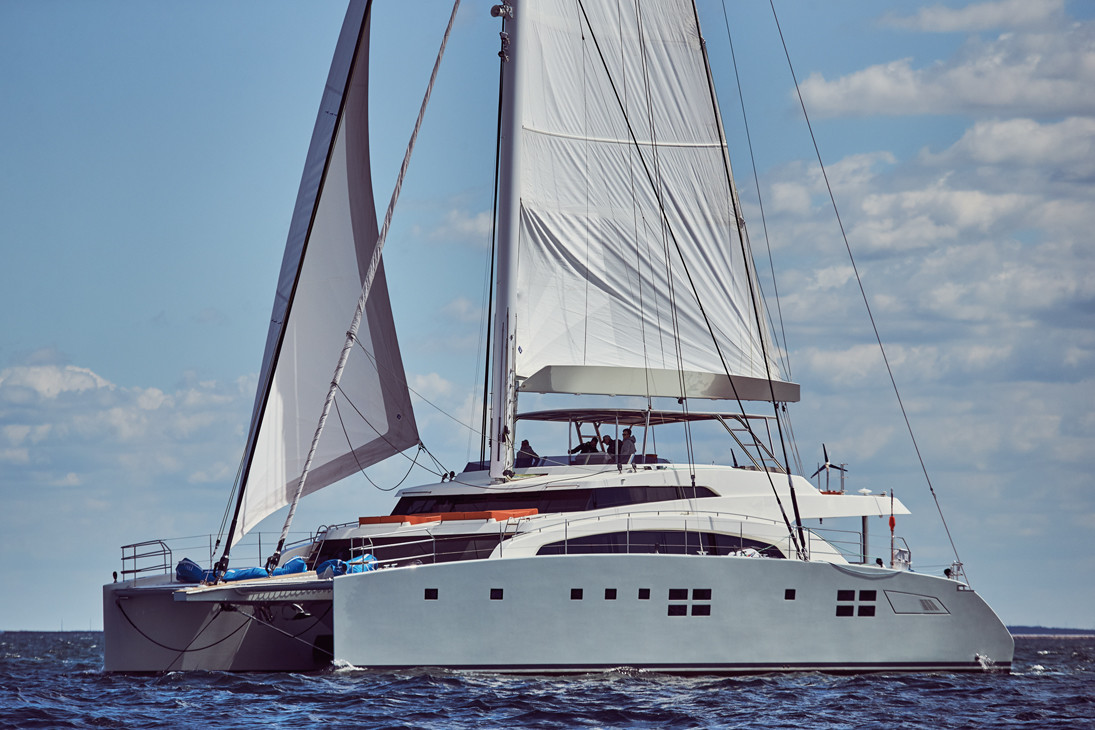
A good average speed to cross the Atlantic or to reach new anchorages in the Caribbean islands after a beautiful summer season in the Mediterranean also guided their choice. It simply remained to find a shipyard capable of satisfying the wishes of the owner. With a budget of more than 4 million euros, this owner was looking for a boat that was not just ultra-equipped and of the highest quality, but a unit that was entirely made ...
To read in full, Buy the boat test
What readers think.
Post a comment
No comments to show.
Share this article
Follow us on, vous avez ajouté " " à vos favoris., vous avez supprimé " " de vos favoris., in order to add this article to your favorites, please sign in..
- Green Propulsion
- Renewable Energy
- Energy efficiency
- Sustainable materials
- News & Events
- Sunreef News Magazine
- Press About Sunreef

- 60 Sunreef Power
- 70 Sunreef Power
- 80 Sunreef Power
- 100 Sunreef Power
- Sunreef Supreme Power
- Sunreef Ultima Range
- Sunreef 44 Ultima
- Sunreef 55 Ultima
- Sunreef 66 Ultima
- Sunreef 77 Ultima
- Sunreef 88 Ultima
- Sunreef fleet

- Sunreef Zero Cat
- Sunreef 100 Eco
- Sunreef Fleet

- Sunreef 43M
- 49M Sunreef Power
- 210 Sunreef Power Trimaran
- Sunreef Explorer
- 40M Sunreef Explorer
- 40M Sunreef Explorer Eco
- 50M Sunreef Explorer
- Superyachts Fleet
Sunreef 88 Double Deck
- Sustainable
DISCOVER THE MODEL
Description.
The start of the ambitious Sunreef 88 Double Deck project was officially communicated during Sunreef Yachts’ press conference at the Cannes Yachting Festival 2016. After eight months of intensive work, the shipyard proudly announced the launch of this catamaran with a zealous, sporty look.
An experienced yachtsman switching from a massive motor yacht , the owner decided to commission the Sunreef 88 Double Deck to pursue a more stable navigation style with greater living space. Indeed, a challenging project for the shipyard’s engineering and design teams.
Nonetheless, this journey was destined to keep the promise of delivering a state-of-the art fully customized sailing catamaran from the start. To achieve the goal of building a seaworthy and dynamic catamaran, Sunreef Yachts’ team of naval architects conceived a completely new yacht design which seemed far sportier than the rest.
Same as all yachts within her range, the Sunreef 88 Double Deck too features a mezzanine level inside the saloon and a spacious master stateroom with a panoramic view in the bow part of the main deck. However, her superstructure was granted a more aerodynamic aspect. As a result, the 88-footer emphasis equally on both performance and luxury, offering over 300m² of living space and an outstanding sailing experience.
Despite this, the Sunreef 88 Double Deck remains a family-friendly yacht offering the best of comfort and safety. The innovative composite superstructure of the sailing yacht conceals a smart and functional layout with luxurious accommodations for eight guests and up to five crew members.
Upon the owners’ request, the interior decor of the Sunreef 88 Double Deck features exclusive natural materials: Chambord oak, linen, leather, natural stone, and quartz tiles – all contribute to the warm and welcoming atmosphere of the sailing yacht . The feeling of warmth was also achieved through applying numerous orange accents to the interiors – an important color for the owner’s family who consider it to be a symbol of energy.
For comprehensive information and guidance on our products, contact us .

SPECIFICATION
- CLASSIC VERSION
Construction
27 m / 88 Ft
Length overall
Beam overall
245 m² / 2637 Ft²
Water capacity
Sunreef Yachts
385 m² / 4145 Ft²
Fuel capacity
2.30 m / 7.5 Ft
180 m² / 1940 Ft²
Comments are closed.
SUBSCRIBE TO OUR NEWSLETTER
- Sailing Yachts
- Power Yachts
- Superyachts
- Making a Change
- Green Concept
- Energy Efficiency
- Sustainable Materials
- ECO Q&A
Copyright © 2024 Sunreef Yachts . All rights reserved.
- Whistleblowing
- Privacy Policy

Sunreef Venture S.A.
Sunreef Yachts Shipyard
ul. Tarcice 6
80-718 Gdańsk, Poland
+48 58 769 77 77
Launched Sunreef Yacht - Not For Sale:
Sunreef 92 dd (92ft)-vessel summary.
BASIC SUMMARY
Dimensions & specifications, hull and deck configuration, engine details.
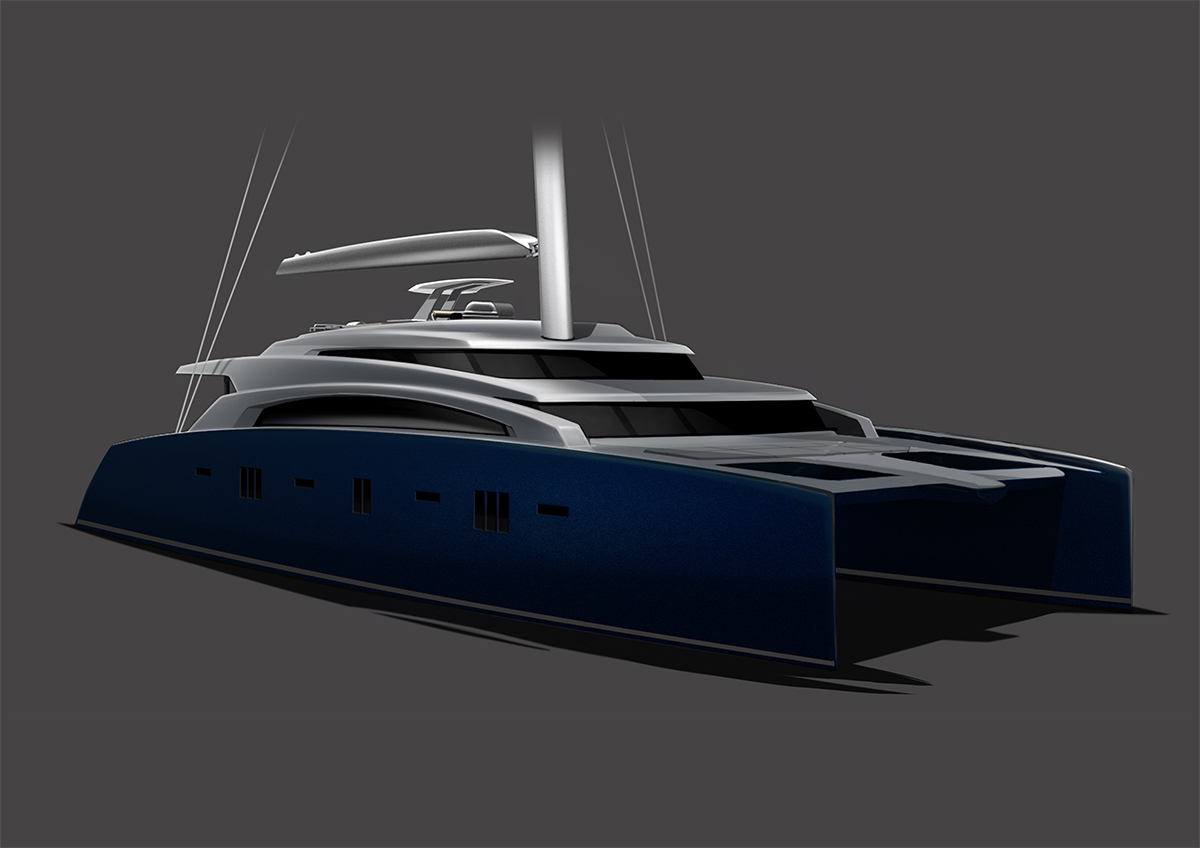
- Update Profile
- Email me when price is activated
- Do you own a boat like this? Sell it now
Boat Description
The Company offers the details of this vessel in good faith but cannot guarantee or warrant the accuracy of this information nor warrant the condition of the vessel. A buyer should instruct his agents, or his surveyors to investigate such details as the buyer desired validated. This vessel is offered subject to prior sale, price change, or withdrawal without notice. Photos may not properly reflect the current condition of the actual vessel offered for sale. In some cases stock photographs may have been used.
Mechanical Disclaimer
Engine and generator hours are as of the date of the original listing and are a representation of what the listing broker is told by the owner and/or actual reading of the engine hour meters. The broker cannot guarantee the true hours. It is the responsibility of the purchaser and/or his agent to verify engine hours, warranties implied or otherwise and major overhauls as well as all other representations noted on the listing.
Dinghy Disclaimer
All dinghies are considered separate vessels and should have separate titles and documents. There is no guarantee as to the title of the dinghy on this vessel so Buyer accepts that while he may receive the dinghy included in the transaction, he may not receive the proper title to it.
- YACHT DESIGN
- YACHT MARKET
- YACHT CLUBS
- YACHT HOTELS
- CHARTER YACHTS
- YACHT SHOWS
- REGATTAS & RACES
YACHT ACCESSORIES
- YACHT APPAREL
- SAILOR GUIDE

- Advertise with Us

New Sunreef 92 Double Deck Sailing Catamaran
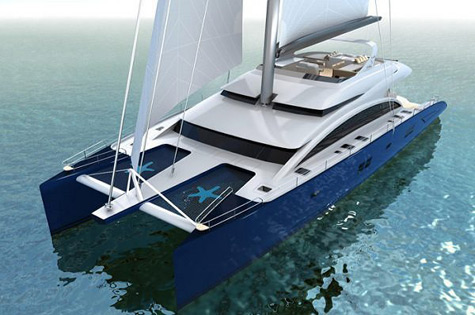
From the same people who brought you the original Sunreef Yacht, comes the new Sunreef 92 Double Deck , with a new design which not only streamlines the deck house, but tops it with a giant 40 m 2 fly bridge.
This was inspired by similar designs found on other super yacht designs. In collaboration with K-Epsilon and Rivoyre Ingenierie , The Sunreef Naval Architecture Bureau has intensely studied performance and sea capabilities using state of the art CFD, computational flow dynamics to create the ultimate in catamaran luxury.
Using integrated stepped hull chins, the Sunreef 92 Double Deck catamaran increases interior space, without compromising performance. Now this yacht can accommodate up to 10 guests, in up to 5 double luxury suites, as well as a crew of four.
Sunreef’s 92 Double Deck also features a canoe style boom and carbon mast, one of this manufacturer’s specialties. How are they able to accomplish such feats? They added a new mezzanine floor, which includes a coffee table and lounge, located on the port side of the main deck dining area, freeing up more space below for larger cabins and storage space, or even more suites if you prefer.
Because of this innovative design modification, now the owner’s suite occupies two floors of the entire front area of this yacht, with a private luxury office, gym and leisure area on the upper level, with the bathroom, wardrobe and storage area below deck. Each cabin has an extended size, three way access to their King sized beds, with spectacular panoramic sea views. Not only this, but each luxury suite comes with its own separate bath and shower area, large closets, storage lockers, as well as their own air conditioning and a comprehensive entertainment system.
With a LOA of 27 meters, an 11.2m beam, and a 1.6m draft, this super yacht has a 80 ton displacement. It will also be powered by two 405HP 1200 L/3170 Gal engines, and will be able to cruise at speeds up to 15 knots. The 70m 2 cockpit will also include a large dining area, sunbathing mattresses, and diving equipment. Its spacious fly bridge is fitted with a jacuzzi, two wet bars, barbecue, ice makers and even a pair of jet skis. It will also include a tender, hidden in a specially built locker under the main sun pad of the cockpit.
Even though this is only the second of such models, it isn’t hard to see why the Sunreef 92 Double Deck sailing catamaran is on it’s way to be one of the most sought after luxury yachts. With it’s innovative design, state of the art electronics, and focus on luxury, the Sunreef 92 Double Deck is top of the line, and a must for people who may still think they have it all. Don’t miss out on your own little piece of paradise.
Sunreef 92 Double Deck specification:
Length overall: 27.00 m/88.85ft Beam maximum: 11.20 m/36.60ft Lightship displacement: 80 T Draft maximum (dagger boat): 1.60 m/5.2 ft Mast clearance: 43.20 m/ 142 ft Mast height: 35.40 m/ 116ft Fully battened main sail: 280 m²/3013 ft² Gennaker: 350 m²/3767 ft² Genoa: 160 m²/1722 ft² Solent: 90 m²/ 968 ft² Main engines: 2 x 405 HP Fuel capacity: 12000 L/3170 Gal Water capacity: 2 x 2000 L/2 x 528 Gal Cruising speed on sails: 15 knots Guests : 10 Crew: 3 Naval Architecture/Design/Builder: Sunreef Yachts
Related links: Sunreef Yachts
Foto: sunreef-yachts.com
- Rivoyre Ingenierie
- Sunreef 92 Double Deck
- Sunreef Catamaran
Related Articles
Skia by design storz: unveiling of a 109-meter superyacht concept, introducing the wallywhy100: a marvel of design and performance, sinot’s beach superyacht series: a symphony of luxury, nature, and sustainability, staying afloat: a guide to survival suits for boaters, navigating waters with ease: top 5 dog ramps for your water-loving pup, unleashing comfort and safety: a guide to essential boat accessories for dogs, unwrapping the top 10 best christmas gifts for yacht enthusiasts, docktail butler elite teak table: elevating yachting experiences with elegance and functionality, exploring the abyss: unveiling the powervision powerray wizard underwater drone, seas of sip: captain ladle and the toadfish tumbler tale, sailing the seas of sound: the fusion® apollo™ ms-srx400 marine zone stereo adventure, water exploration with robosea warp10 water scooter.
OceanShaker.com is a treasure chest of information for people who really "dig" yachts. We believe our project will be a real concoction of beautiful yachts, fresh news, ocean winds and, of course, adventures.
Contact us: [email protected]
© Copyright 2023 - Oceanshaker.com
- AIRPORT LOUNGES / AIRPORT SERVICES

- Montego Bay
- Port Antonio
- South Coast
- Treasure Beach
Where To Stay
Things to do.
- WHERE TO EAT
- AIRPORT LOUNGES
- Airlines that fly to jamaica
- PRIVATE TRANSFERS
- Cruise Ship Ports
- Travel Specialists
- Golf Courses
Welcome Messages
Useful information, airport services, wedding and romance.
- Attractions And Tours
- Nightlife & Entertainment
- Golf & Other Sports
- Arts And Culture
- Off the Beaten Path
- Health And Wellness
- Nature Wildlife And Outdoor
- All Inclusive
- Villas & Boutique Hotels
- Business Hotels
- Budget Accommodations
- Lifestyle And Music
- Brand Jamaica
- Jamaican People
- Food Recipes
- Drink Recipes
Jamaica Travel Stories
- Digital Magazine & Newspaper
Jamaica Diaspora
A seafaring adventure on island routes double-decker catamaran cruise.
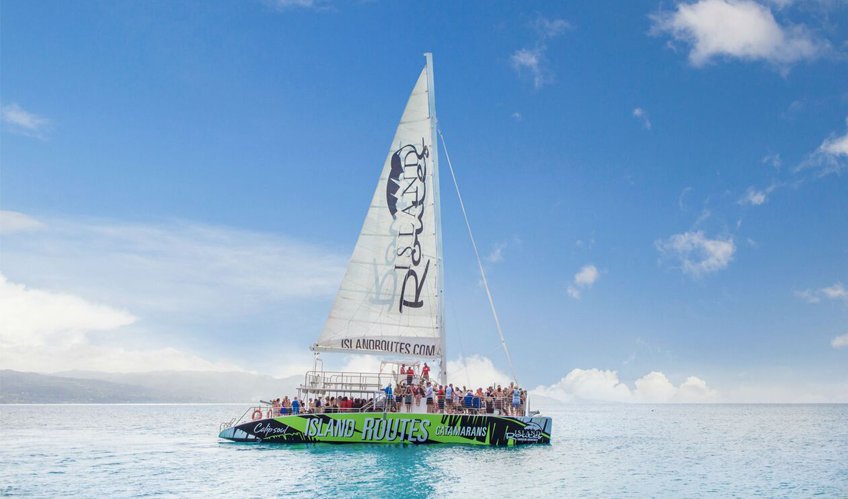
Embark on a luxury catamaran cruise adventure out of Ocho Rios, Jamaica that takes adventure to new heights.
Standing on the dock, I pause a moment to let my gaze travel slowly upwards at the gleaming catamaran floating before me. Rocking gently in the calm Caribbean Sea, the beautiful double-decker Calipsoul seems familiar yet exciting and new to me all at the same time. I had chosen Island Routes Catamaran Dunn’s River Cruise the last time I was in Ocho Rios, Jamaica. It had been the perfect combination of relaxation and excitement that I had been looking for. We had also done the romantic Lovers Rock evening cruise, literally sailing into the sunset together. Making the cruise reservation Both times it had turned out exactly as promised and this time around when I knew I was heading back to Jamaica, I reached out to the wonderfully helpful Island Routes team yet again. I spoke with them about how much I had enjoyed the last catamaran excursion I did with them and shared that this time I would be coming with a group of friends and family of all ages. I had enjoyed the snorkeling aspect of the Dunn’s River cruise so much but it had been fairly short and some of my group said they really wanted to let loose and relax.
Island Routes Reggae Family catamaran cruise They suggested the Island Routes Reggae Family catamaran cruise. They explained that it was like The Dunn’s River cruise minus the climbing, which my mom was happy to hear about, and a lot of time spent exploring the underwater world. Then they told me how great my timing was as they now have a brand new double-decker catamaran! To be honest, I couldn’t quite picture it so I didn’t know what to expect. Standing here, about to step onto the Calipsoul , I am filled with delight as the kids all leap aboard. We aren’t the only family on board that day and as my group is fairly large, coming over on the shuttle service from the Beaches all-inclusive family resort, I had been worried about feeling crowded. Yet, what we discover is the perfect blend of being able to find ample areas for ourselves while also having the opportunity to meet other people as equally excited as we are.
Snorkeling lesson Once in the water, we are directed by the crew, who have joined us, where to swim and, along the way, they make sure to point out coral formations and beautiful fish ensuring we have an amazingly immersive experience (pun intended). I explore for ages and I am very excited as I brought my waterproof camera with me this time and aim to meet my self-imposed challenge of taking an underwater selfie with tropical fish. Although unsuccessful because they move pretty quickly, I still have a blast. Suddenly, someone is tapping me on my shoulder and I pop my head up to see one of the crew members guiding me back to the boat. Making my way back I realize that, as strong a swimmer as I am, I’m pretty happy to have the life vest on as it allows me to keep looking underwater while I make my way back without having to put in too much effort in keeping myself headed in the right direction so all my focus is on the magical world below me. Trampoline for the kids, hammocks for the adults We climb aboard and the teenagers head to the trampoline area (I was told that’s what it’s called). For people who may not normally hang out on a boat, this area serves an engineering purpose but is also a pretty cool place to just hang out on as it’s like a flat stretched-out hammock where you can just lay out and chill. I divest myself of the fins, mask, and vest and realize I’m pretty hungry! Lunch on the ocean Luckily, the food comes out and everyone piles up their plates with tropical fruit, delicious wraps and chips, and salsa, and we head for a sunny spot on the upper deck of the catamaran. We start chatting with other people and decide it’s just about the right time for the rum version of that delicious fruit punch (after all we’re in Jamaica, how can we pass up the delicious rum when no one is driving or diving). My husband opts for a cold Red Stripe instead and leans back to work on his tan. Learning Jamaican dance moves We hear music and a lot of laughter below and realize the trampoline is empty. I decide to leave my husband happily tanning and I follow the music only to discover a full-blown dance class, as the crew is teaching everyone the latest Jamaican dancehall dance moves. Although I feel a little self-conscious when I join in, that quickly fades away as everyone tries their best to match the expertise of the crew. Over on the right, two little girls have their own crew member showing them what to do and they catch on quickly, delighted grins lighting up their faces. I manage to muddle through and I’m pretty sure my sister is going to show these videos to everyone once we get back home for an evening full of a similar level of laughter at my expense. In that moment though, I don’t care. I feel the salt from the sea drying on my skin, my hair is a tousled mess and I’m dancing with my children in the middle of the Caribbean Sea. This, I think, is what happiness is.
Check out the website for more information on Island Routes' catamaran cruises and other excursions they offer in Jamaica and elsewhere in the Caribbean. They’ll help you to book your perfect adventure today! You can also chat online or call US Toll-Free: 1.877.768.8370 Toll-Free Caribbean: 1.800.744.1150 International: 1.305.663.4364
Also, read Take The Driver's East Seat On An Island Routes Mini-Routes Adventure .
Stay tuned for the latest updates and discounts.
Facebook: @IslandRoutes Instagram: @IslandRoutes Twitter: @IslandRoutes

YOU MAY ALSO LIKE

5 scenic drives in Jamaica February 28th, 2017

10 best golf courses in Jamaica March 06th, 2017

10 things to do with kids in Jamaica March 06th, 2017

10 unique experiences in Jamaica March 06th, 2017
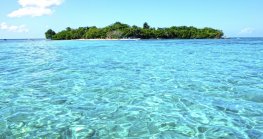
Food, Drink And Recipes

Best of Jamaica
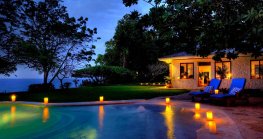
Real Estate
Lounge Experience
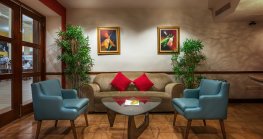
Cannabis Tourism

Posted by Facebook on Thursday, August 27, 2015

Unleash Your Inner Mystic

10 best golf courses in Jamaica

‘Wha' gwaan goodie’ - a guide to Jamaican greetings
© 2019 Jamaica Experiences All Rights Reserved

The global authority in superyachting
- NEWSLETTERS
- Yachts Home
- The Superyacht Directory
- Yacht Reports
- Brokerage News
- The largest yachts in the world
- The Register
- Yacht Advice
- Yacht Design
- 12m to 24m yachts
- Monaco Yacht Show
- Builder Directory
- Designer Directory
- Interior Design Directory
- Naval Architect Directory
- Yachts for sale home
- Motor yachts
- Sailing yachts
- Explorer yachts
- Classic yachts
- Sale Broker Directory
- Charter Home
- Yachts for Charter
- Charter Destinations
- Charter Broker Directory
- Destinations Home
- Mediterranean
- South Pacific
- Rest of the World
- Boat Life Home
- Owners' Experiences
- Interiors Suppliers
- Owners' Club
- Captains' Club
- BOAT Showcase
- Boat Presents
- Events Home
- World Superyacht Awards
- Superyacht Design Festival
- Design and Innovation Awards
- Young Designer of the Year Award
- Artistry and Craft Awards
- Explorer Yachts Summit
- Ocean Talks
- The Ocean Awards
- BOAT Connect
- Between the bays
- Golf Invitational
- Boat Pro Home
- Pricing Plan
- Superyacht Insight
- Product Features
- Premium Content
- Testimonials
- Global Order Book
- Tenders & Equipment
First Sunreef 88 double deck catamaran launched
The first hull in the Sunreef 88 range of double deck sailing catamarans has been launched in Gdansk for a European owner, the Polish yard has announced.
This fully personalised multihull superyacht measures 26.82 metres LOA and was styled inside and out by the in-house team at Sunreef Yachts .
In a statement, the Polish yard added that the design of the Sunreef 88 is “a great display of the shipyard’s non-conformist attitude and a genuine example of an avant-garde sailing catamaran concept”.
Captain Ian Sellers added: "She is a beautifully crafted, fully customised transoceanic catamaran, with superb quality and finish."
The design brief was focussed on three key themes: luxury, performance and privacy. To this end, the Sunreef 88 features more than 300 square metres of living space — an impressive figure for a yacht of this size, proving that bigger isn't always better .
This two-deck sailing yacht will feature an extensive flybridge with a central helm station and plenty of al fresco dining and relaxation spaces. Back aft, the cockpit features a central dining table with seating space for ten guests as well as a second sunbed, making good use of the Sunreef 88's 11.2 metre beam.
The in-house design includes sporty and dynamic exterior lines, as well as a fully customised interior layout. Key features include a mezzanine level in the saloon and a main-deck owner's cabin , which boasts superb views out to sea through panoramic windows.
Auxiliary power comes from a pair of 425hp engines drawing on a total fuel capacity of 8,000 litres, while her total sailplan is in excess of 345 square metres.
Sunreef added that the designers drew inspiration for this single-masted sailing yacht from the 35 metre flagship yacht Che , which was launched in 2010. The Sunreef 88 is the sixth superyacht from the Polish yard, which has also created the Sunreef 102 yacht Ipharra .
Similar yachts for sale
More stories, most popular, from our partners, sponsored listings.
36 double-decker catamaran
Alexandra resort beach, up to 25 passengers, from $1,680.00, boat details, 32 double-decker catamaran, 'what is included'.
All Your Gear (Fins, Mask, Vest), Beer, Rum Punch, Soft Drinks, Water, Grilled Fish, Gourmet Sandwiches (Half Day), Grilled Chicken (Full Day), Corn on the Cob (Full Day), Grilled Garlic Bread (Full Day), Peas & Rice (Full Day), Light Snacks
'Add-On Options'
Lobster (in season): $30/lb, Charcuterie: Small $70, Medium $120, Large $160,
Tubing: $50 Fishing: $350 + 12 fishing license for guests 16+ years old,
Veuve Clicquot Champagne: $150
'What To Bring'
Reef Safe Sunscreen, Towel, Your own reusable cup
Ice, Soda, Water : Please Check Description
Boat category : Pontoon, Catamaran
Meeting Point : The beach at The Alexandra Resort, just behind the front reception building.
Local Pick Up : Complimentary pick ups are available in the Grace Bay and Leeward areas only.
Food/Snacks : Please Check Description
Paddleboards : No
Specifications
Length : 32
Passenger Capacity : 25
Crew Capacity : 4
Sleep Capacity : 0
Year Built : 2015
Fuel Capacity : 350
Booking options
Boat location.
- How It Works
- About Boatsetter
Popular Regions
- Ibiza , Spain
- Barcelona , Spain
- Cancún , Mexico
- See all regions

DEK KAT 2680
Dek kat 2680 model.
Meet the new standard in nearshore and offshore coastal high-performance catamaran deck boats. With it’s revolutionary twin tunnel hull design, the Dek Kat 2680 is changing the game for inshore fishing by providing a large, stable fishing platform without sacrificing creature comfort options for the family.
BETTER FEATURES
With ample in deck storage, minimal bow rise on acceleration coupled with a shallow water draft of approximately 12”, the Dek Kat is fast becoming an in-shore guide favorite. At 26’ 2” inches long with a beam of 8’6” there is no other bay boat on the market that comes close to her deck space. The twin tunnels provide a stable and comfortable ride even when the weather is not fully cooperative.
If live bait fishing is your game, the 2680 comes standard with two large in deck live/release wells with the option for additional live wells above deck in the forward seating or in our custom leaning post configuration.
MORE COMFORT
The Dek Kat 2680 is a semi-custom built boat which is just as comfortable on the bay waters chasing trout and redfish as it is at the sand bar with your family. Our oversized hard tops keep the family comfortable with the shade and you will find an abundance of seating throughout the boat, including our custom Adirondack style seat built into the console. Built for fishing and comfort cruising, the Dek Kat is truly one of the most versatile bay boat designs out there. It is ready for whatever your weekend desires are upon the water.
BUILD YOUR DEK KAT
352-541-2800.
Email [email protected] Sales 352-222-7202
STAY IN TOUCH
Join our mailing list to stay up to date with our latest announcements!
- Accessibility Statement
COPYRIGHT 2024 © ALL RIGHTS RESERVED.
- Sign In or Register
- Boats for Sale
- Research Boats
- Sell a Boat
- Search Alerts
- My Listings
- Account Settings
- Dealer Advertising
- Deck Boat Catamaran
Deck Boat Catamaran Boats for sale
1-15 of 360
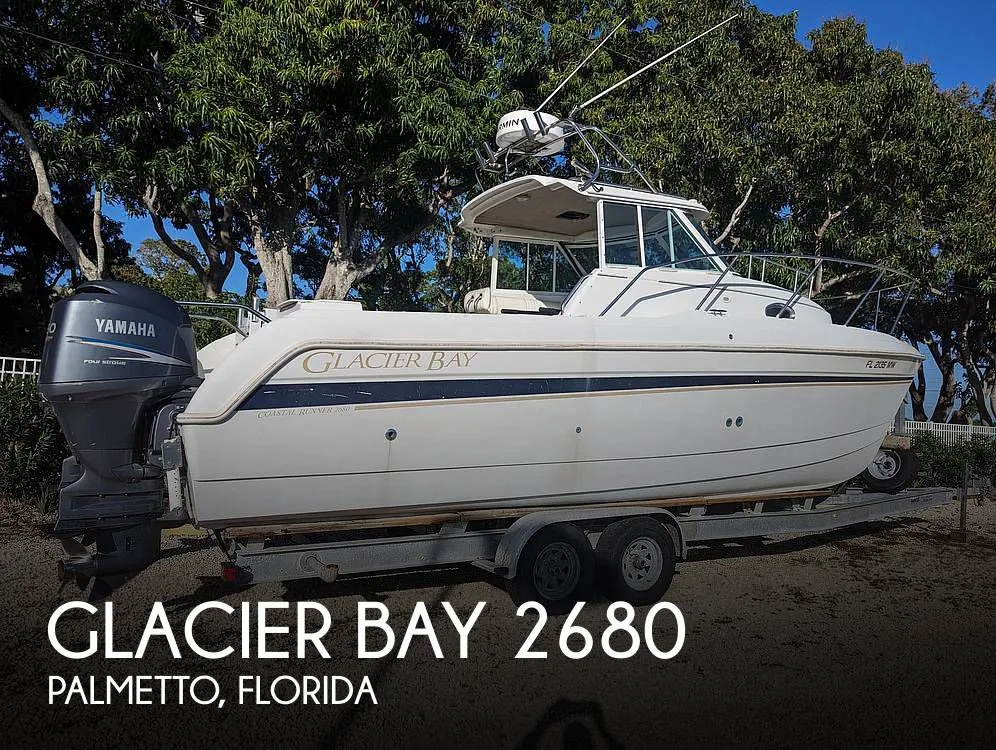
2005 Glacier Bay 2680 Coastal Runner
Palmetto, Florida
Make Glacier Bay
Model 2680 Coastal Runner
Category Power Catamaran Boats
Posted 2 Weeks Ago
This Glacier Bay is in good condition for her age. The seller just had the boat detailed and has a nice hull shine. The hull sides have a nice shine and are free from any major defects. The interior is clean and the electronics have been updated. The cabin is clean and ready for a new owner! Stock #388699 Power Catamaran! Offshore Ready! Just Detailed! Engines Run Great!! 2005 Glacier Bay 2680 Coastal Runner This is a nice power catamaran design with quality construction by Glacier Bay. This Coastal Runner features an interior cabin with room for two to sleep very comfortably and a plumbed head. The dual hull design with its wide beam, and high gunwales creates the perfect combination for a dry, stable ride, even in rough sea days. The cockpit features a wrap-around windshield and side windows with a hardtop overhead with two opening ports. The rear deck area has coaming pads for comfort, a huge live well and access to the integrated swim platform. There are plenty of rod holders and two fish boxes are in the floor. This design allows you to walk around the sides to the bow with handrails. The electronics were recently updated. There is a Garmin GPSMAPS 8612 xsv series 12" touchscreen IPS multifunction display chartplotter-sonar combo with BlueChart G3 and Lakeview G3. A Garmin GT56UHD-TM Traditional CHIRP High wide / UHD Clear-side transducer. A Garmin GMR Fantom 24x White 50 watt Solid State Radar, 60 RPM, 8 Bit Color, Dual Range, Overlay Support, and a Garmin Reactor 40 Hydraulic Corepack with SmartPump with GHC 50 Autopilot that has not been installed yet. Check out all the photos and call today to make it yours! Reason for selling is buying another boat.
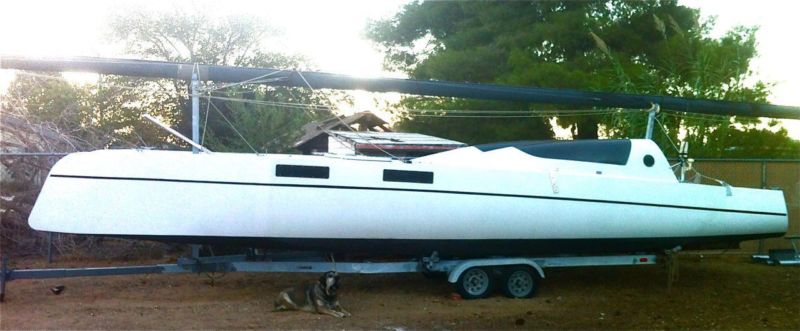
Santa Barbara, California
Posted Over 1 Month
Trailerable 34' catamaran. Demountable. Sets up in 1.75 hours. 34 LOA beam 20 mast 45' from water. This is a very fast cat with no light air problems at all. Brand new sails, sleeping in the hulls. Wave piercing bows. great galvanized trailer. Packs down to 8' wide for the road or shipping container. serious buyers only please. Asking 49k O.B.O. Here is the inventory list. This is quite possibly one of the finest custom Stilettos on earth. . Deluxe trailer. Quick set up. Racer / cruiser. Custom sleeping births in each hull. Professionally reconditioned to "like new" condition in 2005. structural glassed in bed frames with extra floatation, upsized sea hatches, Lewmar winches. 20' beam and transforms into 8' wide for trailering or fit into a shipping container and ship over seas. Set up to single hand. Room for plenty of friends or the whole family. She is wicked fast, handles like a dream with a light helm that is quick and responsive. This cat was originaly a "Stiletto 27" we added a 3' stern extention kit and a wave piercing bow off the Oracle pattern making it a full 34 feet. Length overall 34' Length at water line 34' beam 20' mast hieght from water line 45' Inventory: 12 volt gel cell. 2 Colligo endless line furliers with endless fid lines. 15 hp Mercury motor. starts and runs perfect. VHF radio with stern mounted antenna. Sony Marine AM/FM CD. Marine grade electronic panel with futures 3 12 volt charge adapters New autohelm with custom bracket Rear net/tramp from the webbing material of the big cat "Double Bullets" Two Openable port lights interior forward bow Custom Pro built mast rotator stainless differential Colligo line organizers Four Halyard clutches mast mounted Beautiful new custom centerboard. Garmin GPS Hull mounted GPS antenna. "SPOT" rescue system New gas tank. Galvanized trailer. twin axle New hevey duty hitch Custom built in sink and cabinets with fresh water tank New deluxe Porta Potti Two deck mounted anchor lockers Custom white marine grade cushions in almost new condition. 2 sets of oars new 6 new life jackets in the case. Main sail is full roach glass battens only used a couple times. w/ lazy jacks. Screecher used once. Brand new jib in the bag Second jib. Mylar very used but a lot of sailing left in it. Galvanized trailer with set of removable magnetic lighting. Custom aluminum motor mount Brand new all synthetic rigging . S.E. model with side windows at the head of the births. (Lexan) New Lexan canopies Glass high performance rudders. Two Adjustable tiller handles with shovel grips Center dagger board was custom made ( glass ) high performance foil aprox. 6' tall and its beautiful. New fire extinguisher, tool kit, compass, shade cockpit cover, big anchor with 30 feet of chain and a lot of rode, lots of extra lines and frankly I can't remember all thats in my boat so just come see it. lots of misc. This Catamaran is ready to trailer and sail right now. A ton of money and careful attention has been poured into this boat, Many more extras and lots of photos to serious qualified buyers only please. Shipping can easily be arranged. 49,000 U.S. Dollars

1999 Catamaran Berkstresser Boats 60
Clearwater, Florida
Make Catamaran
Model Berkstresser Boats 60
1999 Catamaran Berkstresser Boats 60 A 60 foot world cruiser, live aboard and term charter sailing catamaran that is fast, long, light, comfortable, efficient and easy to sail (single hand). Low maintenance design provides a safe and unsinkable vessel. Many windows, ports and hatches provide a lite, open and airy interior. Lots of locker space provides storage for gear and toys (dive gear, windsurf, kite and surfboards). Large aft deck for allows ease of setup for tender operation and setting up water toys. Large swim platform and swim steps provides for easy water access. This world cruiser, live aboard or term charter sailing catamaran provide accommodations for 1 to 10 persons in 4 cabins with queen size beds, private heads and showers and two separate crew cabins with single beds and lots of storage. Excellent opportunity exist for new owners to add to an existing fleet or to startup a new business. A real money maker with prior weekly BVI bookings in the $16,000-$22,000 range depending on the dates. Out-of-State buyers can now buy and use their boat in beautiful Florida for 180 days with No Florida Sales Tax! Ask your EYS broker for details.
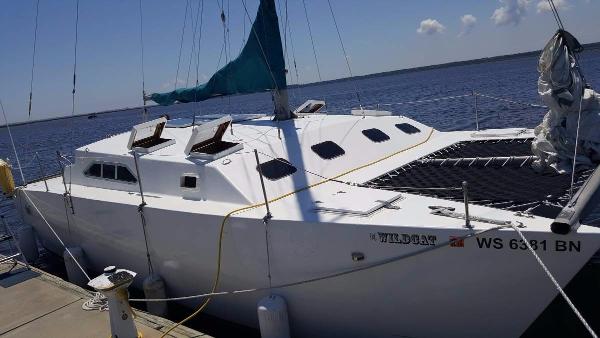
1987 Catamaran Hortsman 34'
Miami, Florida
Model Hortsman 34'
1987 Catamaran Hortsman 34' 34 1987 CATAMARAN HORTSMAN ONLY 70 HOURS PRACTICALLY BRAND NEW 2014 30HP HONDA UPGRADED ENGINE MOUNT AUTO PILOT 2017 SIMRAD GO 7XE CHART PLOTTER WITH SIDEVIEW SONAR 2, 40 GALLON FRESH WATER TANKS SOLAR PANELS UHF RADIO BRAND NEW CUSTOM BENCH BRAND NEW TOPSIDE DECK PAINTED SEA ANCHOR PARACHUTE SYSTEM HEAVY DUTY FRONT ANCHOR AND REAR ANCHOR LED LIGHTING AND TONS OF OTHER ACCESSORIES THAT WILL GO WITH THE BOAT There a ton of extras. We just upgraded everything just about for some blue water traveling. You really need nothing else to do to her. She is turn key at this moment. Financing available if needed.
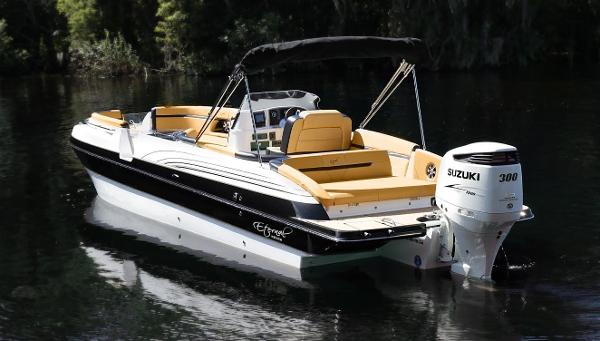
2016 Eternal Boats 28 Catamaran Deck Boat
Dunedin, Florida
Make Eternal Boats
Model 28 Catamaran Deck Boat
Category Deck Boats
2016 Eternal Boats 28 Catamaran Deck Boat Be sure to check out the above video highlighting key features of the boat! America's First True High Performance Catamaran Hull with Deck boat platform. Ladder with shower in front, Eternal door in front, Deck boat seating with plenty of storage underneath. 2 designated cooler areas. Standup porcelain head with electric flush, carbon fiber vanity with sink and shower. Under helm, double helm seat with flip up holster. Touch screen Garmin GPS with 2 digital gauges. All doors are backlit in blue. Under water blue courtesy lights. Back off the boat enhanced with play pen area which electrically raises to reveal additional storage. 2 ladders in the back with shower 1 ladder in front.
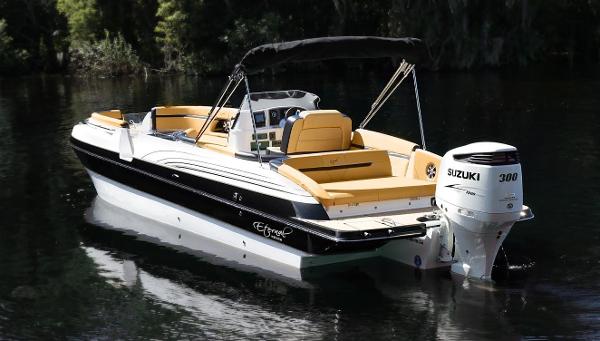
Category Powerboats
2016 Eternal Boats 28 Catamaran Deck Boat America's First True High Performance Catamaran Hull with Deck boat platform. Ladder with shower in front, Eternal door in front, Deck boat seating with plenty of storage underneath. 2 designated cooler areas. Standup porcelain head with electric flush, carbon fiber vanity with sink and shower. Under helm, double helm seat with flip up holster. Touch screen Garmin GPS with 2 digital gauges. All doors are backlit in blue. Under water blue courtesy lights. Back off the boat enhanced with play pen area which electrically raises to reveal additional storage. 2 ladders in the back with shower 1 ladder in front.
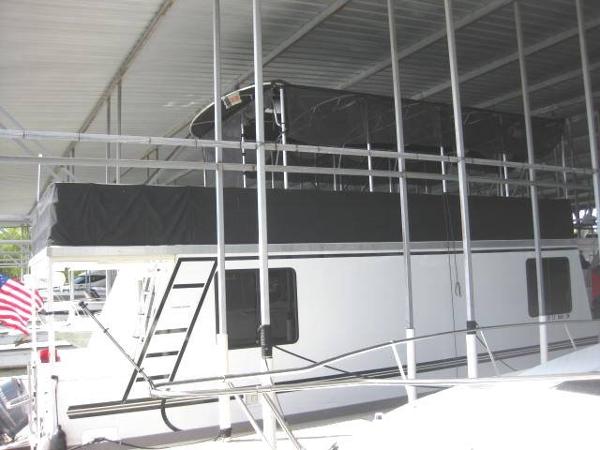
2012 Catamaran Cruisers Custom House Boat
Flower Mound, Texas
Make Catamaran Cruisers
Model Custom House Boat
Category Cruiser Boats
2012 Catamaran Cruisers Custom House Boat GREAT LIVE-A-BOARD!FRESHWATER USE ONLY!YAMAHA 115 FOUR STROKE! ONLY 48 HOURS!AIR CONDITIONING!GENERATOR!This VERY clean 39' x 12' custom houseboat is powered by a fuel efficient Yamaha 115hp four stroke outboard motor with only 48 hours. Wonderful light and bright layout with private stateroom, full galley and large head. Other features include large front and aft covered decks, docking lights, 30 amp shore power, rear & upper deck camera with monitor, depth finder, factory installed generator, roof top air conditioning, 2 flat panel TV's, High Powered Kenwood sound system with multiple speakers including six JL Audio bullet speakers outside and 3 amps, large dinette, sofa sleeper, hot water, stove, M/W, full size frost free refrigerator, private master stateroom with privacy door, large head with marine toilet and huge stall shower, lots of storage space, huge upper deck with custom made aluminum party top canopy and shade screens, fans, large flat screen TV and more. This would make a great live-a-board or weekend cruiser. NO TRAILER! All photos and videos shot October 1, 2016.Located on Lake Lewisville and turn-key ready for use!
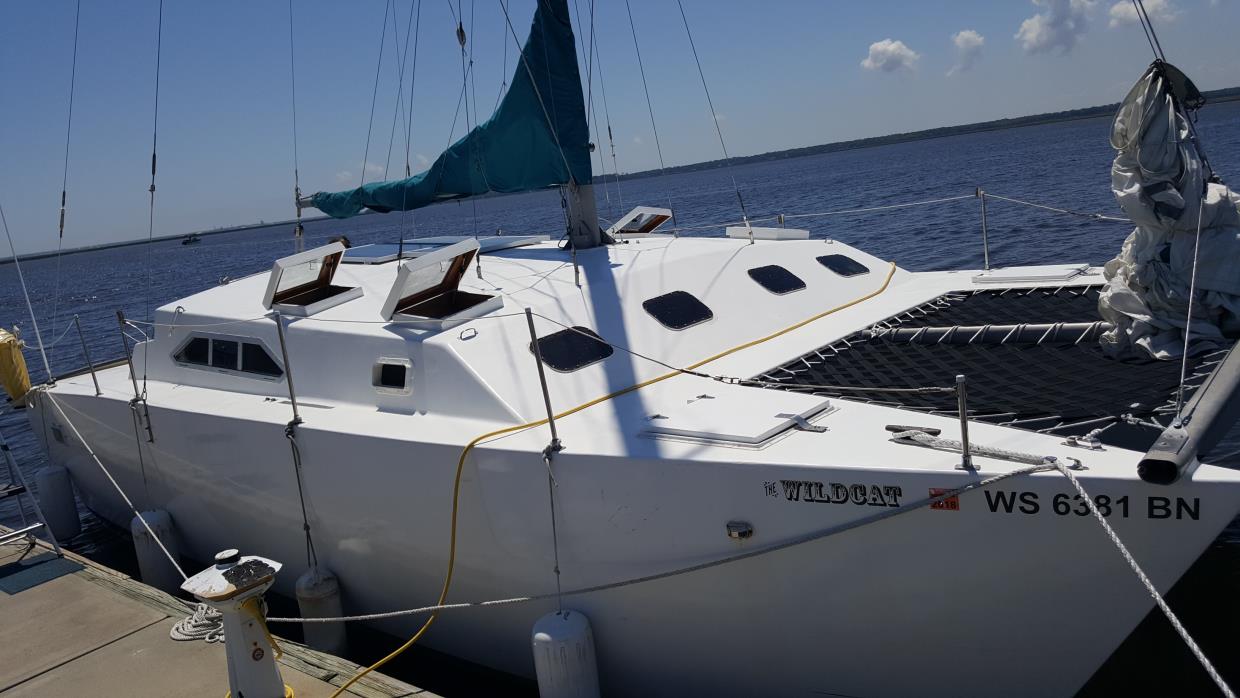
1987 Horstman Catamaran
Palm Beach Gardens, Florida
Make Horstman
Model Catamaran
Category Catamarans
1987 Horstman Catamaran Selling my beautiful sailing Catamaran. She is a 34 ft Hortsman. Built solid from wood and fiberglass. She will not sink. Great for a live aboard or just checking out beautiful places. There a ton of extras. We just upgraded everything just about for some blue water traveling. You really need nothing else to do to her. She is turn key at this moment. Comes with:3 SailsPractically brand new 2014 30hp HondaUpgraded engine mountAuto pilot2017 Simrad Go 7xe Chart plotter with sideview sonar 2016 Generator 2, 40 gallon fresh water tanks Solar panelsUHF radioBrand new custom benchBrand new topside deck paintedSea anchor parachute systemHeavy duty front anchor and rear anchorLED LightingAnd tons of other accessories that will go with the boatCall me at 904-Seven-Zero-Three-8273
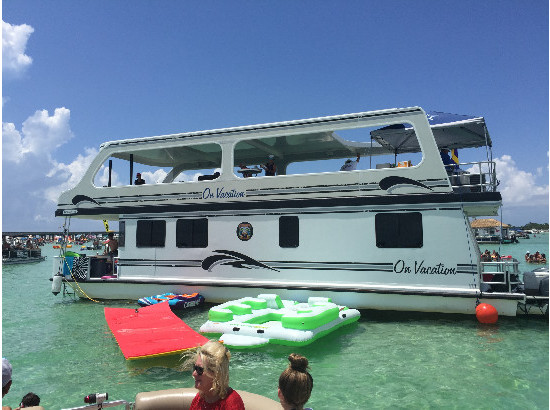
2002 Custom Catamaran
Raceland, Louisiana
Make Custom
Category Houseboats
2002 Custom Catamaran, Comfort on the water doesn't get much better!!!Introducing this 2002 Custom 52ft Catamaran Houseboat "On Vacation" manufactured by Louisiana Houseboats Inc. This 2 bedroom, 2 bath floating home has all the convenience of a fully furnished condominium with the capabilities to change your residency with the crank of an engine. The fully fiberglass hull is powered by twin 250 Yamaha outboards keeping engine maintenance low. The interior was newly refurbished for 2016 with new carpet throughout the boat as well as a new stack Whirlpool washer and dryer in the master. The 2nd story sundeck with fiberglass top features sofa style seating across the bow, with the entire deck being open to the stern maximizing the total area above. Why settle for a vacation home in one location when you can travel the coast without leaving the comfort of your living room sofa?Highlighted Features Include:-2 Bedrooms 2 Bath-New Carpet throughout the boat-New Stack Whirlpool Washer and Dryer-Fully Furnished Living room and Kitchen-Electric Cooktop stove, Oven & Microwave-Full size Refrigerator-Twin Yamaha 250 outboards (2006 model year)-600 gallon Fuel Capacity-600 gallon Fresh Water tank-Onboard Sewage treatment plant-23kw Isuzu Generator-2 50 amp shore power outlets (boats runs on 1)- Fresh water line hookup-Bose Sound system (top deck)**Boat is located in Louisiana on open waterways, No landlock transportation cost** $170000.00
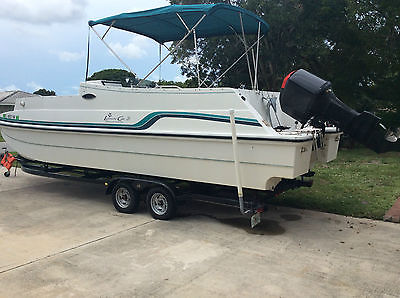
Leisure Cat 26 Catamaran Deck Boat with Trailer
Naples, Florida
Model Leisure Cat 26
Length 26.0
Leisure Cat 26 Catamaran Deck Boat with Trailer. Anchor & line, large bimini top, aft swim ladder, full cover, seat cushions, fresh water shower, and full lighted gauges. Power: 1998 225 HP Mercury outboard motor - serviced this year and runs perfectly. 2 new batteries and internal battery charger. 80 gallon fuel tank. Max capacity of 12 passengers. 2013 Bear Tritoon Trailer. Holds 24 to 26 foot Tritoon. Model PB 13-26TTL. 2 axles with drum brakes, adjustable rails, and in great condition.
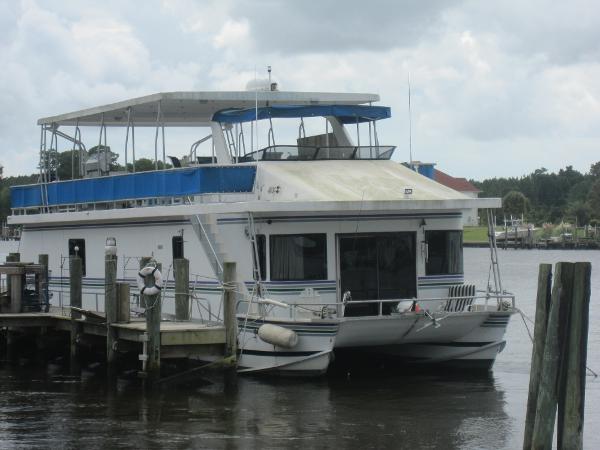
1998 New Orleans Catamaran House Boat
Wilmington, North Carolina
Make New Orleans
Model Catamaran House Boat
Category Power Catamarans
1998 New Orleans Catamaran House Boat Huge cruising home with trawler economy. With her 2002 straight inboard, prop protected 310hp cummins diesels. This three stateroom two head floating home has it all, from her upper and lower steering stations to her forward and aft decks and her massive upper deck for entertaining!!! Also available is the waterfront non-buildable lot w/90'x60' T-dock for $150K. Owner will give the buyer of the boat 6 months free dockage or will finance the sell of the land and dock.
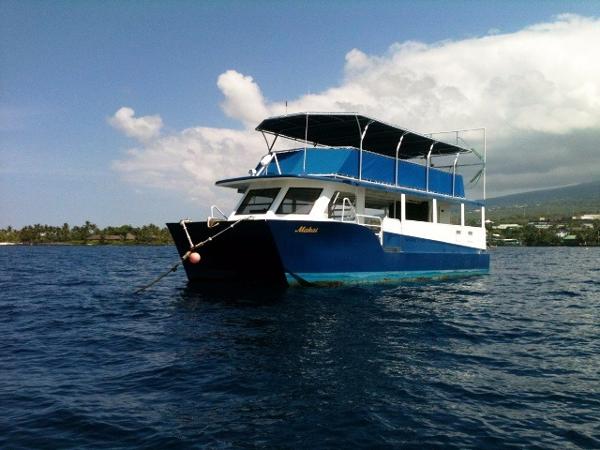
1991 Sea taxi Custom Catamaran Dive Boat
Fort Lauderdale, Florida
Make Sea Taxi
Model Custom Catamaran Dive Boat
1991 Sea taxi Custom Catamaran Dive Boat The Makai is 46 ft long 16ft wide 2-deck power catamaran. It is USCG inspected for 84 passengers. It has been used for sight seeing tours, snorkeling and scuba tours, sunset cruises, whale watching, private events and tendering for cruises ships, private yachts and the military.The vessel has 2 restrooms, fresh water shower, concessions bar, dive/swim ladder and upper deck lounge with cushioned seating. It just completed its bi-annual dry dock an annual inspection. Its hulls are solid fiberglass with glass over wood wing. Registered Dimensions: 46' x 16.4' x 5.2' Tonnage: 11 Gross / 8 Net Type/Trade: Twin Diesel Catamaran / USCG Passenger-Inspected, Coastwise Built in 1991 Opa Locka, Florida and re-powered in 2005. ADDITIONAL PERMIT AVAILABLE FOR PURCHASE: State of Hawaii commercial permit and mooring permit. This permit allows commercial operation from the Kailua Kona Hawaii pier in the heart of Kona. This pier is Kona’s cruise ship port which sees weekly cruise ship visitations. These permits are limited by the State of Hawaii.
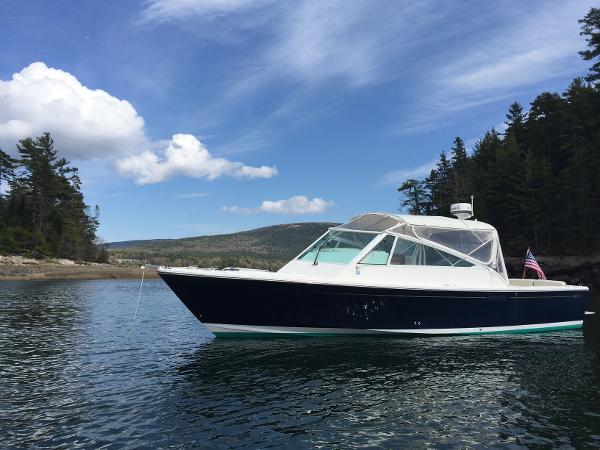
2012 Catamaran Coaches Trimaran
Make Catamaran Coaches
Model Trimaran
2012 Catamaran Coaches Trimaran PRICE REDUCTION! Want the most awesome deck boat ? Or are you thinking about launching a wildlife-watching, sea-touring, flats-fishing, kayaking, paddle-boarding or water yoga and shelling excursion business? THIS IS THE BOAT FOR YOU Custom composite and aluminum-railed 26-foot trimaran draws only 18 inches Two battery banks and an inverter power it all Great sound system Dance on the top deck or store kayaks and paddle boards there Lowrance chart plotter, VHF, live wells, wash down pump & filet table Ready for family fun or create your own business. Custom seating and a private head for your comfort Recent bottom paint No slip fees because a heavy-duty tri-axle aluminum trailer is included. Powered by a low-time (600 hours) Yamaha F350, this Florida-manufactured custom trimaran is strong, fast and reliable. Arrange a showing today.

Narrow Results
Current search reset all.
- Keyword: deck boat catamaran
- Wellcraft (19)
- Glacier Bay (11)
- Twin Vee (7)
- Glastron (5)
- Robertson And Caine (5)
- Sea Fox (5)
- Catamaran Cruisers (4)
- Fountaine Pajot (4)
- World Cat (4)
- Catamaran (3)
- 2 Criag Cats, 2 Mini Speed Boats,2 Jet Skis (2)
- Bayliner (2)
- CATAMARAN CRUISER (2)
- COBALT BOATS (2)
- Carolina Skiff (2)
- Catamaran Coaches (2)
- Catamaran Cruiser (2)
- Eternal Boats (2)
- Hysucat (2)
- Probio Plastic Boat (2)
- Sea Cat (2)
- Seawind (2)
- Splendor (2)
- 33rd Strike Group (1)
- 33rd Strike Group Power Catamaran (1)
- Advantage (1)
- Armadia (1)
- Barracuda (1)
- Beachcat (1)
- BoatYard (1)
- Carolina Cat (1)
- Chaparral (1)
- Desert Shore Yachts (1)
- Destination (1)
- Eliminator (1)
- Eric Lerouge (1)
- Force Engineering (1)
- Four Winns (1)
- GLACIER BAY (1)
- Glacier Bay* (1)
- Gulf Coast (1)
- H2X Custom (1)
- Hobie Cat (1)
- Horstman (1)
- Island Hopper (1)
- Island Packet (1)
- Lightning Power Boats (1)
- Mowdy Boats (1)
- New Orleans (1)
- OFFSHORE CATAMARANS (1)
- Ocean Cat (1)
- Pedigree (1)
- Perfection Boats (1)
- Pro Sports (1)
- Robertson & Caine (1)
- Sea Taxi (1)
- Shoalwater (1)
- Shuttleworth (1)
- Solaris (1)
- Sport Cat (1)
- Sportcraft (1)
- WorldCat (1)
- Catamarans (17)
- Power Catamarans (17)
- Sport Fishing Boats (11)
- Power Catamaran Boats (9)
- Powerboats (8)
- Center Consoles (7)
- Deck Boats (7)
- Houseboats (7)
- Sailboats (6)
- Bowrider Boats (5)
- Cruiser Boats (5)
- Bay Boats (4)
- Dual Console Boats (4)
- Fishing Boats (4)
- Center Console Boats (3)
- Racer Boats (3)
- Saltwater Fishing Boats (3)
- Catamaran Sailboats (2)
- Tender Boats (2)
- Aft Cabin (1)
- Aluminum Fishing Boats (1)
- Cuddy Cabin Boats (1)
- Flats Boats (1)
- Inflatable Boats (1)
- Motor Yachts (1)
- Pilothouse Boats (1)
- Pontoon Boats (1)
- Skiff Boats (1)
- Small Boats (1)
- Trawler Boats (1)
- Walkarounds (1)
- Florida (267)
- California (9)
- New York (8)
- Tennessee (7)
- North Carolina (6)
- Washington (6)
- Maryland (5)
- Connecticut (3)
- New Jersey (3)
- South Carolina (3)
- Virginia (3)
- British Columbia (2)
- England (2)
- Georgia (2)
- Illinois (2)
- Louisiana (2)
- Minnesota (2)
- West Virginia (2)
- Colorado (1)
- District Of Columbia (1)
- Eastern Cape (1)
- Kentucky (1)
- Massachusetts (1)
- Michigan (1)
- Mississippi (1)
- Provence-Alpes-Cote D'Azur (1)
- POP Yachts (9)
- Search Title Only
- Has Picture
- Include Sold Listings
Showcase Ads

2003 Harbor Master 520 Wide Body
Lecanto, FL

1998 ShoreLand'r LEB46TCBL

2006 Boston Whaler 150 Montauk
Chenequa, WI

2004 Sea Ray 270 Sundeck
Phoenix, AZ

2016 Malibu Wakesetter 22 MXZ
Browns Summit, NC

2004 Sea Ray 260 Sundancer
University of Richmond, VA

2010 Tige Z1
Create Alert
Please, name this search
Select Interval
Alert Successfully Created
- 1-855-932-1711
- My Account Hello Credits My Account Log out
Catamaran Sightseeing Cruise: Sea, Salt & Klein Bonaire
Kralendijk, Bonaire
Activity Level
Excursion Type
Local Sightseeing,25,All
Wheelchair Accessible
Starting At
Minimum Age
Information Not Currently Available
Approximately 2 Hours
Meals Included
Meals not included
Savor Bonaire's breathtaking seascapes from the Sea Breeze double-decker power catamaran .
You'll stop at the famous pink salt flats and white mountains of salt. Your guide will explain the salt production process.
Offshore from the historical white slave huts, learn some Caribbean facts and discover why these centuries-old huts are built next to the sea.
The catamaran approaches the uninhabited island of Klein Bonaire by way of the famous Bonaire Marine Park . Its protected reef makes it a divers' paradise. From up close, you will see Bonaire's most attractive white-sand beach. Its name, of course, is No-Name Beach.
Follow the coastline for exceptional panoramic views, and don't forget to look down into the crystal-clear turquoise water. Oceanfront hotels and restaurants and beautiful Dutch Caribbean mansions line the way back to the port.
Maximum age is 70 years. Maximum height is 6'6". Maximum weight is 330 lbs. Guests who are more than five months pregnant or have a heart condition, asthma, or leg or chest injuries and/or recent surgery are not allowed to participate. Not advisable for guests with mobility limitations.
- Popular Professionals
- Design & Planning
- Construction & Renovation
- Finishes & Fixtures
- Landscaping & Outdoor
- Systems & Appliances
- Interior Designers & Decorators
- Architects & Building Designers
- Design-Build Firms
- Kitchen & Bathroom Designers
- General Contractors
- Kitchen & Bathroom Remodelers
- Home Builders
- Roofing & Gutters
- Cabinets & Cabinetry
- Tile & Stone
- Hardwood Flooring Dealers
- Landscape Contractors
- Landscape Architects & Landscape Designers
- Home Stagers
- Swimming Pool Builders
- Lighting Designers and Suppliers
- 3D Rendering
- Sustainable Design
- Basement Design
- Architectural Design
- Universal Design
- Energy-Efficient Homes
- Multigenerational Homes
- House Plans
- Home Remodeling
- Home Additions
- Green Building
- Garage Building
- New Home Construction
- Basement Remodeling
- Stair & Railing Contractors
- Cabinetry & Cabinet Makers
- Roofing & Gutter Contractors
- Window Contractors
- Exterior & Siding Contractors
- Carpet Contractors
- Carpet Installation
- Flooring Contractors
- Wood Floor Refinishing
- Tile Installation
- Custom Countertops
- Quartz Countertops
- Cabinet Refinishing
- Custom Bathroom Vanities
- Finish Carpentry
- Cabinet Repair
- Custom Windows
- Window Treatment Services
- Window Repair
- Fireplace Contractors
- Paint & Wall Covering Dealers
- Door Contractors
- Glass & Shower Door Contractors
- Landscape Construction
- Land Clearing
- Garden & Landscape Supplies
- Deck & Patio Builders
- Deck Repair
- Patio Design
- Stone, Pavers, & Concrete
- Paver Installation
- Driveway & Paving Contractors
- Driveway Repair
- Asphalt Paving
- Garage Door Repair
- Fence Contractors
- Fence Installation
- Gate Repair
- Pergola Construction
- Spa & Pool Maintenance
- Swimming Pool Contractors
- Hot Tub Installation
- HVAC Contractors
- Electricians
- Appliance Services
- Solar Energy Contractors
- Outdoor Lighting Installation
- Landscape Lighting Installation
- Outdoor Lighting & Audio/Visual Specialists
- Home Theater & Home Automation Services
- Handyman Services
- Closet Designers
- Professional Organizers
- Furniture & Accessories Retailers
- Furniture Repair & Upholstery Services
- Specialty Contractors
- Color Consulting
- Wine Cellar Designers & Builders
- Home Inspection
- Custom Artists
- Columbus, OH Painters
- New York City, NY Landscapers
- San Diego, CA Bathroom Remodelers
- Minneapolis, MN Architects
- Portland, OR Tile Installers
- Kansas City, MO Flooring Contractors
- Denver, CO Countertop Installers
- San Francisco, CA New Home Builders
- Rugs & Decor
- Home Improvement
- Kitchen & Tabletop
- Bathroom Vanities
- Bathroom Vanity Lighting
- Bathroom Mirrors
- Bathroom Fixtures
- Nightstands & Bedside Tables
- Kitchen & Dining
- Bar Stools & Counter Stools
- Dining Chairs
- Dining Tables
- Buffets and Sideboards
- Kitchen Fixtures
- Wall Mirrors
- Living Room
- Armchairs & Accent Chairs
- Coffee & Accent Tables
- Sofas & Sectionals
- Media Storage
- Patio & Outdoor Furniture
- Outdoor Lighting
- Ceiling Lighting
- Chandeliers
- Pendant Lighting
- Wall Sconces
- Desks & Hutches
- Office Chairs
- View All Products
- Side & End Tables
- Console Tables
- Living Room Sets
- Chaise Lounges
- Ottomans & Poufs
- Bedroom Furniture
- Nightstands
- Bedroom Sets
- Dining Room Sets
- Sideboards & Buffets
- File Cabinets
- Room Dividers
- Furniture Sale
- Trending in Furniture
- View All Furniture
- Bath Vanities
- Single Vanities
- Double Vanities
- Small Vanities
- Transitional Vanities
- Modern Vanities
- Houzz Curated Vanities
- Best Selling Vanities
- Bathroom Vanity Mirrors
- Medicine Cabinets
- Bathroom Faucets
- Bathroom Sinks
- Shower Doors
- Showerheads & Body Sprays
- Bathroom Accessories
- Bathroom Storage
- Trending in Bath
- View All Bath
- How to Choose a Bathroom Vanity

- Patio Furniture
- Outdoor Dining Furniture
- Outdoor Lounge Furniture
- Outdoor Chairs
- Adirondack Chairs
- Outdoor Bar Furniture
- Outdoor Benches
- Wall Lights & Sconces
- Outdoor Flush-Mounts
- Landscape Lighting
- Outdoor Flood & Spot Lights
- Outdoor Decor
- Outdoor Rugs
- Outdoor Cushions & Pillows
- Patio Umbrellas
- Lawn & Garden
- Garden Statues & Yard Art
- Planters & Pots
- Outdoor Sale
- Trending in Outdoor
- View All Outdoor
- 8 x 10 Rugs
- 9 x 12 Rugs
- Hall & Stair Runners
- Home Decor & Accents
- Pillows & Throws
- Decorative Storage
- Faux Florals
- Wall Panels
- Window Treatments
- Curtain Rods
- Blackout Curtains
- Blinds & Shades
- Rugs & Decor Sale
- Trending in Rugs & Decor
- View All Rugs & Decor
- Pendant Lights
- Flush-Mounts
- Ceiling Fans
- Track Lighting
- Wall Lighting
- Swing Arm Wall Lights
- Display Lighting
- Table Lamps
- Floor Lamps
- Lamp Shades
- Lighting Sale
- Trending in Lighting
- View All Lighting
- Bathroom Remodel
- Kitchen Remodel
- Kitchen Faucets
- Kitchen Sinks
- Major Kitchen Appliances
- Cabinet Hardware
- Backsplash Tile
- Mosaic Tile
- Wall & Floor Tile
- Accent, Trim & Border Tile
- Whole House Remodel
- Heating & Cooling
- Building Materials
- Front Doors
- Interior Doors
- Home Improvement Sale
- Trending in Home Improvement
- View All Home Improvement
- Cups & Glassware
- Kitchen & Table Linens
- Kitchen Storage and Org
- Kitchen Islands & Carts
- Food Containers & Canisters
- Pantry & Cabinet Organizers
- Kitchen Appliances
- Gas & Electric Ranges
- Range Hoods & Vents
- Beer & Wine Refrigerators
- Small Kitchen Appliances
- Cookware & Bakeware
- Tools & Gadgets
- Kitchen & Tabletop Sale
- Trending in Kitchen & Tabletop
- View All Kitchen & Tabletop
- Storage & Organization
- Baby & Kids
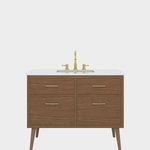
- View all photos
- Dining Room
- Breakfast Nook
- Family Room
- Bed & Bath
- Powder Room
- Storage & Closet
- Outdoor Kitchen
- Bar & Wine
- Wine Cellar
- Home Office
- Popular Design Ideas
- Kitchen Backsplash
- Deck Railing
- Privacy Fence
- Small Closet
- Stories and Guides
- Popular Stories
- Renovation Cost Guides
- Fence Installation Cost Guide
- Window Installation Cost Guide
- Discussions
- Design Dilemmas
- Before & After
- Houzz Research
- View all pros
- View all services
- View all products
- View all sales
- Living Room Chairs
- Dining Room Furniture
- Coffee Tables
- Home Office Furniture
- Join as a Pro
- Interior Design Software
- Project Management
- Custom Website
- Lead Generation
- Invoicing & Billing
- Landscape Contractor Software
- General Contractor Software
- Remodeler Software
- Builder Software
- Roofer Software
- Architect Software
- Takeoff Software
- Lumber & Framing Takeoffs
- Steel Takeoffs
- Concrete Takeoffs
- Drywall Takeoffs
- Insulation Takeoffs
- Stories & Guides
- LATEST FROM HOUZZ
- HOUZZ DISCUSSIONS
- SHOP KITCHEN & DINING
- Kitchen & Dining Furniture
- Sinks & Faucets
- Kitchen Cabinets & Storage
- Knobs & Pulls
- Kitchen Knives
- KITCHEN PHOTOS
- FIND KITCHEN PROS
- Bath Accessories
- Bath Linens
- BATH PHOTOS
- FIND BATH PROS
- SHOP BEDROOM
- Beds & Headboards
- Bedroom Decor
- Closet Storage
- Bedroom Vanities
- BEDROOM PHOTOS
- Kids' Room
- FIND DESIGN PROS
- SHOP LIVING
- Fireplaces & Accessories
- LIVING PHOTOS
- SHOP OUTDOOR
- Pool & Spa
- Backyard Play
- OUTDOOR PHOTOS
- FIND LANDSCAPING PROS
- SHOP LIGHTING
- Bathroom & Vanity
- Flush Mounts
- Kitchen & Cabinet
- Outdoor Wall Lights
- Outdoor Hanging Lights
- Kids' Lighting
- Decorative Accents
- Artificial Flowers & Plants
- Decorative Objects
- Screens & Room Dividers
- Wall Shelves
- About Houzz
- Houzz Credit Cards
- Privacy & Notice
- Cookie Policy
- Your Privacy Choices
- Mobile Apps
- Copyright & Trademark
- For Professionals
- Houzz vs. Houzz Pro
- Houzz Pro vs. Ivy
- Houzz Pro Advertising Reviews
- Houzz Pro 3D Floor Planner Reviews
- Trade Program
- Buttons & Badges
- Your Orders
- Shipping & Delivery
- Return Policy
- Houzz Canada
- Review Professionals
- Suggested Professionals
- Accessibility
- Houzz Support
- COUNTRY COUNTRY
Deck Builders & Contractors in Elektrostal'
Location (1).
- Use My Current Location
Popular Locations
- Albuquerque
- Cedar Rapids
- Grand Rapids
- Indianapolis
- Jacksonville
- Kansas City
- Little Rock
- Los Angeles
- Minneapolis
- New Orleans
- Oklahoma City
- Orange County
- Philadelphia
- Portland Maine
- Salt Lake City
- San Francisco
- San Luis Obispo
- Santa Barbara
- Washington D.C.
- Elektrostal', Moscow Oblast, Russia
Featured Reviews for Deck Builders & Contractors in Elektrostal'
- Reach out to the pro(s) you want, then share your vision to get the ball rolling.
- Request and compare quotes, then hire the Decks, Patio & Outdoor Enclosures professional that perfectly fits your project and budget limits.
- Deck Building
- Deck Lighting Installation
- Deck Refinishing
- Deck Staining
- Deck Waterproofing
- Gazebo Design & Construction
Some of the best decking materials include:
- Wood: Cedar, redwood, and tropical hardwoods offer a classic look but require regular maintenance.
- Pressure-Treated Lumber: Affordable pine that resists rot and insects but may need staining.
- Composite Decking: Low-maintenance blend of wood fibers and recycled plastic, available in various colors.
- PVC Decking: Synthetic option resistant to stains, scratches, and fading, but can be pricey.
- Aluminum Decking: Lightweight, durable, rust-resistant, suitable for water areas, but more expensive.
- Vinyl Decking: Low-maintenance, moisture, and rot-resistant, but quality varies.
It’s better to build a patio when:
- Privacy is a priority: Patio provides a sense of privacy, especially when enclosed.
- Budget and low maintenance are the priority: Patios are generally more cost-effective to build and require less maintenance.
- The ground is flat: For even ground, constructing a patio is easier and more straightforward.
It’s better to build a deck when:
- Scenic views are desired: Decks offer better views.
- You are fine with obtaining building permits and inspections: Decks typically require permits and inspections due to their structural impact on the home.
- The ground is uneven: If your backyard has slopes or uneven terrain, a deck can provide a stable and level outdoor space.
What services do deck and patio companies in Elektrostal', Moscow Oblast, Russia provide?
Questions to ask a prospective elektrostal', moscow oblast, russia deck installers and patio builder:, business services, connect with us.
Things to Do in Elektrostal, Russia - Elektrostal Attractions
Things to do in elektrostal.
- 5.0 of 5 bubbles
- 4.0 of 5 bubbles & up
- Good for a Rainy Day
- Good for Kids
- Good for Big Groups
- Adventurous
- Budget-friendly
- Hidden Gems
- Good for Couples
- Honeymoon spot
- Good for Adrenaline Seekers
- Things to do ranked using Tripadvisor data including reviews, ratings, photos, and popularity.

1. Electrostal History and Art Museum

2. Statue of Lenin

3. Park of Culture and Leisure
4. museum and exhibition center.

5. Museum of Labor Glory

7. Galereya Kino
8. viki cinema, 9. smokygrove.

10. Gandikap
11. papa lounge bar, 12. karaoke bar.
- Statue of Lenin
- Electrostal History and Art Museum
- Park of Culture and Leisure
- Museum and Exhibition Center
- Museum of Labor Glory

test. The Sunreef 88 DD hasn't forgotten any of the rules of super-yachting. Attention to detail and refinement is everywhere on board, making life enjoyable. The cockpit interior offers a good view forward across the water. From here, you can handle the boat while staying warm during night watches.
At the water, the Portless Catamaran inflates into an impressive 14.8-foot (4.5-m) cat with upper and lower decks designed to accommodate a total of six people. It's meant to go from car trunk to ...
The start of the ambitious Sunreef 88 Double Deck project was officially communicated during Sunreef Yachts' press conference at the Cannes Yachting Festival 2016. After eight months of intensive work, the shipyard proudly announced the launch of this catamaran with a zealous, sporty look. An experienced yachtsman switching from a massive ...
The Sunreef 92 Double Deck features almost 430 square meters of living space, twice as much as the Sunreef 82 Double Deck introduced in 2012. The enlarged deckhouse gives the owners greater comfort and the possibility to invite even more guests on a luxury cruise. The yacht will comfortably accommodate up to 12 guests giving each of them the ...
The double decker is capable of carrying 200 passengers out of the US,and 149 in US waters. The price is the base price without power and can be customized to fit your needs. This boat is fast and economical. Ron Cooper has built over 165 passenger catamarans, from 39' to 107'.
Using integrated stepped hull chins, the Sunreef 92 Double Deck catamaran increases interior space, without compromising performance. Now this yacht can accommodate up to 10 guests, in up to 5 double luxury suites, as well as a crew of four. ... Draft maximum (dagger boat): 1.60 m/5.2 ft
Check out the website for more information on Island Routes' catamaran cruises and other excursions they offer in Jamaica and elsewhere in the Caribbean. They'll help you to book your perfect adventure today! You can also chat online or call. US Toll-Free: 1.877.768.8370. Toll-Free Caribbean: 1.800.744.1150.
The first hull in the Sunreef 88 range of double deck sailing catamarans has been launched in Gdansk for a European owner, the Polish yard has announced. This fully personalised multihull superyacht measures 26.82 metres LOA and was styled inside and out by the in-house team at Sunreef Yachts.
To sum it up, embarking on a double-decker catamaran tour to discover Isla Mujeres is an incredible adventure that combines natural beauty, snorkeling, and island exploration. With the convenience of making a reservation and paying later, along with free cancellation up to 24 hours in advance, this tour offers flexibility for travelers.
32 Double-Decker Catamaran36 ft double deck power catamaran that can accommodate up to 30 guests comfortably. It features a built in bar, 2 loungers on the top deck, a diving board, a waterslide and bathroom. This is a great boat for a private charter.'What is Included' All Your Gear (Fins, Mask, Vest), Beer, ...
Spend the day soaking up the rays on the Caribbean Sea and Isla Mujeres when you book this great-value double-decker catamaran cruise with open bar. Stop to snorkel in the open sea, amid vibrant fish, coral and sculptures. Next, savor a delicious buffet lunch at an island beach club, with free time before you sail back to Cancun amid a spectacular sunset. Upgrade for transfers; all packages ...
Meet the new standard in nearshore and offshore coastal high-performance catamaran deck boats. With it's revolutionary twin tunnel hull design, the Dek Kat 2680 is changing the game for inshore fishing by providing a large, stable fishing platform without sacrificing creature comfort options for the family. Build Your Dek Kat.
Isla Mujeres Catamaran Tour with Snorkel, Open bar and Transportation from hotel. 1,088. Spring Break. from. $75.00. per adult (price varies by group size) Catamaran Tour to Isla Mujeres from Cancún with Bar and Lunch. 10.
Bays of Huatulco and Snorkeling on a Double Decker Catamaran cancellation policy: For a full refund, cancel at least 24 hours in advance of the start date of the experience. ... Surf was rough even for the large boat and 1 person got sea sick. Snorkelling was very good. The crew was great and we had a lot of fun. Read more. Written December 1 ...
Leisure Cat 26 Catamaran Deck Boat with Trailer. Anchor & line, large bimini top, aft swim ladder, full cover, seat cushions, fresh water shower, and full lighted gauges. Power: 1998 225 HP Mercury outboard motor - serviced this year and runs perfectly. 2 new batteries and internal battery charger. 80 gallon fuel tank.
Our Happy Fish II, is a Double Decker 34 feet Motor Catamaran with capacity for 30 guests that will give you a different experience of cruising along the Punta Cana and Cape Engaño crystal clear shallow waters. The Happy Fish II is a very accommodating boat, it has 1 bathroom, a Slide Toboggan, big shade area, upper deck and sound system.
Happy Fish II. Our Happy Fish II, is a Double Decker 34 feet Motor Catamaran with capacity for 30 guests that will give you a different experience of cruising along the Punta Cana and Cape Engaño crystal clear shallow waters. Only offered for Private Tours. The Happy Fish II is a very accommodating boat, it has 1 bathroom, a Slide Toboggan ...
Our Catamaran Party Boat Tour is a MUST when it comes to Punta Cana experiences. This booze cruise takes you along the Coast of Bavaro to the most popular Natural Pool in the Dominican Republic - and that's only the beginning! ... Private, All Inclusive, Double-Decker Catamaran in Punta Cana cancellation policy: For a full refund, cancel at ...
Approximately 2 Hours. Meals Included. Meals not included. Savor Bonaire's breathtaking seascapes from the Sea Breeze double-decker power catamaran. You'll stop at the famous pink salt flats and white mountains of salt. Your guide will explain the salt production process. Offshore from the historical white slave huts, learn some Caribbean facts ...
Search 1,121 Elektrostal' new & custom home builders to find the best custom home builder for your project. See the top reviewed local custom home builders in Elektrostal', Moscow Oblast, Russia on Houzz.
Find deck & patio builders near me on Houzz Before you hire a deck or patio builder in Elektrostal', Moscow Oblast, browse through our network of over 104 local deck & patio builders. Read through customer reviews, check out their past projects and then request a quote from the best deck & patio builders near you.
Strip Club 54 Sunset Boat Party Off Road Fury Barbados Camel Safari Las Vegas Three Tables Dive Site Ice Lagoon Adventure Boat Tours Elephant Jungle Sanctuary Samui Swift Creek Outfitters & Teton Horseback Adventures Odyssey Whale Watching Giorgos Pame Walking Tours
Find company research, competitor information, contact details & financial data for ELGLASS, OOO of Elektrostal, Moscow region. Get the latest business insights from Dun & Bradstreet.
hanse electric sailboat
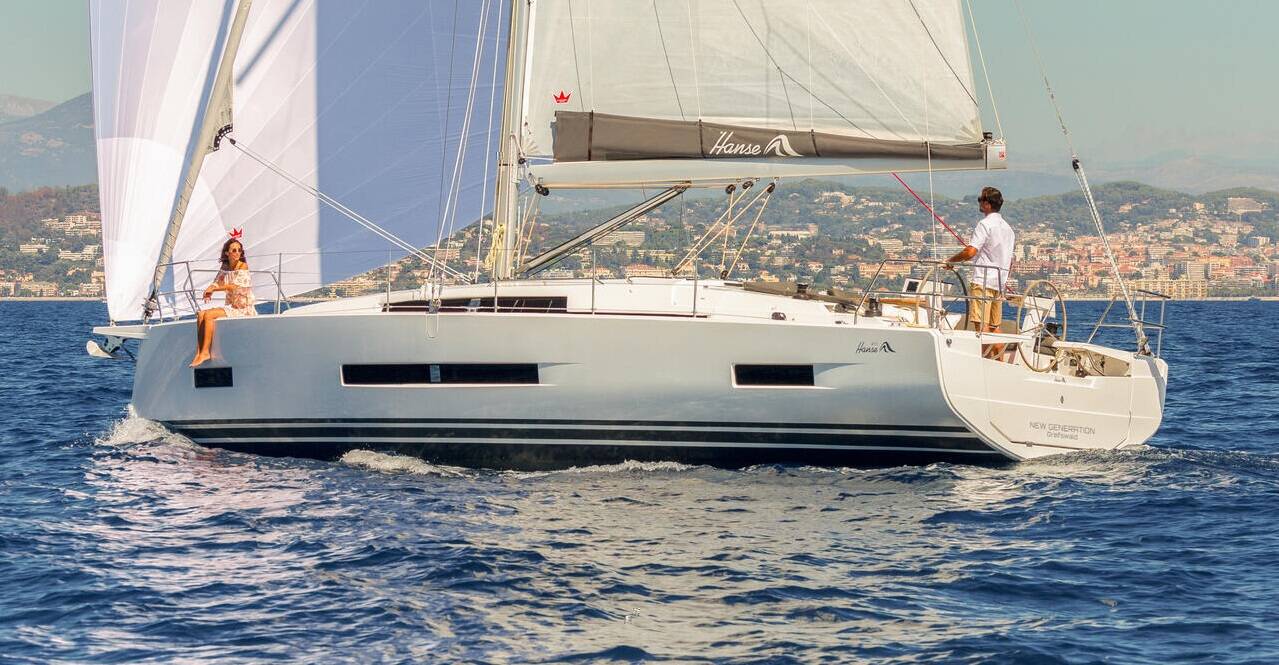
- Model Range

Design for the future. The Hanse 410.
Step into the future with the Hanse 410, where fashionable sailing harmonizes with eco-conscious values. The optimized hull design of this 41-foot yacht, featuring chines at the bow and stern, ensures a sleek waterline, providing the Hanse-typical uncompromising performance and ease while sailing. For the first time, the Hanse 410 introduces an optional electric propulsion system, boasting a remarkable range of up to 55 nautical miles. For even greater independence, a fuel cell delivers emission-free energy. Or, turn to the proven power of solar technology to keep essential appliances running on board without burning any fuel. The exclusive Sustainable Performance Sail (SPS) by Elvstrøm Sails is even made from recycled polyester, not only environmentally friendly but also fast on the water. Up to three expansive cabins and a welcoming salon, offer a genuine sanctuary with abundant space for relaxation. Cook in style on the waves! Experience a splash of gourmet in our galley, featuring ample storage, roomy workspace, and superior refrigeration. The Hanse 410 redefines elegance on the seas. With its class-first dual cockpit tables, there's an abundance of space and luxury seating, amplifying the sheer joy of a wind-driven journey.
Technical Specification
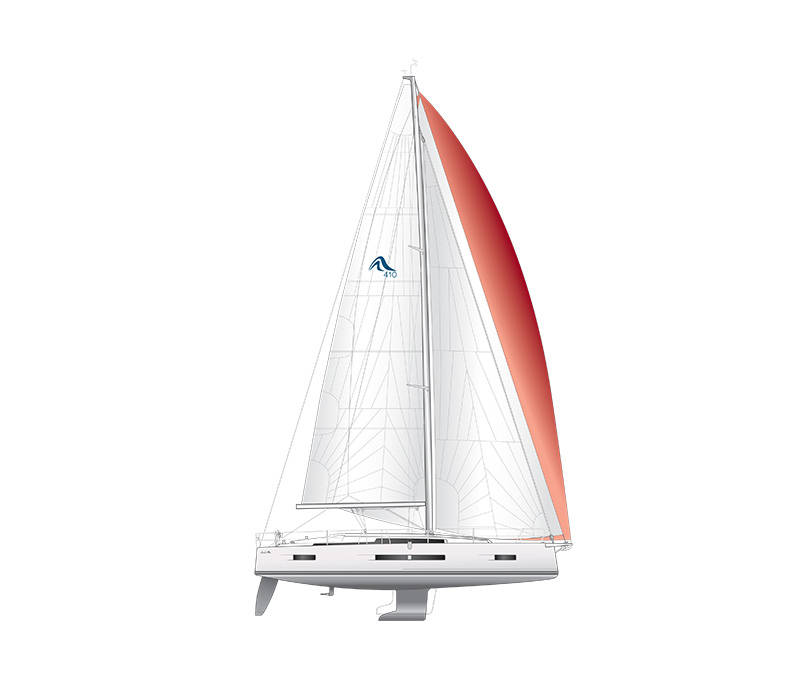
Try and Buy
Clear all doubts and experience your potentially new yacht firsthand before committing and final purchase.

Hanse Yacht World charter management program
Looking for the easiest way to your own boat? Choose our Hanse Yachting World charter management program that has already been recognized by many boat owners. Become a Hanse Yacht owner with minimal investment and enjoy the yacht's ownership without worrying about its maintenance.
If you are interested in buying yacht or need help planning your perfect vacation, contact us and our experts will gladly answer to all of your questions.
Request offer
You can find us in our headquarters:.
Address: Dražanac 2/a , 21 000 Split, CROATIA
Sales Office: +385 21 332 348
E-mail: croatia-yachting.hr
Office working hours: 8:00 – 16:00 CET
Feel free to ask us anything – our team is on your side!
For any yacht sales questions during the office hours please call our booking team in our Split headquarters on +385 21 332 348 or send us an e-mail on the address croatia-yachting.hr .
For urgent inquiries after working hours, you can contact our sales advisors individually on their mobile phones or send an e-mail and you will get a response as soon as possible:
e-mail: hanseyachts.hr
Mr. Domagoj Milisic - Sales manager
Mobile: +385 91 332 3320
Mr. Igor Karmelic - Yacht sales advisor
Mobile: +385 91 332 3322
Mr. Ivan Grabovac- Yacht sales advisor
Mobile: +385 91 332 3330
Croatia Yachting d.o.o. 2024. © All rights reserved.

E-Motion Rudder Drive, an electric engine with… the Propeller installed into the Rudder

Hanse Yachts introduces E-Motion Rudder Drive – an interesting propulsion type, with a special folding propeller….
An electric engine and a folding propeller have been installed into the rudder shaft, replacing the combination of diesel engine and sail drive. As a result, the propeller thrust is in line with the rudder position. This enables turning in the smallest circles or rotating around your own keel; it could be a perfect solution for maneuvering in narrow ports.
Making 4.5 knots with calm seas, the new Hanse 315 equipped with four lithium-ion batteries has a range of up to to 30 nautical miles – enough for all European inland waters and many coastal waters. At lower speeds, the range is significantly increased. The Rudder Drive can also be used with two batteries if a shorter range is required. The maximum speed is 6.1 knots – nearing the maximum speed of the diesel version.
The quiet Rudder Drive is also lightweight: 100 kg less than the diesel saildrive option. The Rudder Drive does not require a hole through the hull, lowering the resistance while sailing. The electric drive’s simplicity means less maintenance, as well.
E-Motion Rudder Drive: watch the video

From a standstill position, the yacht immediately starts to turn without having to pick up speed first. In addition, you enjoy all benefits of an electric engine. It will be the future?
7 Bluewater Cruising Sailboats We Love
Group beneteau: record full-year earnings in 2023, the countdown has begun for the new ice 66 rs, lagoon 60, freedom of space and panoramic views, live your passion, subscribe to our mailing list.
I think is a very good idea… I need to know if you sale this ingenio and to know the price and date of sending …Well as mucht as you can . Congratulations for that and awaiting for your news Carlos F Morante from Malaga Spain. For north wing 435
Dear Carlos, no we don’t sell it. We are a News Magazine. You have to contact Hanse Yachts (www.hanseyachts.com).
Best regards!
Nice, the space the engine takes is a lot. This would be great for smaller boats.
What provides the power? Diesel driving dc generator for the dc motor?
Yachting World
- Digital Edition

Hanse 460 review: First in a new range
- David Harding
- January 26, 2023
The Hanse 460 is the first in a new range of Hanses. From new designers, she is already a big hit, with over 200 sold and a European Yacht of the Year win to its name. David Harding reports

Product Overview
Price as reviewed:.
For some of us, sailing has always been about the functional and fundamental. We enjoy sailing for sailing’s sake. But today people want so much more from a boat and, in many respects, today’s yachts undoubtedly offer a lot more and the Hanse 460 attempts to do just that.
What you might loosely call the mainstream European builders of family cruising yachts have been following this path for some time, making each generation of designs bigger and plusher than the last. For Hanse in particular, it has been a rapid evolution from the small, basic and functional to the large and luxurious.
This latest Hanse is the first to be designed by Berret-Racoupeau. After the earliest models, which used the moulds of discontinued, slim-hulled Scandinavian designs, every Hanse has been designed by Judel/Vrolijk in what became one of boatbuilding’s most enduring and successful partnerships.
In line with modern trends, each new wave of Hanses has been higher, wider and more voluminous than the last. Founder Michael Schmidt never lost sight of the performance side, however. For all their growing girths and towering topsides, Hanse has always made boats that sail – competitively-priced, high-volume cruisers but with easy handling (self-tacking jibs were used from the early days) and better performance than many of the alternatives.
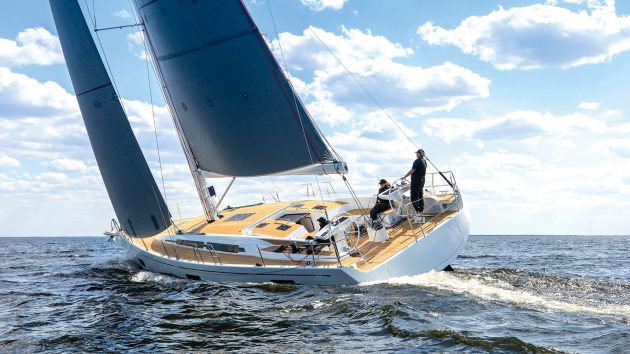
The single rudder is light and responsive on the helm. Photo: HanseYachts/Nico Krauss
The Hanse 460 is different. Very different. The first model from a new alliance with the French designers, it promptly won the European Yacht of the Year as the best Family Cruiser for 2022. A Hanse 510 version now follows.
The big question was whether Hanse had managed to do something different while retaining the qualities that its owners had traditionally sought.
At a glance, the Hanse 460 looks sleeker and sportier than earlier models; more angular, with a reverse rake to the bow and a pronounced knuckle running to about half-way aft. In Hanse tradition there are no hard-angled chines but, in this case, a pronounced soft chine towards the stern. In plan view you see full forward sections which, combined with the broad stern, generous freeboard and ample beam, hold the promise of enormous interior volume.

The 460’s generous and uncluttered cockpit. Photo: HanseYachts/Nico Krauss
At the other end, a moulded bowsprit projects the anchor clear of the stem and provides an attachment point for an outer forestay which can carry a reaching headsail. Large windows in the topsides help to break up the high freeboard.
Scale those topsides and you’re faced with an expanse of wide, flat deck and coachroof. Moulded bulwarks edge the side decks to help keep feet where they belong should you venture forward when the boat’s heeled. Otherwise what stands out is the uncluttered appearance – lines are led aft beneath separate mouldings – and the plethora of deck hatches hinged every which way, including one that opens to reveal a large bow locker.
There was certainly nothing to complain about in the performance and handling department. We slipped along very nicely on a flat sea in 12-14 knots of wind, clocking around 7.5 knots with the apparent wind at just under 30°, and tacking through around 80° by the compass.

Moulded bowsprit keeps anchor clear of the stem and provides attachment for the optional outer forestay. Photo: Andreas Lindlahr/EYOTY
Enjoyable sailing
Weather helm was slight and the load on the wheels increased relatively little if I tried bearing away with the sheets pinned in, the single rudder providing plenty of grip. Provoked in the opposite direction, she coped well when pinched mercilessly and also when thrown into tight spins, only stalling briefly.
At least in the flat water and modest breeze we encountered, the cockpit worked well. In any wind and seaway you would be pleased to have the optional second table to port as a bracing point. At the helm stations you have a comfortable perch outboard of the wheel or, for energetic downwind sailing when you might need both hands, behind it. The Jefa linkage is light and direct, giving a good feel from the rudder. On the starboard side you can wind down the bifurcated backstay when extra headstay tension is needed.

Hanse 460 is from Berret-Racoupeau. Photo: Andreas Lindlahr/EYOTY
Today’s cockpits are no longer just places from where you control the boat. Controlling the boat in itself is so much easier anyway, especially if – as most owners of the Hanse 460 will – you upgrade to electric winches, electric in-mast reefing and electric furling for the genoa on the outer forestay.
Other push-button options are for the hinge-down bathing platform and the cockpit tables (either side or both), which can be lowered to create large lounging areas. Alternatively there are fixed tables, as we had on the port side. A wet-bar can be added between the helm seats. It’s all part of making the cockpit a multi-function space in which every part can serve a variety of purposes. Cockpit stowage is in the form of a half-depth locker each side and – a first for Hanse – a dedicated liferaft locker right aft to starboard. With the electric-lowering option for the starboard table comes an extra moulded seat pod, which provides readily-accessible shallow stowage forward of the starboard helm and would be good to have for that reason alone.

Portlights and windows flood the saloon with natural light. Photo: HanseYachts/Nico Krauss
Moving about the deck and cockpit, and from one to the other, is easy in good weather. The wide open spaces let you simply stroll around – or lounge if you’re so inclined. Then again, they tend to present more of a challenge when a boat’s bouncing and heeling.
Lifestyle choices
Externally, the hull lines clearly differentiate the 460 from her earlier stablemates, but down below it’s a world apart. It’s certainly a more classy finish than we’ve seen before from Hanse; restrained in tone and a level above what we have become used to. Berret-Racoupeau is one of relatively few yacht design studios to have its own interior-design division.

Stateroom forecabin has generous stowage above and below the bed. Photo: HanseYachts/Nico Krauss
A host of interior layouts is available, from three to five cabins, up to four showers and from six to 10 berths. About the only constant is the presence of twin double cabins in the stern. Otherwise you can have different arrangements in the bow (cabins and heads) and amidships with a long or short linear galley and a bunk cabin or utility room to starboard where our boat had a chart table and heads compartment.
Details include backrests that hinge down in the saloon to provide trays and drinks-holders. You can press a button to lower the table, press another to pop up the TV from its central pod, and settle in for the evening.
Down here it’s all about sight-lines, integrating the different areas so no one feels left out, and ensuring that, as in the cockpit, every part of the layout performs multiple functions. In practice it creates a thoroughly pleasant and remarkably light environment.
If you enjoyed this….
Yachting World is the world’s leading magazine for bluewater cruisers and offshore sailors. Every month we have inspirational adventures and practical features to help you realise your sailing dreams. Build your knowledge with a subscription delivered to your door. See our latest offers and save at least 30% off the cover price.
Sometimes you come across a boat that makes you realise not only that yacht design has changed irrevocably, but also why it has changed and why it’s not going back. The Hanse 460 is unquestionably such a boat. How the crew lives aboard and moves around, both above and below decks, has clearly been thought about in the context of modern lifestyles. And this boat exudes style. If you like the fundamental design, you will be able to tailor many of the options and details to suit your tastes. A yacht like this is unlikely to slice to windward in heavy weather as comfortably as, say, a first-generation Swan 46, but most people aren’t really interested in that these days. I suspect the new Hanse will prove to be a pretty quick and competent all-rounder nonetheless. Simple sailing? The technology is not remotely simple any more. But with the Hanse 460, the sailing itself is simple and can still be a lot of fun.
JavaScript functionality for your browser has been deactivate. Please activate JavaScript so you can use all functions on this page.
- Back to overview
- Big Picture
- Press Releases
Technology cooperation for new sailing yacht drive
Rudder Drive, the new electric propulsion system for sailing yachts developed by Torqeedo together with the large-scale boat builder Hanse Yachts and rudder manufacturer Jefa, combines outstanding maneuverability and minimal weight with a powerful emission-free motor.
The core of this innovative concept is the proven and specially adapted Torqeedo Cruise 4.0 with folding propeller, designed in to the rudder blade itself. The streamlined system replaces the combustion inboard or saildrive and removes the need for a separate thruster on the new sailing yacht Hanse 315 e-motion rudder drive, which debuts at the end of October.
Outstanding maneuverability
Due to the unique rudder placement of the 4 kW (8 horsepower equivalent) Torqeedo electric motor, the motor can apply efficient, directional thrust. The Jefa rudder blade’s range of motion was extended to a total of 100 degrees. Demanding maneuvers can now be accomplished without a separate thruster. While motoring, the yacht can spin on its own axis – both forward and in reverse. While docking, the stern can easily be maneuvered into the proper position. This is highly useful in windy conditions or in narrow slips.
Exceptional endurance with minimal weight
Power generation while sailing
With integrated Torqeedo fast chargers, the emission-free version of the Hanse 315 is fully charged in just three hours. The batteries can be recharged at the dock or during sailing when the Rudder Drive’s folding propeller is used to generate power. Torqeedo is the only manufacturer of electric boat propulsion systems offering industrial engineering, complete system integration and ISO 9001 certified serial production in Germany.
World launch at the Hanseboot Hamburg
For the first time, the new propulsion system will be presented installed in the Hanse 315 e-motion rudder drive at the International Boat Show Hanseboot 2016 in Hamburg. We are looking forward to welcoming you to the Hanse Yachts booth (hall 6, booth C108) on Sunday, October 30, 2016 at 2 pm.
PDF Download
Pictures: Hanse 315 e-motion rudder drive motoring, Rudder Drive renderings
Published by Torqeedo GmbH Friedrichshafener Str. 4a 82205 Gilching Germany
Reprinting free of charge. 1 copy requested.
Next Articles
5 AUGUST 2016
12 JULY 2016
21 JUNE 2016
30 MAY 2016
Exalto Emirates LLC is Torqeedo’s new sales partner in the United Arab Emirates.
25 APRIL 2016
- BOAT OF THE YEAR
- Newsletters
- Sailboat Reviews
- Boating Safety
- Sailing Totem
- Charter Resources
- Destinations
- Galley Recipes
- Living Aboard
- Sails and Rigging
- Maintenance
- Best Marine Electronics & Technology

Nominee Spotlight: Hanse 510
- By Andrew Parkinson
- October 5, 2023
The Berret-Racoupeau-designed Hanse 460 turned heads as a 2022 Boat of the Year nominee with a fresh take on comfort and volume but with an eye better sailing performance. The second model in the new range designed by the Berret-Racoupeau team, the Hanse 510 is set to make its US premiere at the 2023 Annapolis Sailboat Show—again as a Boat of the Year contender. From what our editors saw at the model’s recent showing in Cannes, the 510 is expected to be a formidable opponent in its category during CW ’s Boat of the Year judging.
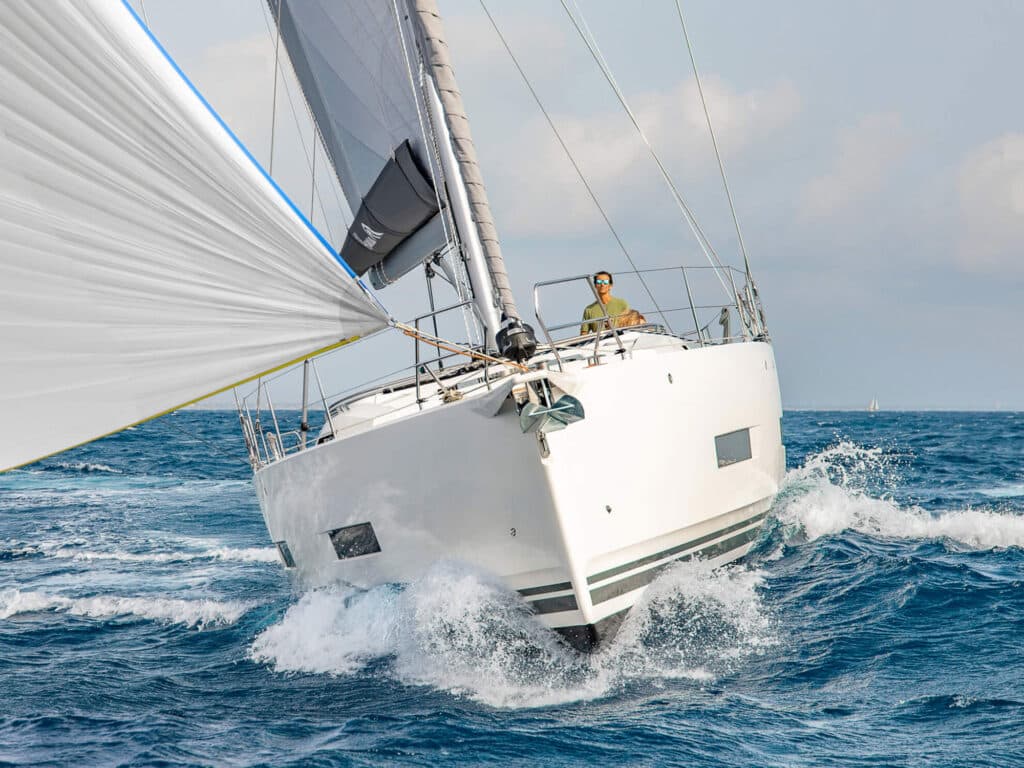
As for dockside demeanor, this new range’s calling card appears to be a marked chine on the bow and an inverted bow to optimize sailing performance. According to the designers, attention was also paid to refining the hull shape to maximize interior space. The result is an easy-on-the-eyes 51-footer that values smooth sailing and fast, comfortable cruising.
According to the builder, the Hanse 510 offers unrivalled volume in the 50-foot class, courtesy of an optimized hull design. Chines at the bow and aft further allow for a slim waterline, ensuring prime performance and easy sailing.
The 510 is equipped with a large, practical dinghy garage, capable of holding an inflated dinghy of up to 8.8 feet; and the optional, newly developed Hanse Smart Tender System makes launching that dinghy as simple as “driving a car out of the garage.” Convenience and style dominate the interior. Even the crew cabin gets in on the volume action, as it’s much more than the typical (read: small) crew sleeping space—it is a room worthy of staying a while. The options list is lengthy, and the boat can be highly customized to meet owners’ needs.
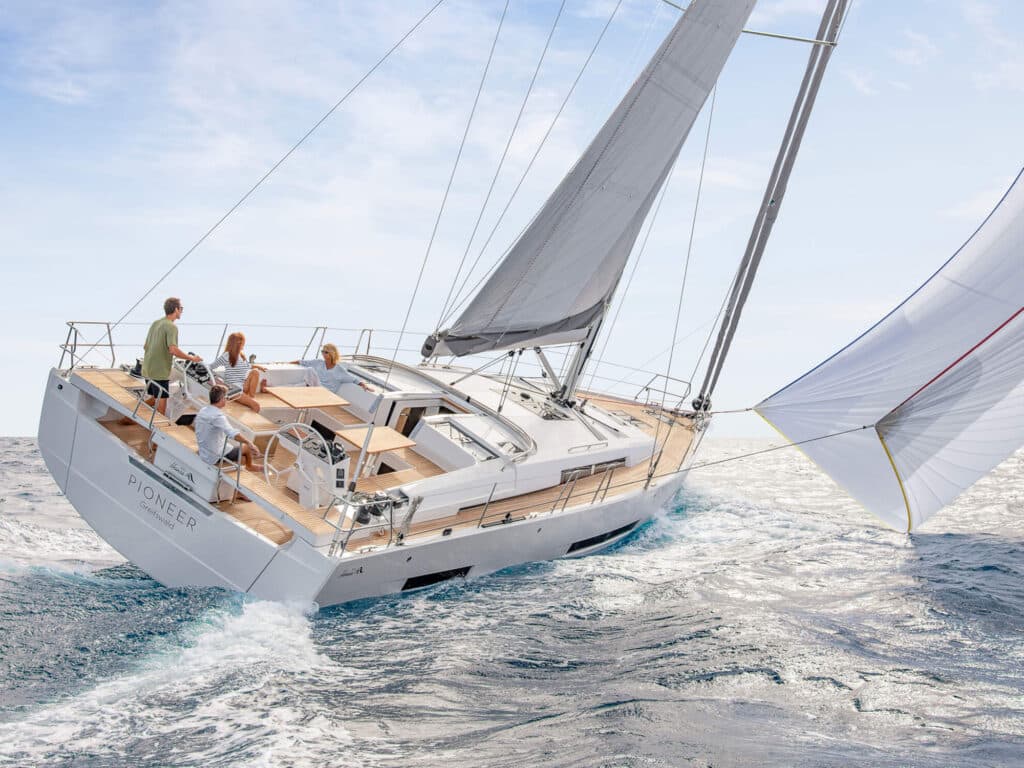
“Expectations were high after the outstandingly successful Hanse 460, which has been awarded European Yacht of the Year,” says Hanjo Runde, CEO of HanseYachts. “The new Hanse 510 is the logical and consistent further development of the new concept. With her impressive volume, tremendously dynamic lines and countless options, she is redefining the 50-foot class. It is an easy to sail and enormously spacious private retreat.”
The key talking points of the 510 are numerous. A hydrodynamic design with a slender waterline promotes better hull speed. Chines fore and aft allow for a wider hull and more interior space. The reverse, wave-piercing bow makes the yacht pitch less in strong winds, while the pronounced bow chines keep the foredeck as dry as possible. On deck, the strategically placed helm position promotes total control of the Hanse 510 in any situation, with all navigation and performance information easily accessible, as well as all lines and even the electric winches on the port side. An optional hardtop shades the entire cockpit including the steering positions, and it blends seamlessly with the boat’s silhouette. It is also available in several colors and accommodates special lighting and solar panels. A fixed windscreen is another option.
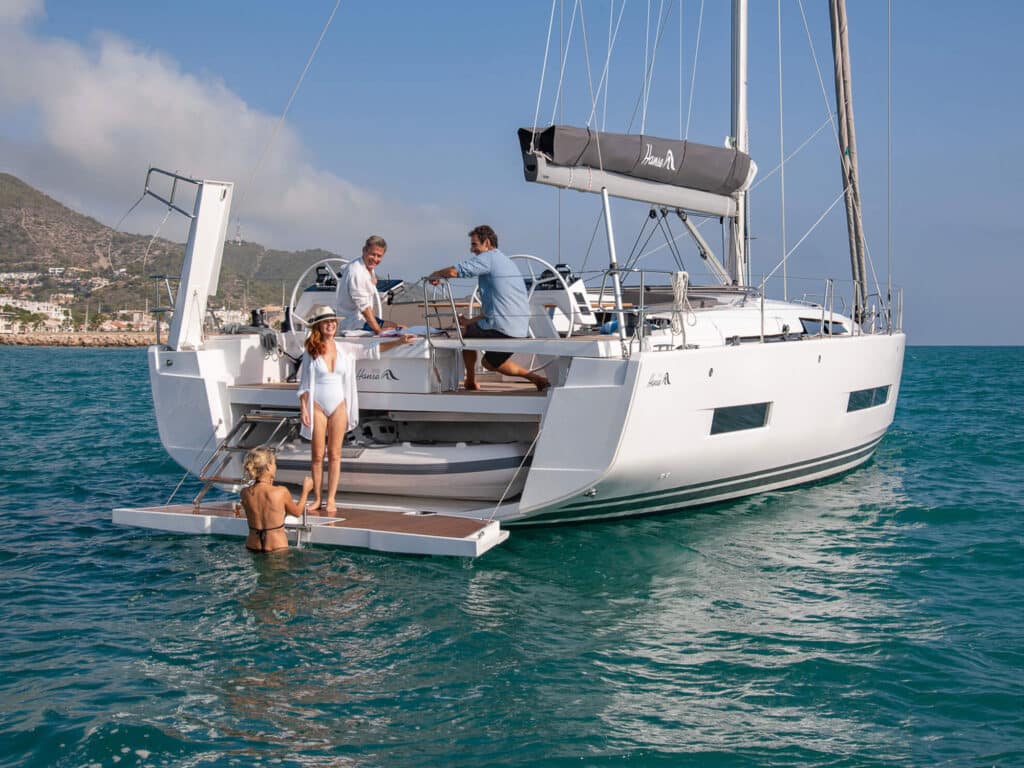
The novel dinghy garage is capable of holding a dinghy of up to 8.8 ft without having to deflate it. Combined with the optional automatic comfort stairs and the newly developed Hanse Smart Tender System, a single crew member can safely and comfortably deploy the dinghy, including engine, in minutes.
Another novelty on the Hanse 510 is the easy-to-open life raft storage space in the cockpit. Situated just in front of the companionway, it’s easily accessible and has space for standard 8-person life raft containers. An optional wet bar with grill and sink is hinged at the stern so as not to absorb precious cockpit space.
The boat comes rigged with a self-tacking jib, and all lines run back to the cockpit for simple sail handling of the 710 sq. ft. mainsail and various headsails. The jib is 570 sq. ft. and the reacher measures 1,011 sq. ft., set up using a Solent-style rig on the custom bowsprit. Air draft of the deck-stepped mast is just over 77 feet above the waterline. Optional electric furling systems and winches make light work of handling halyards and sheets for the optimum in performance, short-handed sailing. The standard boat comes with a single, 80 hp saildrive, although an upgraded, optional 110 hp diesel is also available.
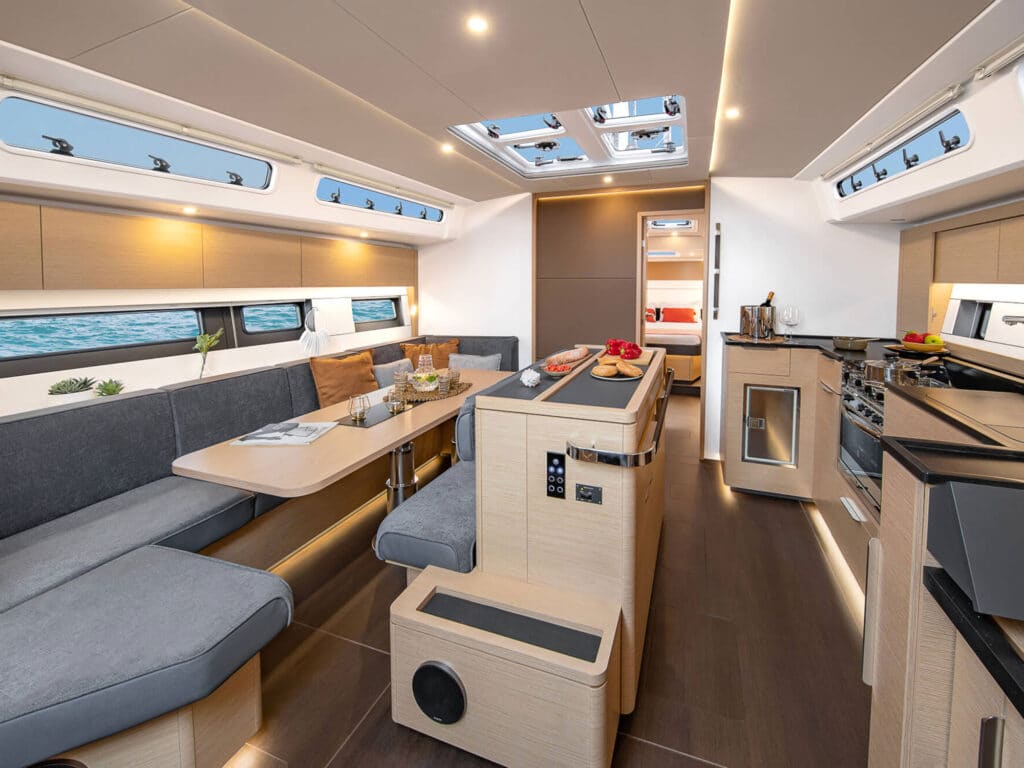
Within the interior, 14 well positioned opening hatches and eight opening windows and portholes permit maximum light and ventilation below deck. A long list of layout options are said to be available for the interior arrangement, from an “owner’s yacht” with a best-in-class sized master cabin, to a “charter yacht” with 10 berths, three bathrooms and an additional skipper cabin. The galley can be fully adapted to the owner’s needs as well: In addition to various refrigerator and freezer options, there is room for a wine cooler, dishwasher and a three-burner gas cooker plus an oven in the longitudinal pantry, which can be customized with a vast choice of colors and materials. Another option is a fully equipped navigation area with a forward-facing seat and a large salon table. The extensive options list, ranging from a washing machine in the utility room to flatscreens in the master cabin and salon, is crowned by the Flagship Package, which includes highest-end fabrics and materials, not to mention a “hidden” bar behind the folding backrest in the salon.
At its core, the Hanse 510 emphasizes a roomy cockpit, large but manageable sail plan, and overall performance that is easily managed by a couple, but perhaps what really sets the Hanse 510 apart from other sailboats in its class is the limitless level of customization the builder is willing to offer. The Hanse 510 also comes with a CE rating of A-12, so it is well suited for those who want to venture longer distances.
Hanse 510 Specifications
- More: 2024 Boat of the Year , Boat of the Year , hanse , Sailboats
- More Sailboats

Balance 442 “Lasai” Set to Debut

Sailboat Review: Tartan 455

Meet the Bali 5.8

Celebrating a Classic

Kirsten Neuschäfer Receives CCA Blue Water Medal

2024 Regata del Sol al Sol Registration Closing Soon

US Sailing Honors Bob Johnstone

Bitter End Expands Watersports Program
- Customer Service
- Privacy Policy
- Email Newsletters
- Cruising World
- Sailing World
- Salt Water Sportsman
- Sport Fishing
- Wakeboarding
The NKD Sailor
Electric Sailboats
For prospective buyers, here is a list of new sailboats that at the time of writing have an electric motor in their specifications , either in the standard configuration or as an option. (Updated 19.1.2022)
Please comment or send me an email ( [email protected] ) if you find errors or omissions.
Alva Yachts
- Ocean Sail 72 , 135 kW electric motor
- Ocean Sail 82 , 135 kW electric motor
Arcona Yachts
- Arcona 345 , Oceanvolt
- Arcona 385 , Oceanvolt
- Arcona 415 , Oceanvolt 15 kW
- Arcona 435 , Oceanvolt
- Arcona 465 , Oceanvolt
Domani Yachts
- Design S30 , Torqueedo Cruise 24V e-saildrive
- Design S32L , Torqueedo Cruise 48V e-saildrive, 4kW
Elan Yachts
- Elan E3 , Oceanvolt 8 kW.
- Elan E4 , Oceanvolt 8-10 kW.
- Elan E5 , Oceanvolt 10-15 kW.
- Elan E6 , Oceanvolt 15 kW or Oceanvolt 10 kW twin.
- Elan i40.1 , Oceanvolt 10-15 kW.
- Elan i45.1 , Oceanvolt 15 kW.
- Elan i50.1 , Oceanvolt 15 kW twin.
- Elan GT5 , Oceanvolt 15 kW or Oceanvolt 10 kW twin.
- Elan GT6 , Oceanvolt 15 kW twin.
Hanse Yachts
- Hanse 315 , Torqeedo e-motion rudder drive ,
Jeremy Rodgers Limited
- Contessa 32 new build , Beta/Hybrid-Marine ,
Salona Yachts
- Salona 33 , Oceanvolt 8 kW.
- Salona 35 , Oceanvolt 8 kW.
- Salona 38 , Oceanvolt 8 kW.
- Salona 41 , Oceanvolt 10 kW.
- Salona 46 , Oceanvolt 15 kW ( also with 2 x 10 kW ).
Spirit Yachts
- SPIRIT 44CR(E) , Oceanvolt 15 kW.
Viator Marine
- Viator Explorer 42 DS , 2 x Bellmarine DriveMaster 15kW 48V
- Viator Explorer 54 DS , 2 x ISCAD V50 50kW 48V
- WALLYNANO MKII , Oceanvolt 6 kW.
Antares Catamarans
- Antares 44 Hybrid , Hybrid Marine 40 HP Yanmar Parallel hybrid system
DNA Performance Sailing
- DNA G4 , Oceanvolt 6 kW.
HH Catamarans
- HH44 , 2 x BETA 30 + 2 x 10 kW parallel hybrid drives
- OC44 , 2 x BETA 30 + 2 x 10 kW parallel hybrid drives
- HopYacht 30 , 2 x 6 kW E-propulsion pod drive .
Independent Catamaran
- IC36 Independence , 2 x Oceanvolt 6 kW.
ITA Catamarans
- ITA 14.99 , 2 x Oceanvolt 15 kW with 1 x 15 kW generator.
Lady Hawke Catamarans
- LH 33 Comfort Eco , 2 x Oceanvolt 6 kW
Maverick Yachts
- Maverick 440 Hybrid , 2 x Oceanvolt 15 kW
Open Waters Yachts
- Open Waters ESC40 , 2 x 10 kW electric motors
- Outremer 4.zero , 2 x Oceanvolt 10 kW.
SeaQuest Catamarans
- SeaQuest 46 , 2 x Oceanvolt 15.1 kW
Slyder Catamarans
- Slyder 49 , 2 x 22 kW electric motors
- Slyder 59 , 2 x 25 kW electric motors
Sunreef Yachts
- Sunreef 50 Eco Yacht , 2 x 40 kW electric motors
- Sunreef 60 Eco Yacht , 2 x 70 kW electric motors
- Sunreef 70 Eco Yacht , 2 x 90 kW electric motors
- Sunreef 80 Eco Yacht , 2 x 160 kW electric motors
- Sunreef 100 Eco Yacht , 2 x 270 kW electric motors
Vaan Yachts
- VAAN R4 , 2 x Torqeedo FP10 10 kW saildrive (standard), 2 x Oceanvolt 15 kW (option)
- VAAN R5 , 2 x Torqeedo Deep Blue saildrive 25 kW or 2 x Oceanvolt 15 kW
- Windelo 50 Adventure (also Yachting and Sport versions), 2 x Bellmarine 20 kW electric motors.
- Windelo 54 Adventure (also Yachting and Sport versions), 2 x 24 kW Bellmarine electric motors.
The little (electric) engine that could: The Port of San Diego unveils the nation’s first all-electric tug boat
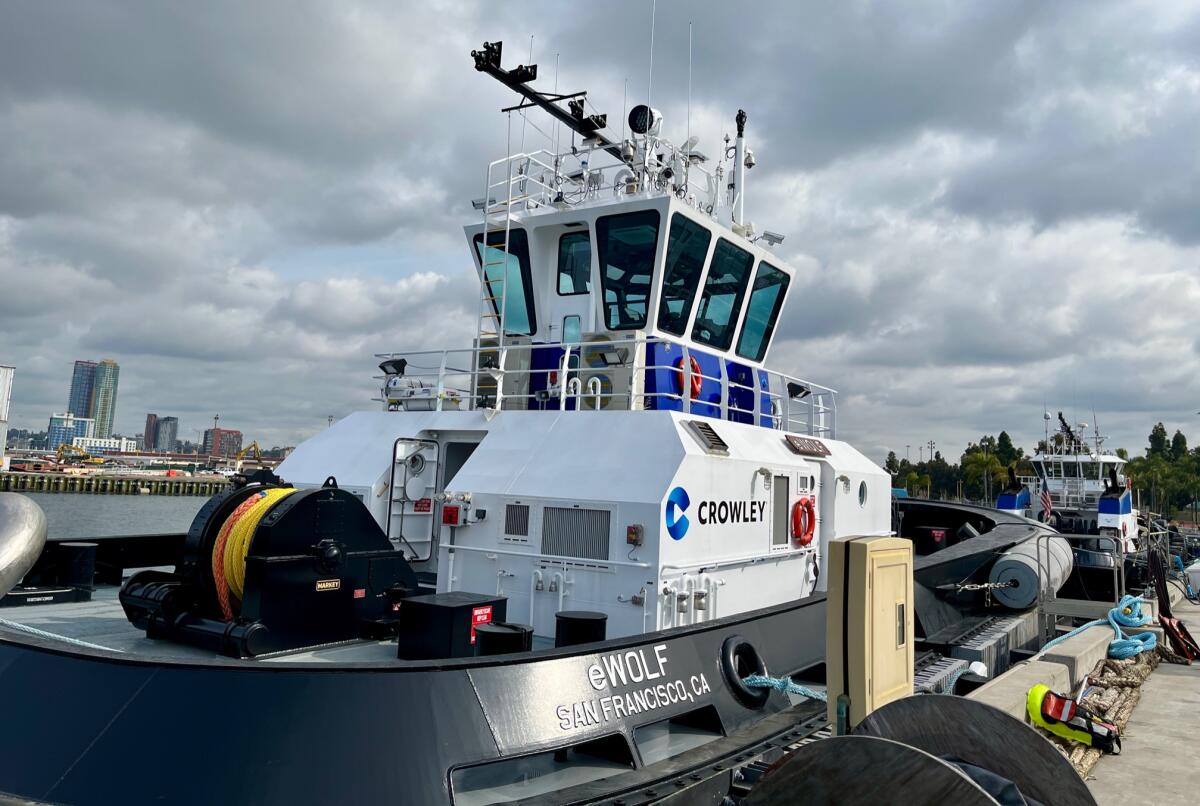
The 82-foot eWolf expects to eliminate 3,100 metric tons of carbon dioxide
- Show more sharing options
- Copy Link URL Copied!
The nation’s first all-electric tug boat has docked at the Port of San Diego and expects to begin emissions-free operations in about a month.
Operated by Crowley Maritime Corporation , the 82-foot eWolf will escort ships entering and leaving the Tenth Avenue Marine Terminal using electric power instead of diesel fuel, helping slash greenhouse gas emissions at the port and its neighbors in Barrio Logan and National City.
For the record:
1:58 p.m. March 13, 2024 This story has been updated to show the correct amount of government funding that went to the project.
“This is a big deal,” said port chairman Frank Urtasun at a news conference Monday. “This is new technology.”
Capable of speeds of up to 12 knots, the eWolf is powered by a 6.2 megawatt-hour main propulsion battery and two electric drives. The tug has thrust — also known as bollard pull in the parlance of the shipping industry — of 76.8 short tons, which is more powerful than the diesel-powered counterparts at the port.
Constructed in Alabama, the eWolf is equipped with two small generators for emergency use that allow the boat to travel longer distances at a reduced speed.
“Like an electric car, you step on the gas and it jumps,” said Paul Manzi, vice president of Crowley Shipping, based in Jacksonville, Fla. “All of the attributes that you have with an electric motor operation in a car or in an electric truck, you see here in the (eWolf) at massive scale. And it’s extremely quiet so when it pulls away from the dock you literally won’t hear any noise.”
The tug boat’s electricity will come from a charging station that is part of a microgrid facility equipped with two energy storage containers. Battery modules in each container have storage capacity of nearly 1.5 megawatt-hours.
Interconnected with the help of San Diego Gas & Electric, the charging station at the port is designed to allow the vessel to recharge quickly and reduce peak loads on the electric grid.
Operators plan to charge the eWolf overnight so it can perform its chores during daytime hours.
“This technology has individually been around for a while, but it hasn’t necessarily been integrated and optimized to all work together — and that’s kind of our role,” said Bruce Strupp, vice president at ABB Marine & Ports , the company that designed the boat’s propulsion system. “Some of the technology is our technology, some of it’s third-party technology, but we integrate it all together.”
The electric tug boat is expected to begin commercial operations at the port in mid- to late-April, depending on the completion of the charging station.

Officials at Crowley did not release the eWolf’s price tag Monday, saying only that it cost about twice as much as a conventional diesel-powered tug boat of comparable size.
But, Manzi said, the company expects the eWolf’s maintenance and operating costs will be “dramatically lower” than what’s spent on a diesel-powered tug boat because the electric model has fewer moving parts.
The entire project — the vessel as well as the charging station — received four grants that added up to $13.67 million, with two grants of $10.9 million from the San Diego Air Pollution Control District, one grant of just over $2 million from the U.S. Environmental Protection Agency and $750,000 from the federal government’s Maritime Administration.
In 2020, Gov. Gavin Newsom signed an executive order that directed state agencies to transition off-road vehicles — including tug boats — and equipment to 100 percent zero emissions by 2035.
By replacing one of the port’s diesel-powered tugs, the eWolf is expected to eliminate the consumption of about 35,000 gallons of diesel fuel per year. In its first 10 years of use, the electric tug boat is expected to reduce about 3,100 metric tons of carbon dioxide from the port and its surrounding areas such as Barrio Logan and National City.
“We’re trying to be good neighbors and trying to be able to help to reduce emissions here to help the electrification movement,” Urtasun said, adding that the port has spent about $130 million on various electrification projects.
Last year, the Port of San Diego became the first in North America to install a pair of all-electric cranes to load and off-load heavy cargo. Each 262 feet high, the cranes replaced an older crane that ran on diesel fuel. Together, the cranes expect to help the port reduce greenhouse gas emissions by 47 metric tons per year.
Get U-T Business in your inbox on Mondays
Get ready for your week with the week’s top business stories from San Diego and California, in your inbox Monday mornings.
You may occasionally receive promotional content from the San Diego Union-Tribune.

More from this Author
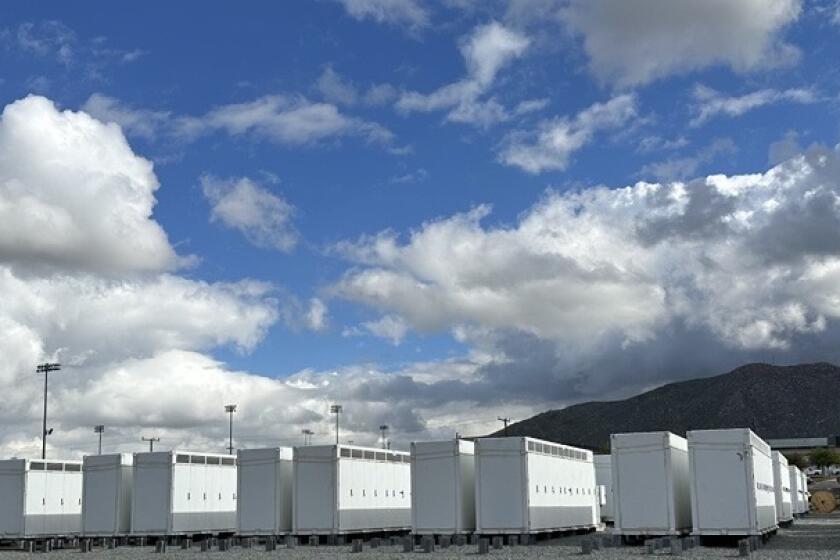
San Diego Community Power signs agreement for big energy storage project that could power 45,000 homes
March 21, 2024
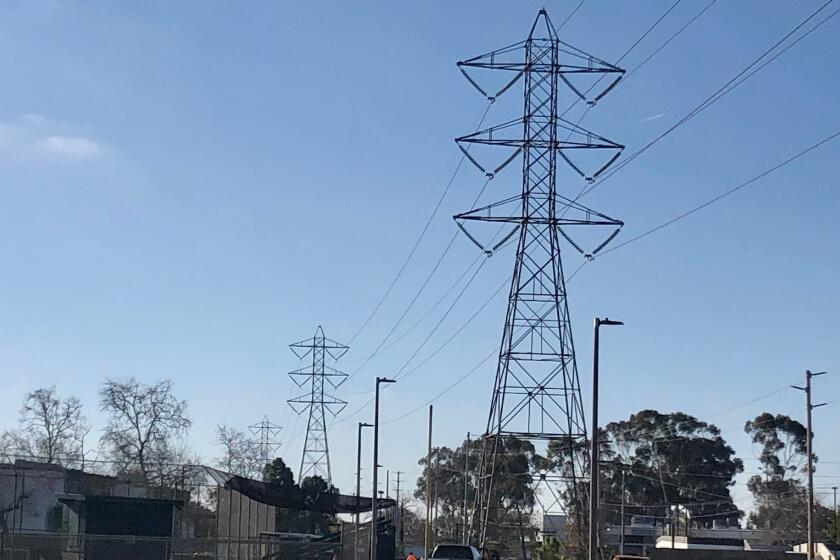
If the city of San Diego ran its own municipal utility instead of using SDG&E, how much would it cost?
March 15, 2024
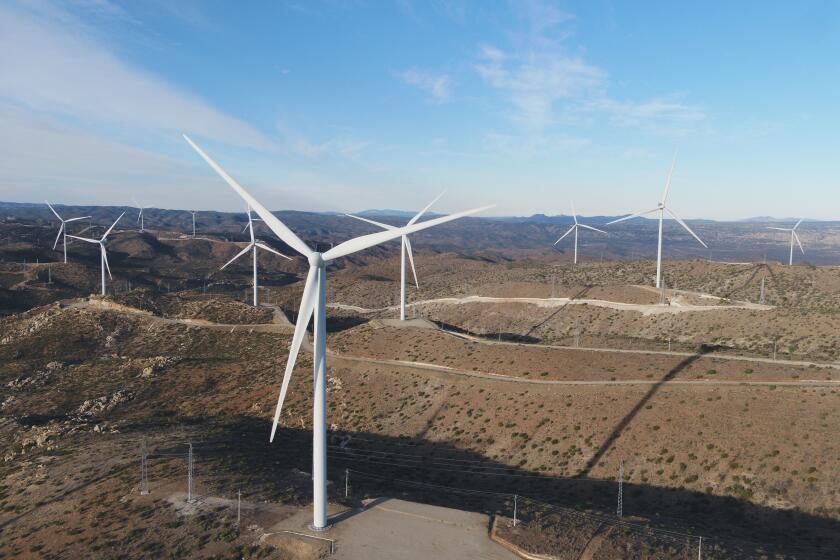
Blowin’ south of the border: Sempra subsidiary will build a new wind farm in Mexico

San Diego EV charging company completes $1 million deal with the U.K.’s defense ministry
March 12, 2024
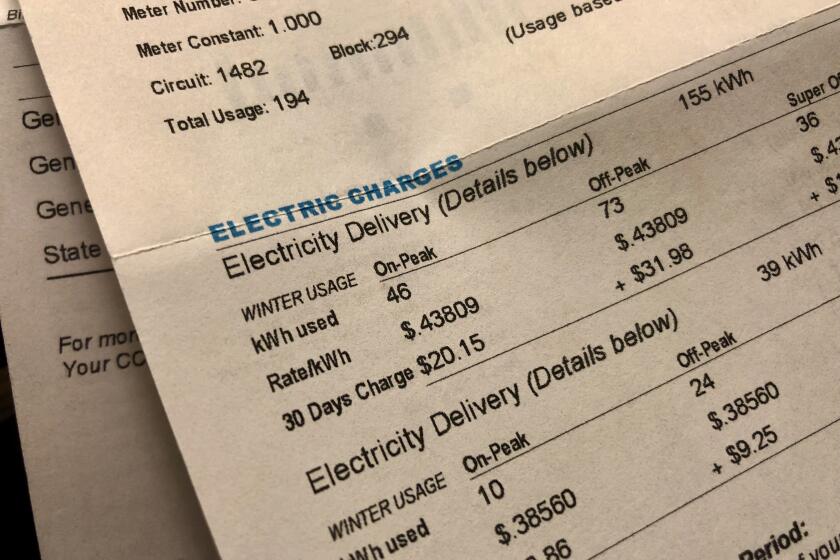
Here’s how many San Diego customers are behind on their utility bills
March 10, 2024

Biden hits the pause button on new LNG projects. It may cloud expansion plans at a Sempra project in Texas
Feb. 29, 2024
More in this section

National Business
Requiring ugly images of smoking’s harm on cigarettes won’t breach First Amendment, court says
A federal appeals court says a requirement that cigarette packs and advertising include graphic images demonstrating the effects of smoking does not violate the First Amendment

EU Commission proposes to impose tariffs on imports of grain from Russia
The European Union’s executive arm is proposing to member countries to impose tariffs on grain imports from Russia and Belarus

PIRCH, Oceanside-based luxury home appliance merchant, abruptly ‘pauses’ operations
PIRCH’s two San Diego County stores, in Solana Beach and Westfield UTC mall, announced they are now temporarily closed through the weekend, with future plans still unknown.
Antitrust lawsuits accuse major US sugar companies of conspiring to fix prices
Three antitrust lawsuits filed by food businesses in federal court in Minnesota this week accuse some of the largest U.S. sugar-producing companies of conspiring to fix prices

Need to ‘borrow’ miles from your kid to get that free flight? A big airline will let you do that
What if you don’t have enough airline miles for that free flight, but a family member does

Firing of Ohtani’s interpreter highlights how sports betting is still illegal in California
The firing of Shohei Ohtani’s interpreter by the Los Angeles Dodgers over allegations of illegal gambling and theft has highlighted an issue many outside of California don’t realize: Sports betting is still against the law in the nation’s most populous state
EJET Eco-Friendly Electric Motor & Drivetrain Yacht Tenders: New Model Announced
Boat engineering and design company EJET Electric Yacht Tenders has announced the development of its latest electric motor 9X yacht tender model.
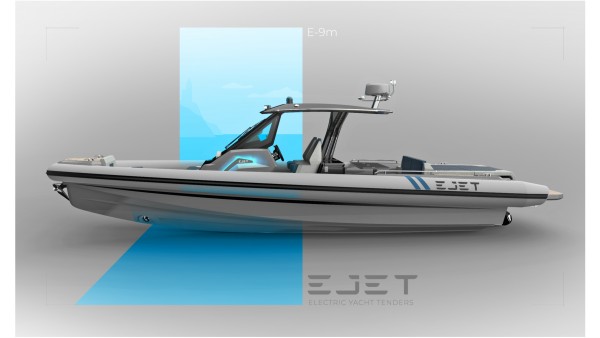
Ljubljana, Slovenia - March 21, 2024 —
Much like their highly acclaimed 4X tender, the upcoming 9X model sports EJET’s proprietary electric motor and drivetrain, going in line with founder Žiga Jarc’s mission of providing sustainable transportation options for yacht owners and guests. Both models will be available in the summer, with the 9X build slated for initial testing in July.
For more information, please visit https://ejet.co/
The announcement follows EJET’s recent appearance at the Boot Düsseldorf Boat Show. Having received the International Boat Industry’s Rising Star Award, the company revealed the development of its larger 9X model with the aim of promoting environmental responsibility within the boating industry.
Designed to be lightweight and compact without sacrificing output or speed, the new tender will be powered by a 220 kWh battery and a 300 kW motor, with an option to upgrade to 340 kW, ensuring 98% efficiency and making it suitable for sports such as water skiing. The boat’s V-shaped hull has been adjusted to accommodate EJET’s custom electric powertrain and is capable of withstanding turbulent waters and inclement weather conditions. Each boat is built with standard hydraulic steering mechanisms, along with the company’s military-grade jet system, allowing for easy maneuvering, reversing, and sudden stops in both low- and high-speed scenarios.
The 9X model will also feature a digital interface, which boaters will be able to use to select different driving modes and dynamics, view real-time GPS navigation and system data, and access the smart audio Bluetooth system. Additionally, amenities such as a hydraulic bathing platform, an electric grill, an ice maker, and a refrigerator will all be available as upgrade options for all 9X tenders.
About EJET Electric Yacht Tenders
Founded in 2016 by Žiga Jarc, EJET began with the goal of developing a zero-emissions electric yacht tender that did not compromise performance or safety. The company has since become a pioneer in electric propulsion systems and remains committed to future innovations in the boating industry. EJET tenders are currently the only products on the market with custom electric drivetrains.
EJET Electric Yacht Tenders, under the leadership of founder Žiga Jarc, is actively engaged in the development of its proprietary electric propulsion technology. The initiative is part of the company's broader commitment to innovation in high-performance, long-range powertrain technology for the marine industry. This effort underscores EJET's focus on delivering solutions characterized by their lightweight and compact design, high power output, and exceptional motor efficiency of up to 98%. With a specific emphasis on extending battery life, the company aims to set new benchmarks for what is achievable in electric propulsion within the boating sector.
“We built the company and the brand on three pillars: driver-centric experience, sustainability with clean electric power, and advanced electric propulsion technology,” says Ziga Jarc. “We cooperate with the best nautical partners to create unforgettable experiences for our customers.”
Interested parties can learn more by visiting https://ejet.co/contact-us/
Contact Info: Name: Žiga Jarc Email: Send Email Organization: EJET Electric Yacht Tenders Address: 16C Mokrška ulica, Ljubljana, Ljubljana 1000, Slovenia Phone: +386-41-688-998 Website: https://ejet.co/
Release ID: 89125030
If there are any errors, inconsistencies, or queries arising from the content contained within this press release that require attention or if you need assistance with a press release takedown, we kindly request that you inform us immediately by contacting [email protected] . Our reliable team will be available to promptly respond within 8 hours, taking proactive measures to rectify any identified issues or providing guidance on the removal process. Ensuring accurate and dependable information is our top priority.
More From Forbes
What candela’s electric hydrofoiling passenger ferry means for sustainable transportation.
- Share to Facebook
- Share to Twitter
- Share to Linkedin
The all-electric-powered Candela P-12 ferry flies over the water on hydrofoils
I would never say “I told you so,” but…now that Candela , the world’s leading producer of all-electric-powered hydrofoiling boats, has just closed the largest funding round in the company's history, I might be bold enough to say…”I’m not surprised.”
That’s because I’ve been closely following the development of this wonderfully smart company’s hydrofoiling boats since I test flew a P-7 near their small and efficient shop in Stockholm in 2021. So, I’m really not surprised they just raised over $25 million to expand production of their game-changing P-12 ferry. And since yacht building powerhouse Groupe Beneteau is a key partner in the largest fundraising round Candela has ever completed it appears Candela’s brand of tech-controled hydrofoiling is about to go global.
“Our investment perfectly aligns with Groupe Beneteau‘s ecological transition objectives, scaling up innovative solutions for more sustainable boating and unparalleled experiences,” says Bruno Thivoyon, CEO of Groupe Beneteau, the world's largest boat manufacturer (15 factories, 9 brands, and more than 8,000 yachts built annually) with a total revenue of over $1.5 billion in 2023. “Candela’s technology, enabling significantly more efficient electric vessels, will transform waterborne transport into its next sustainable phase.”
A Candela P-8 and P-12 underway near Stockholm, Sweden
“We couldn’t be more excited about having Groupe Beneteau on board,” says Gustav Hasselskog, Founder and CEO of Candela. “As the leading global boat company, their trust is a stamp of approval for our technology to transform waterborne transportation. We’re excited for the possibilities ahead."
Best High-Yield Savings Accounts Of 2024
Best 5% interest savings accounts of 2024.
The new investment round will help to scale up production to meet demand for the recently launched Candela P-12, the world’s first electric hydrofoil ferry. The P-12 is the first fast and long-range electric ferry on the market. Its efficient hydrofoil technology cuts lifetime emissions by 97.5% compared to diesel vessels, while simultaneously allowing operators to save up to 50% in operating costs. Since it generates minimal wake, the P-12 has been granted exemptions from speed limits, as for example on its maiden route in Stockholm, where it from July will cut travel times in half compared to road transport and legacy diesel vessels.
And it’s pretty obvious Hasselskog and company are on the right track. According to some projections the market for electric vessels is expected to be worth $14.2 Billion USD in 2030.
“We’ve spent years developing the technological maturity, and now we’re fit for scaling to commercial vessels. As in any industry, the fastest-scaling company will dominate the market,” says Hasselskog.
The Candela P-8 and P-12 hardly make a ripple as they fly over the water on computer-controlled ... [+] hydrofoils
Other backers in the round include longtime investors EQT Ventures , Ocean Zero LLC , and Kan Dela AB. The new investment brings total funding since Candela’s inception to over $75 million.
“EQT Ventures has steadfastly backed Candela's vision to accelerate the shift towards fossil fuel-free lakes and oceans since 2021. The launch of Candela's P-12 vessels signifies a watershed moment in sustainable transport", says Lars Jörnow, Partner at EQT Ventures.
The only question is: when will we see a P-12 ferry here in the US?

- Editorial Standards
- Reprints & Permissions
Candela’s electric ferries multiply as the startup lines up $25M in new funding
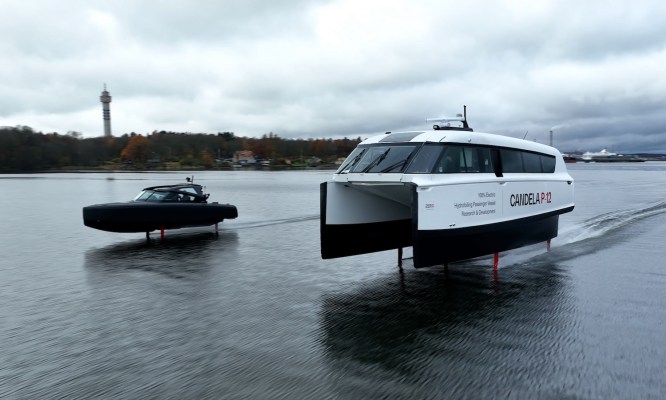
Electric boat maker Candela is approaching cruising speed with $25 million in new funding and the first commercial deployment of its new P-12 ferry in New Zealand. The company has global ambitions for its highly efficient boats and has completed and delivered dozens of them — which is a lot in this industry!
Candela has been slowly upping the size of its vessels for years, starting with the considerably smaller C-7 and C-8 (noting the length in meters) — of which, as of this week, they have now produced a total of 70. The P-12, a ferry design that can handle up to 30 passengers, made its debut late last year .
Just last week, the P-12 was given its first assignment: ferry people around New Zealand’s Lake Manapōuri , a scenic destination but also, more importantly, the site of the country’s largest hydroelectric power station. And now staff at that station can get to work via clean-running boat rather than driving, which the companies estimate will save around 240 tons of emissions per year. It’s a start, and it will help keep the lake clean and quiet.
International interest in these boats is also evident in the participation of Groupe Beneteau, a more than century-old boating company that makes thousands of vessels yearly, in the funding round. Groupe Beneteau CEO Bruno Thivoyon expressed in the press release that investing in Candela makes sense as part of the company’s “ecological transition objectives, scaling up innovative solutions for more sustainable boating.”
Many legacy boating companies are embracing electric engines and next-generation tech; I spoke with the head of another major manufacturer, Brunswick’s Dave Foulkes, at CES about it. He said that the collaborations are fruitful because the small, growing companies need the income and reach, while the larger ones need ready-to-deploy tech. Like any other industry, you have to know when to buy and when to build, and big boating companies are happy to buy — or invest.
Candela’s boats use hydrofoils with electric engines mounted on the bottom to effectively fly above the surface of the water once they get past a certain speed, vastly reducing energy consumption — historically and understandably a sticking point for electric boating. The approach does necessitate a powerful autopilot to keep it balanced, and despite their assurances, I wonder about how they’d handle log collisions, but overall the advantages seem to outweigh the drawbacks.
I drove one over the summer in Seattle (watching closely for logs, rather common in Elliott Bay) and wished they would replace the gas-chugging fast passenger ferries with P-12s. Candela isn’t the only one pursuing this market, either; Navier is also attempting to woo coastal communities with the draw of quiet, energy-efficient transit and is currently shuttling Stripe employees around the Bay Area . And while Zin Boats has been quiet for some time, they are also nailing down markets for the next version of their vessel.
The $25 million round was led, as mentioned, by Beneteau, with participation from EQT Ventures, Ocean Zero LLC, and Kan Dela AB.
Breaking rules, setting trends
- Open search box
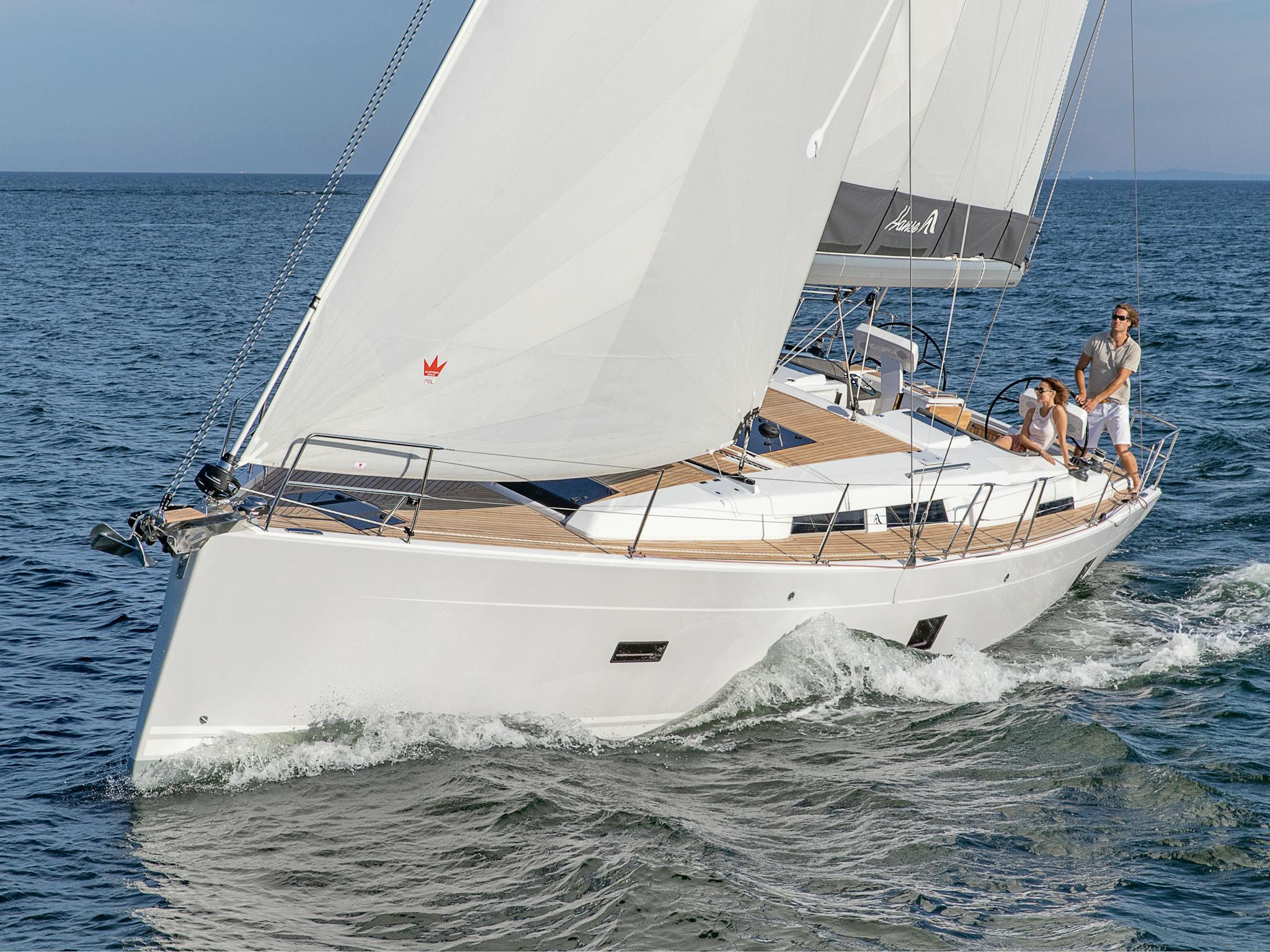
Legacy Model: Hanse 458
The new Hanse 458 is the yacht for all of those who set trends. With a pioneering design and the most thrilling performance in its class. With an exquisite interior and an exceptionally diverse range of customization options. The Hanse 458 caters to the highest demands on contemporary style and quality of life. Let yourself be amazed by excellence across 45 feet (ca. 14 m).
Exterior design
Our yachts combine excellent nautical characteristics, easy handling and breathtaking design.
Interior design
In our interiors you will find unique solutions that provide the ultimate in comfort and storage, a home-like experience and astonishing design.
The most important information about your Hanse.
Keep the most important information about your yacht at hand and read it even without the internet whenever you want to!
No documents found
Explore current Hanse models
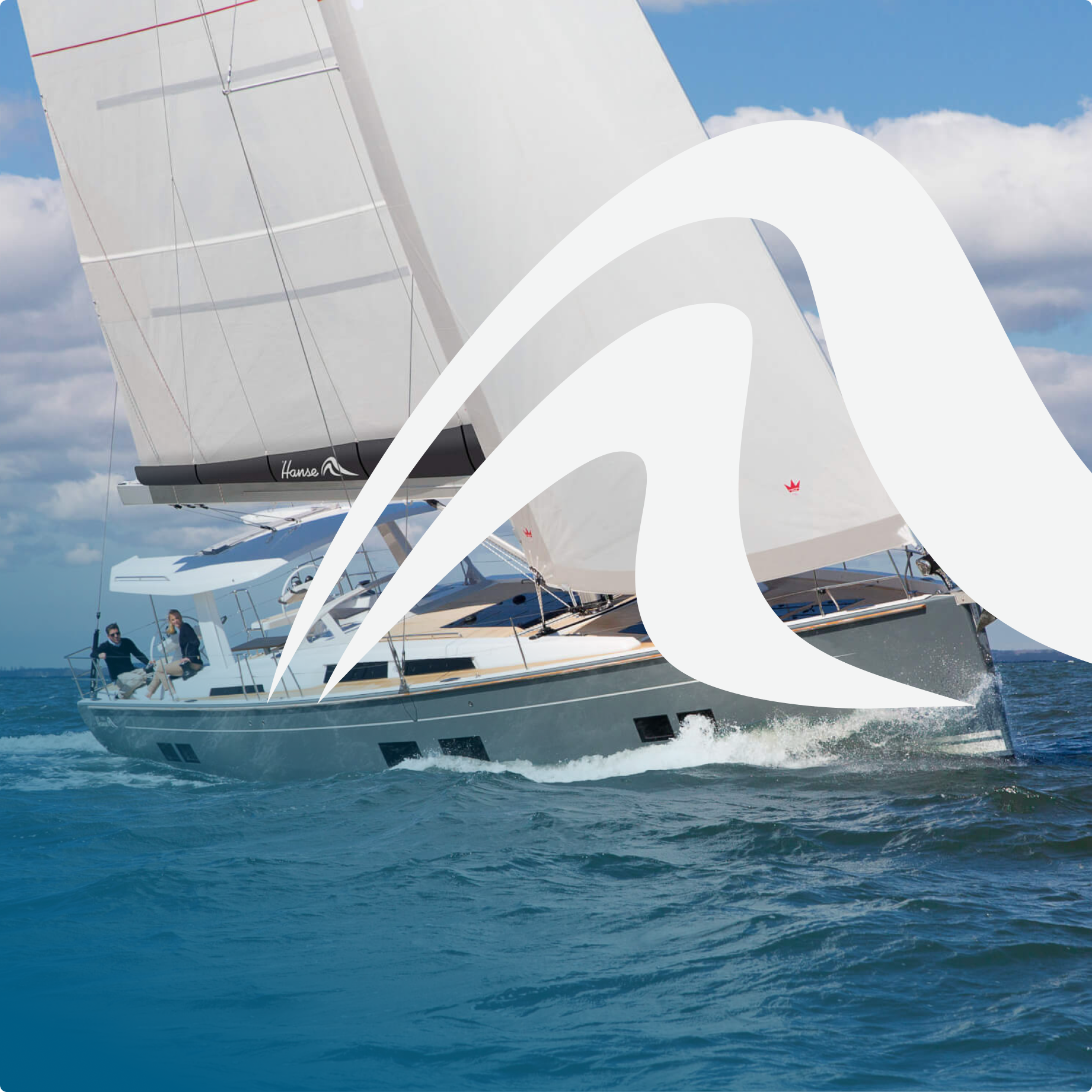
Customise your dream yacht in seconds!

Seize the moment - schedule your appointment today.

Friday 11 April 2014
Moscow metro - spirit of a city (e.p).

No comments:
Post a comment.

Turn Your Curiosity Into Discovery
Latest facts.

Facts About The Research in Epithalon Properties Overview Analysis

How To Protect Children From Junk Food Marketing
40 facts about elektrostal.
Written by Lanette Mayes
Modified & Updated: 02 Mar 2024
Reviewed by Jessica Corbett

Elektrostal is a vibrant city located in the Moscow Oblast region of Russia. With a rich history, stunning architecture, and a thriving community, Elektrostal is a city that has much to offer. Whether you are a history buff, nature enthusiast, or simply curious about different cultures, Elektrostal is sure to captivate you.
This article will provide you with 40 fascinating facts about Elektrostal, giving you a better understanding of why this city is worth exploring. From its origins as an industrial hub to its modern-day charm, we will delve into the various aspects that make Elektrostal a unique and must-visit destination.
So, join us as we uncover the hidden treasures of Elektrostal and discover what makes this city a true gem in the heart of Russia.
Key Takeaways:
- Elektrostal, known as the “Motor City of Russia,” is a vibrant and growing city with a rich industrial history, offering diverse cultural experiences and a strong commitment to environmental sustainability.
- With its convenient location near Moscow, Elektrostal provides a picturesque landscape, vibrant nightlife, and a range of recreational activities, making it an ideal destination for residents and visitors alike.
Known as the “Motor City of Russia.”
Elektrostal, a city located in the Moscow Oblast region of Russia, earned the nickname “Motor City” due to its significant involvement in the automotive industry.
Home to the Elektrostal Metallurgical Plant.
Elektrostal is renowned for its metallurgical plant, which has been producing high-quality steel and alloys since its establishment in 1916.
Boasts a rich industrial heritage.
Elektrostal has a long history of industrial development, contributing to the growth and progress of the region.
Founded in 1916.
The city of Elektrostal was founded in 1916 as a result of the construction of the Elektrostal Metallurgical Plant.
Located approximately 50 kilometers east of Moscow.
Elektrostal is situated in close proximity to the Russian capital, making it easily accessible for both residents and visitors.
Known for its vibrant cultural scene.
Elektrostal is home to several cultural institutions, including museums, theaters, and art galleries that showcase the city’s rich artistic heritage.
A popular destination for nature lovers.
Surrounded by picturesque landscapes and forests, Elektrostal offers ample opportunities for outdoor activities such as hiking, camping, and birdwatching.
Hosts the annual Elektrostal City Day celebrations.
Every year, Elektrostal organizes festive events and activities to celebrate its founding, bringing together residents and visitors in a spirit of unity and joy.
Has a population of approximately 160,000 people.
Elektrostal is home to a diverse and vibrant community of around 160,000 residents, contributing to its dynamic atmosphere.
Boasts excellent education facilities.
The city is known for its well-established educational institutions, providing quality education to students of all ages.
A center for scientific research and innovation.
Elektrostal serves as an important hub for scientific research, particularly in the fields of metallurgy, materials science, and engineering.
Surrounded by picturesque lakes.
The city is blessed with numerous beautiful lakes, offering scenic views and recreational opportunities for locals and visitors alike.
Well-connected transportation system.
Elektrostal benefits from an efficient transportation network, including highways, railways, and public transportation options, ensuring convenient travel within and beyond the city.
Famous for its traditional Russian cuisine.
Food enthusiasts can indulge in authentic Russian dishes at numerous restaurants and cafes scattered throughout Elektrostal.
Home to notable architectural landmarks.
Elektrostal boasts impressive architecture, including the Church of the Transfiguration of the Lord and the Elektrostal Palace of Culture.
Offers a wide range of recreational facilities.
Residents and visitors can enjoy various recreational activities, such as sports complexes, swimming pools, and fitness centers, enhancing the overall quality of life.
Provides a high standard of healthcare.
Elektrostal is equipped with modern medical facilities, ensuring residents have access to quality healthcare services.
Home to the Elektrostal History Museum.
The Elektrostal History Museum showcases the city’s fascinating past through exhibitions and displays.
A hub for sports enthusiasts.
Elektrostal is passionate about sports, with numerous stadiums, arenas, and sports clubs offering opportunities for athletes and spectators.
Celebrates diverse cultural festivals.
Throughout the year, Elektrostal hosts a variety of cultural festivals, celebrating different ethnicities, traditions, and art forms.
Electric power played a significant role in its early development.
Elektrostal owes its name and initial growth to the establishment of electric power stations and the utilization of electricity in the industrial sector.
Boasts a thriving economy.
The city’s strong industrial base, coupled with its strategic location near Moscow, has contributed to Elektrostal’s prosperous economic status.
Houses the Elektrostal Drama Theater.
The Elektrostal Drama Theater is a cultural centerpiece, attracting theater enthusiasts from far and wide.
Popular destination for winter sports.
Elektrostal’s proximity to ski resorts and winter sport facilities makes it a favorite destination for skiing, snowboarding, and other winter activities.
Promotes environmental sustainability.
Elektrostal prioritizes environmental protection and sustainability, implementing initiatives to reduce pollution and preserve natural resources.
Home to renowned educational institutions.
Elektrostal is known for its prestigious schools and universities, offering a wide range of academic programs to students.
Committed to cultural preservation.
The city values its cultural heritage and takes active steps to preserve and promote traditional customs, crafts, and arts.
Hosts an annual International Film Festival.
The Elektrostal International Film Festival attracts filmmakers and cinema enthusiasts from around the world, showcasing a diverse range of films.
Encourages entrepreneurship and innovation.
Elektrostal supports aspiring entrepreneurs and fosters a culture of innovation, providing opportunities for startups and business development.
Offers a range of housing options.
Elektrostal provides diverse housing options, including apartments, houses, and residential complexes, catering to different lifestyles and budgets.
Home to notable sports teams.
Elektrostal is proud of its sports legacy, with several successful sports teams competing at regional and national levels.
Boasts a vibrant nightlife scene.
Residents and visitors can enjoy a lively nightlife in Elektrostal, with numerous bars, clubs, and entertainment venues.
Promotes cultural exchange and international relations.
Elektrostal actively engages in international partnerships, cultural exchanges, and diplomatic collaborations to foster global connections.
Surrounded by beautiful nature reserves.
Nearby nature reserves, such as the Barybino Forest and Luchinskoye Lake, offer opportunities for nature enthusiasts to explore and appreciate the region’s biodiversity.
Commemorates historical events.
The city pays tribute to significant historical events through memorials, monuments, and exhibitions, ensuring the preservation of collective memory.
Promotes sports and youth development.
Elektrostal invests in sports infrastructure and programs to encourage youth participation, health, and physical fitness.
Hosts annual cultural and artistic festivals.
Throughout the year, Elektrostal celebrates its cultural diversity through festivals dedicated to music, dance, art, and theater.
Provides a picturesque landscape for photography enthusiasts.
The city’s scenic beauty, architectural landmarks, and natural surroundings make it a paradise for photographers.
Connects to Moscow via a direct train line.
The convenient train connection between Elektrostal and Moscow makes commuting between the two cities effortless.
A city with a bright future.
Elektrostal continues to grow and develop, aiming to become a model city in terms of infrastructure, sustainability, and quality of life for its residents.
In conclusion, Elektrostal is a fascinating city with a rich history and a vibrant present. From its origins as a center of steel production to its modern-day status as a hub for education and industry, Elektrostal has plenty to offer both residents and visitors. With its beautiful parks, cultural attractions, and proximity to Moscow, there is no shortage of things to see and do in this dynamic city. Whether you’re interested in exploring its historical landmarks, enjoying outdoor activities, or immersing yourself in the local culture, Elektrostal has something for everyone. So, next time you find yourself in the Moscow region, don’t miss the opportunity to discover the hidden gems of Elektrostal.
Q: What is the population of Elektrostal?
A: As of the latest data, the population of Elektrostal is approximately XXXX.
Q: How far is Elektrostal from Moscow?
A: Elektrostal is located approximately XX kilometers away from Moscow.
Q: Are there any famous landmarks in Elektrostal?
A: Yes, Elektrostal is home to several notable landmarks, including XXXX and XXXX.
Q: What industries are prominent in Elektrostal?
A: Elektrostal is known for its steel production industry and is also a center for engineering and manufacturing.
Q: Are there any universities or educational institutions in Elektrostal?
A: Yes, Elektrostal is home to XXXX University and several other educational institutions.
Q: What are some popular outdoor activities in Elektrostal?
A: Elektrostal offers several outdoor activities, such as hiking, cycling, and picnicking in its beautiful parks.
Q: Is Elektrostal well-connected in terms of transportation?
A: Yes, Elektrostal has good transportation links, including trains and buses, making it easily accessible from nearby cities.
Q: Are there any annual events or festivals in Elektrostal?
A: Yes, Elektrostal hosts various events and festivals throughout the year, including XXXX and XXXX.
Was this page helpful?
Our commitment to delivering trustworthy and engaging content is at the heart of what we do. Each fact on our site is contributed by real users like you, bringing a wealth of diverse insights and information. To ensure the highest standards of accuracy and reliability, our dedicated editors meticulously review each submission. This process guarantees that the facts we share are not only fascinating but also credible. Trust in our commitment to quality and authenticity as you explore and learn with us.
Share this Fact:
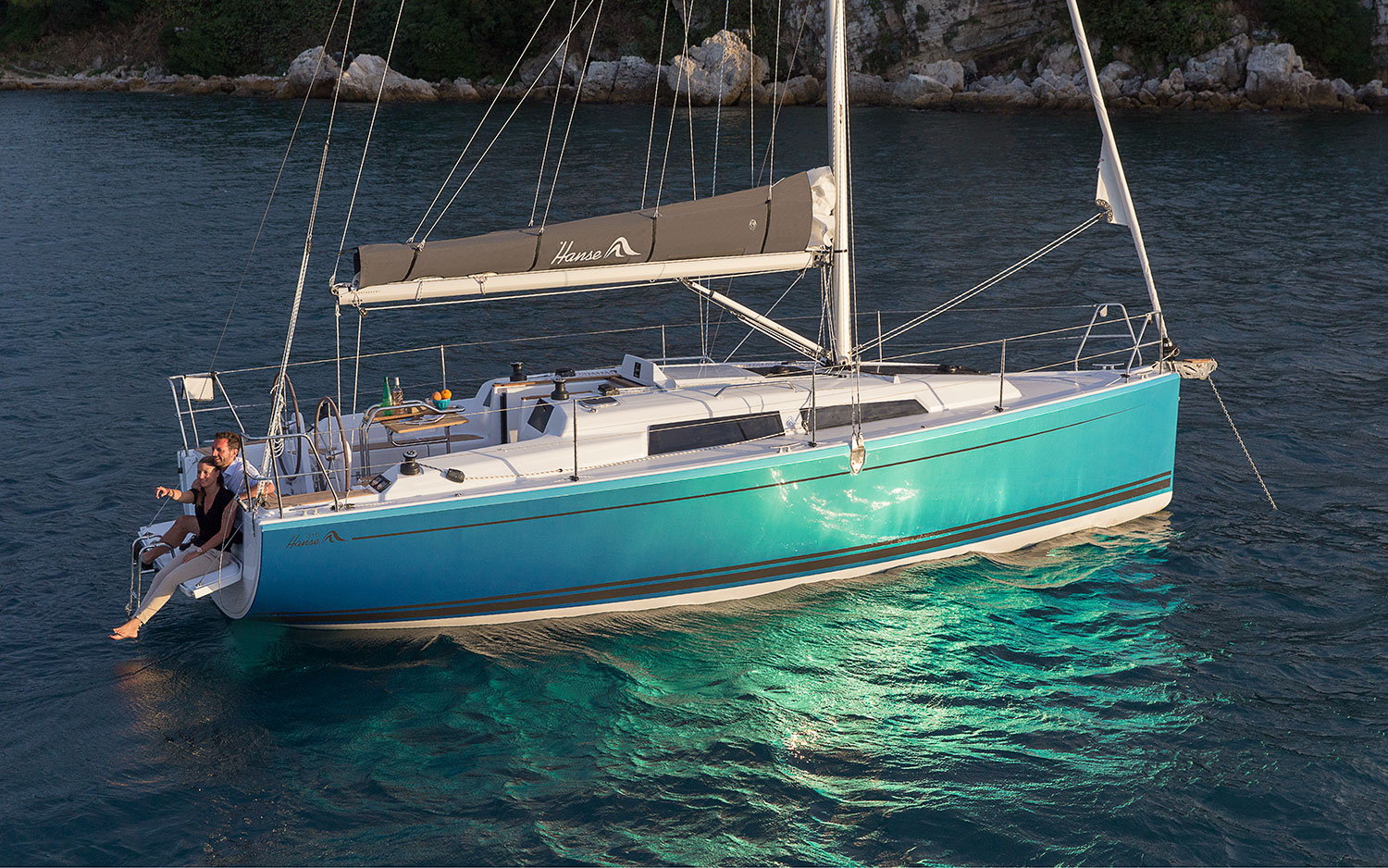
Apr 24, 2018. Hanse's E-motion electric rudder drive represents a true breakthrough in auxiliary propulsion for saiboats. When news that Hanse Yachts had launched a new form of electric-powered yacht first broke in the winter of 2016, it was widely reported. After all, Hanse is one of the world's biggest builders of sailing boats, so this ...
For the first time, the Hanse 410 offers optional electric propulsion with an enormous range of up to 55 nautical miles. This means that even without wind, most destinations can be reached in a climate-friendly way. Hanjo Runde, CEO of HanseYachts : " This innovative electric drive is an important step towards making our product range even ...
The E-MOTION RUDDER DRIVE is a revolution in Yachting.The Hanse 315 e-motion rudder drive was developed in cooperation with the partners Jefa and Torqeedo an...
Hanse 410. Step into the future. Redefining elegance on the seas, her optimized hull featuring chines at the bow and stern provides the uncompromising performance and easy sailing typical for Hanse. Optional electric propulsion and other sustainability features minimise her environmental footprint. And up to three expansive cabins and the ...
The world's third largest boatbuilder, Hanse Yachts, is perhaps the most advanced - offering its entry-level Hanse 315 with an electric rudder-drive option. The system takes up less space than ...
For the first time, the Hanse 410 introduces an optional electric propulsion system, boasting a remarkable range of up to 55 nautical miles. For even greater independence, a fuel cell delivers emission-free energy. Or, turn to the proven power of solar technology to keep essential appliances running on board without burning any fuel.
Its innovative hull shape ensures unrestricted performance. With its unprecedented 51-foot dimensions, the Hanse 510 offers the largest dinghy garage in its class. The spacious cockpit is the perfect place to relax with family and friends. From the generous owner's cabin to the salon to the comfortable crew cabin, this yacht offers exquisite ...
Oct 31, 2016. In Hanse's innovative Rudder Drive system, a Torqeedo electric motor embedded in the boat's rudder provides propulsion. The system will make its debut on the new Hanse 315 e-motion. It was developed by Hanse in conjunction with fellow German company Torqeedo, a leader in electric propulsion, and Jefa, the Danish steering ...
Hanse Yachts introduces E-Motion Rudder Drive - an interesting propulsion type, with a special folding propeller….. An electric engine and a folding propeller have been installed into the rudder shaft, replacing the combination of diesel engine and sail drive. As a result, the propeller thrust is in line with the rudder position. This enables turning in the smallest circles or rotating ...
How it works the new electric propulsion system created by Hanse Yachts and Torqeedo.
Hanse returned to Berret-Racoupeau, who also designed the 460 (a Top 10 Best Boats 2023 winner), to create the 510, and the result can leave you lingering over the lines. Starting with an aggressive, wave-piercing reverse bow, the relatively flat sheer and low deckhouse give this boat a fast, agreeably sharkish look even sitting still, despite ...
Controlling the boat in itself is so much easier anyway, especially if - as most owners of the Hanse 460 will - you upgrade to electric winches, electric in-mast reefing and electric furling ...
World launch at the Hanseboot Hamburg. For the first time, the new propulsion system will be presented installed in the Hanse 315 e-motion rudder drive at the International Boat Show Hanseboot 2016 in Hamburg. We are looking forward to welcoming you to the Hanse Yachts booth (hall 6, booth C108) on Sunday, October 30, 2016 at 2 pm. PDF Download.
Hanse 315. Voted European Yacht of the Year right after its launch, the Hanse 315 is the epitome of what makes a yacht great. With its perfect sailing characteristics and easy handling, the 31-foot entry-level model is easy to maneuver. Two staterooms, a spacious salon with L-shaped pantry and the largest cockpit in its class provide true comfort.
Hanse. Hanse is a yacht brand that currently has 310 yachts for sale on YachtWorld, including 95 new vessels and 215 used yachts, listed by experienced yacht brokers mainly in the following countries: United States, Germany, Spain, Greece and Croatia. The selection of models featured on YachtWorld spans a spectrum of sizes and lengths ...
The Berret-Racoupeau-designed Hanse 460 turned heads as a 2022 Boat of the Year nominee with a fresh take on comfort and volume but with an eye better sailing performance. The second model in the new range designed by the Berret-Racoupeau team, the Hanse 510 is set to make its US premiere at the 2023 Annapolis Sailboat Show—again as a Boat of the Year contender.
Hanse Yachts. Hanse 315, Torqeedo e-motion rudder drive, Jeremy Rodgers Limited. Contessa 32 new build, Beta/Hybrid ... (also with 2 x 10 kW). Salona 46, also known as the "almost perfect electric sailboat" in this Sailing Uma video. Picture from salonayachts.com. Spirit Yachts. SPIRIT 44CR(E), Oceanvolt 15 kW. Viator Marine. Viator ...
The nation's first all-electric tug boat has docked at the Port of San Diego and expects to begin emissions-free operations in about a month. Operated by Crowley Maritime Corporation, the 82 ...
Boat engineering and design company EJET Electric Yacht Tenders has announced the development of its latest electric motor 9X yacht tender model. Ljubljana, Slovenia - March 21, 2024 — Much like ...
Check out this Used 2024 Hanse 418 for sale in Newport, RI 02840. View this Cruisers and other Sail boats on boattrader.com. ... all while enjoying the elegance and style of the very well-designed HANSE Yachts 418. Feel right at home on the open seas with the trademark fast hull line and impressive sail plan, crafted by the world-renowned yacht ...
The all-electric-powered Candela P-12 ferry flies over the water on hydrofoils. Candela. I would never say "I told you so," but…now that Candela, the world's leading producer of all ...
Boat Review: Hanse 315. The baby of the Hanse 5 series, the 315, looks surprisingly serious at the dock. She's got an almost predatory look, even compared to any 50-footers that might be in the area—which seems funny until she gets out on the water and kicks some booty. Between her easy-sailing rig that cuts down on tacking drama and her ...
Electric boat maker Candela is approaching cruising speed with $25 million in new funding and the first commercial deployment of its new P-12 ferry in New Zealand. The company has global ambitions ...
Hanse 458. The new Hanse 458 is the yacht for all of those who set trends. With a pioneering design and the most thrilling performance in its class. With an exquisite interior and an exceptionally diverse range of customization options. The Hanse 458 caters to the highest demands on contemporary style and quality of life.
Find company research, competitor information, contact details & financial data for BETA GIDA, OOO of Elektrostal, Moscow region. Get the latest business insights from Dun & Bradstreet.
It has been over a year since first being introduced to Limerick based 4-piece Moscow Metro* through their wonderful debut double-A side containing the tracks "Spirit of a City" and "Cosmos" for free, which sounded near perfect in spite of the band only being together for a few months at the time of recording. Now fast-forward 12 months, and as a result of the initial love for the band, they ...
Known as the "Motor City of Russia." Elektrostal, a city located in the Moscow Oblast region of Russia, earned the nickname "Motor City" due to its significant involvement in the automotive industry.. Home to the Elektrostal Metallurgical Plant. Elektrostal is renowned for its metallurgical plant, which has been producing high-quality steel and alloys since its establishment in 1916.
Local band Moscow Metro (featuring Barry McNulty, Sean Corcoran, Dylan Casey & Alan Holmes) will perform on the Cosby Stage at 12.55pm on Saturday at the Electric Picnic.

IMAGES
VIDEO
COMMENTS
To sail a catamaran upwind, maintain high speeds, center the mainsheet, limit angles to 45-60°, lose unnecessary weight, upgrade to Kevlar sails and daggerboards. To sail a catamaran downwind, maintain 160-170°, use asymmetrical spinnakers, reef when winds exceed 15 knots, and jibe. Downwind gusts can help a catamaran surf down waves ...
Although sailing downwind in the trades in a cruising boat has its challenges, it is a relatively pleasant and fairly easy experience on a catamaran. There is a more-or-less continuous flow of air across the Atlantic called the trade winds. Because the Earth is warmer at the equator and colder at the poles, and because of Earth's rotation ...
Gennaker or screecher. The faster a boat sails, the more time it spends with the apparent wind forward of the beam, 90° or less. As a result, the standard downwind sail used by a true race boat ...
How do you get the best out of a cruising cat downwind and how do you gybe safely? Multihull expert Nigel Irens explains Become a FREE SUBSCRIBER to Yachtin...
This allows us to sail at a deeper downwind angle (135 - 160). Instead of approximately 12 lateral feet between the tack and the clew (half the width of the boat), we are now using the full width of the boat to open the headsail even wider. While the sail is still furled, we use a soft shackle to attach a low friction ring to the bow cleat.
Sailing downwind in a catamaran can be challenging because the two hulls can tend to act as sails, catching wind and pushing the boat to one side, making it difficult to keep it on course. To sail downwind in a catamaran: Keep the sails trimmed - The force of the wind should be balanced across the two sails.
Before we can look at the gybe we have to look at the correct downwind sailing angles, before we can look at that we need to understand how apparent wind wor...
Sailing downwind in a cruising cat is not much different than any other sailboat. In this post two conditions, one of heavy wind 20 plus knots and one of light wind say 10 knots or less, are explained. Strong Winds When the wind is strong, 20 knots plus, it's usually much safer to "heat up"…
To compensate, catamaran sailors. FULL BORE. Sailing downwind on a three-sail reach, the mainsail is sheeted almost on the centerline due to the apparent wind angle and the speed of the catamaran. The helmsman keeps maximum control by holding the tiller bar and letting the tiller extension trail.
The main difference from monohull sailing is that fast catamarans bring the Apparent Wind farther forward, so that for a lot of downwind sailing the sails are set as though for a beam reach. Fast cruising multihulls are often seen flying asymmetrical spinnakers with the headsail up, which is an advantage for racing.
A poled-out headsail is consistently rated the most stable and stress-free downwind rig by ARC crews. It has a wide angle of effectiveness, from a dead run up to about 140°. From a safety ...
In this episode, we will delve into the art of sail trimming when sailing downwind. Whether you're a seasoned sailor or just beginning to explore the boating...
10 Catamaran Sailing Tips. Here are some tips on how to sail your catamaran: 1. Always keep the boat sailing downwind. Sailing downwind prevents pounding and slapping sounds that slow down the boat. When the low bridge deck slaps on the undercarriage of the boat, it causes annoying sounds. Making sure that you are sailing downwind as much as ...
The knowledgeable sailor will position their catamaran to avoid them or will at least be able to sail on the back-side or downwind quadrant of low-pressure systems. Once you have learned your boat and experienced a gale or two, sailing in these conditions may soon provoke some of your fondest sailing memories.
The deeper downwind angle you sail, the less the apparent wind. And vice versa. Most catamarans have shrouds placed far aft, and no backstay. That means the boom cannot swing out as far as on typical monohulls, and therefore the jibe angle is smaller. The boat has a narrower range of downwind sailing angles.
Sailing downwind in a catamaran presents a different set of challenges compared to upwind sailing. Mastering downwind sail techniques allows you to harness the wind efficiently, maintain control, and achieve the desired speed. One popular downwind sail technique for catamarans is using a spinnaker. Asymmetrical spinnakers are particularly ...
Here are some key points to consider about sails and rigging: 1. Sail design: The design of the sails, including their size, shape, and material, plays a significant role in the catamaran's performance. High-performance racing catamarans often have larger, more efficient sails that generate greater speed. 2.
Symmetric spinnakers. Symmetrical spinnakers have been around for a long time and continue to be a valid choice for cruising sailors. The symmetrical shape of the sail lends them to wind angles of 165 degrees or more. If you're going to spend a lot of time running, it's a great option.
Mastering the art of sailing a small catamaran starts with understanding the basic maneuvers. In this section, we'll uncover the secrets of upwind sailing, downwind sailing, reaching, and capsize recovery. Get ready to glide through the water with precision and agility as we explore the techniques and skills necessary to maneuver your small ...
Catamarans: Faster on a reach and downwind due to their wide beam. However, they may not point as high into the wind as monohulls. However, they may not point as high into the wind as monohulls. 5.
Downwind: The point of sail when the wind blows from aft of the boat's beam Drag: ... A boat with two hulls is also known as a catamaran and a boat with three hulls is knows as a trimaran. Nautical mile: The unit of geographical distance used on saltwater charts; one nautical mile equals 6,076 feet or 1.15 statute miles. Therefore, one statute ...
680 m² of canvas downwind, 460 m² upwind, the Sunreef 88 DD is a real sailboat making 7 knots in just 10 knots of wind ... The choice of a sailing catamaran was a logical one: the space, stability, low draft, panoramic view and the economical running are irrefutable arguments for those who want XXL-sized comfort. ...
So, when things go wrong, the repercussions can be intense. As a result, says Jenne, a big part of learning to sail is learning to overcome fear. "Sailing will always be full of the unknown ...
Boatmarket - sale of Fountaine Pajot motor catamarans in Moscowhttp://www.boatmarket.ru/
Apr 24, 2018. Hanse's E-motion electric rudder drive represents a true breakthrough in auxiliary propulsion for saiboats. When news that Hanse Yachts had launched a new form of electric-powered yacht first broke in the winter of 2016, it was widely reported. After all, Hanse is one of the world's biggest builders of sailing boats, so this .....
Boatmarket - sale of Fountaine Pajot motor catamarans in Moscowhttp://www.boatmarket.ru/